
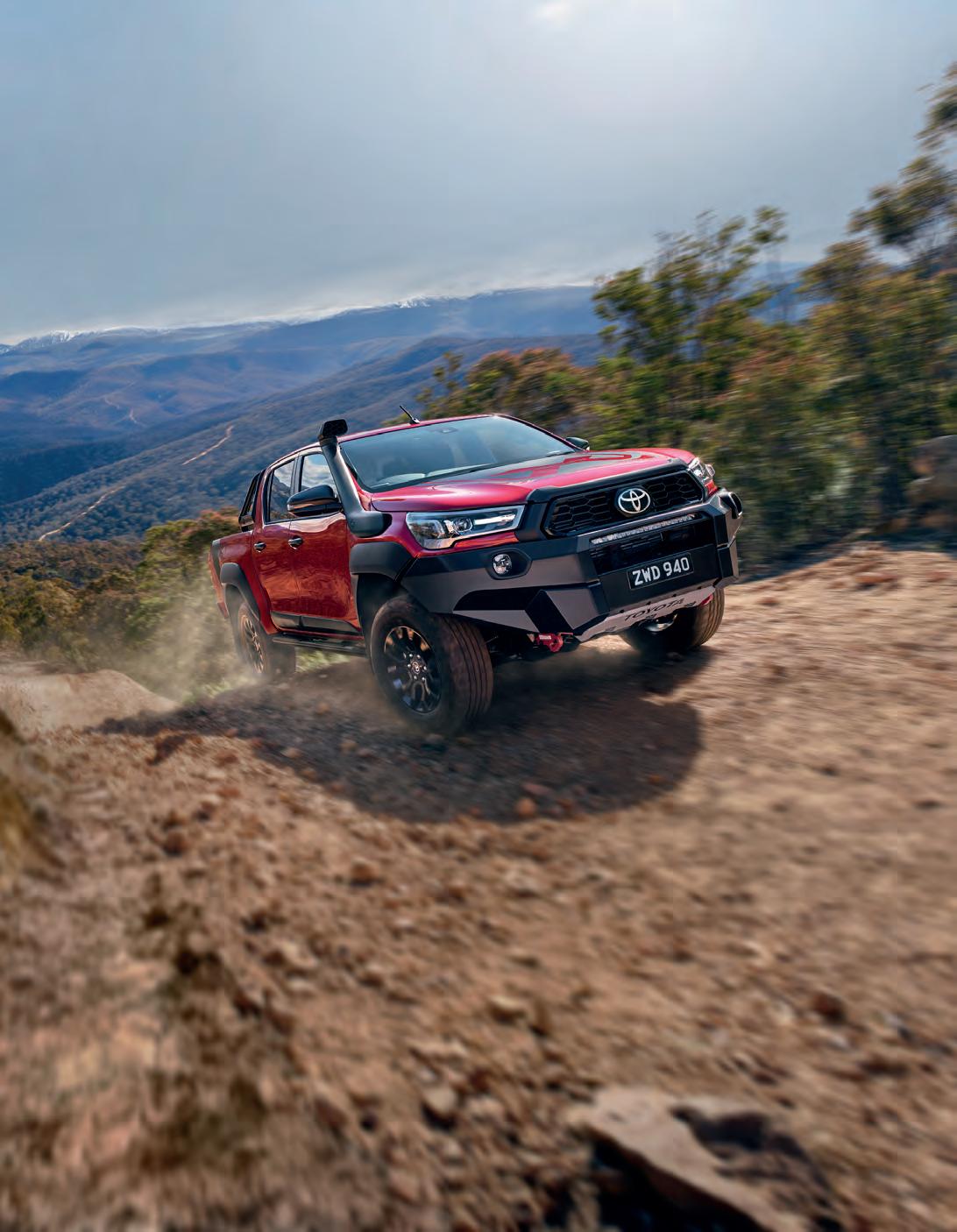
RRP $ 9.95 Print Post Approved 602669/00784 BREMER BAY TIPS FOR TRAVELLING SOLO THE LANDCRUISER LEGEND NIGHTSCAPE PHOTOGRAPHY IN THE FOOTSTEPS OF JOHN FORREST CRUISING THE KIMBERLEY BENDLEBY RANGES WE TEST THE LAND ROVER DEFENDER PLUS 118th EDITION Winter 2021 a HEMA HX-1 NAVIGATOR and see YOUR PHOTO ON OUR NEXT COVER! win



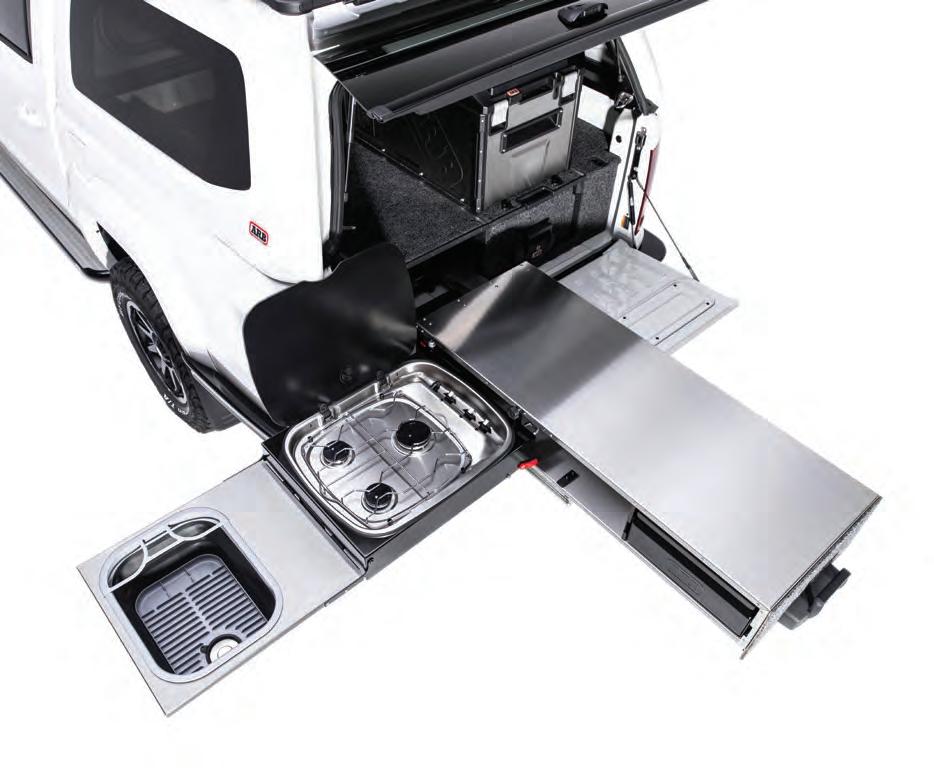




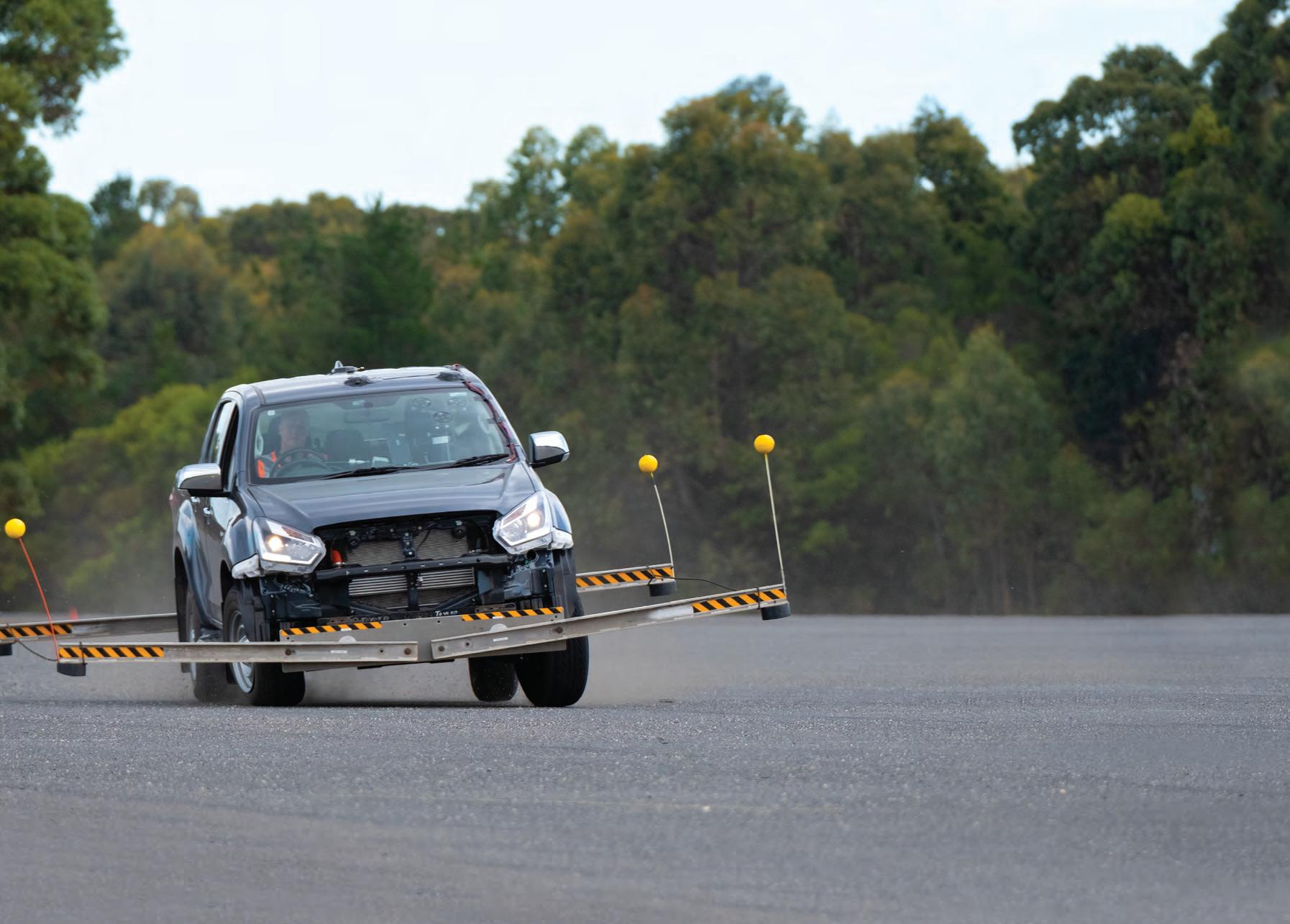








MAN IRONCLAD WARRANTY 2year 40,000 Prices do not include freight or fitting and are subject to change without notice. www.ironman4x4.comW4WDDPS130521 UPGRADE UPGRADE KEEP IT LEGAL KEEP IT SAFE









Australian certified GVM upgrades Designed and tested for contractors and tradesmen who carry tools and equipment that exceed original manufacturers or legal load limits, or fit a bull bar, winch and long range fuel tank and still have load carrying capacity. The Ironman 4x4 GVM Upgrade will assist in satisfying OH&S, insurance and road transport regulation requirements. Ironman 4x4 has conducted all required testing to ensure complete integration with all safety systems and requirements as well as compliance to Federal laws. LEGALLY CARRY MORE PAYLOAD To suit: Ford Ranger PX / PXII / PXIII • Holden RG Colorado 2012 - 2020 • Isuzu D-Max 2012 - 2019 Toyota Hilux 2005 - 2015 • Toyota Hilux 2015+ Toyota Landcruiser 200 Series 2007+ • Toyota Landcruiser 78/79 Series 2007+ New and now available to suit: Isuzu D-Max MY20+ • Mazda BT50 2020+ • Suzuki GJ Jimny 2018+ TESTED AND APPROVED


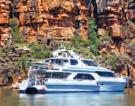


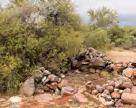
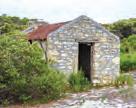

DESTINATIONS CONTENTS Chasing Waterfalls and Adventure Along the Kimberley Coast Grant and Linda cruise the Kimberley's spectacular coastline 10 Legging it from Lockdown Part 2 Susie and Nick continue their Kimberley adventure 20 The Beauty of Bremer Bay Jon experiences the beauty and the fury of this stunning region 44 A Pat on the Back at the Bendleby Ranges David takes us to one of South Australia's ripper 4WD destinations 62 In the Footsteps of John Forrest Phil follows John Forrest's expedition from north of Wiluna to Alexander Spring 70 Finding Fanny Ashley discovers another south coast gem 110 EDITION 118 WINTER 2021 for your chance to win a HEMA HX-1 NAVIGATOR & see YOUR PHOTO ON OUR NEXT COVER ... go to page 105 Valued at $738.95 4 Western 4W Driver #118

FEATURES REGULARS 4Thought 7 Wildtrax 119 What's in a Name 122 The Things You See 126 Bindon's Lore 128 Let's Go Geo-Touring 132 Nuts and Bolts 140 Outback Survival 145 Fishy Business 149 Women in 4W Driving 152 Gear to Go Camping 155 Clewed Up 158 Goings On 161 Track Care WA News 163 4WD Club Focus NEW! 171 The People We Meet 174 Capture the Moment 177 Photography Tips and Tricks 178 The Travelling Photographer 179 Art of 4WDs 181 Now We're TAWKing! 182 Are We There Yet? 185 Subscriptions 188 Keep me handy! 189 Silly Snaps 190 Supplier Directory 191 Capable of Great Things Ray Cully test drives the Land Rover Defender 110 32 The LandCruiser Legend Toyota Troop Carrier 54 Going Solo Tips for hitting the tracks safely as a single vehicle 78 Nightscape Photography What you need and how to use it 86 Is Less, More? Update on the Red-Dirt low-mod Cruiser 94 My 4WD My Story Todd's 120 series Prado 102 Lenny the LandCruiser 106 Spotted in the Wild Bin Chicken 109 Talk to the Experts Off Road Equipment 114 Red Dirt and Horses Marble Bar Cup 116 Improved Departure Angle Milford tow bar review 117 It Started with an Ink Bottle Farewell to Ian Elliot 124 Western 4W Driver #118 5
Premium
ABN
John
616
Northbridge
Box 50, Northbridge
6865
Phone: (08) 9291 8303 admin@western4wdriver.com.au www.western4wdriver.com.au

Publishers
70
133 870 26
Street,
WA 6003 PO
WA
Editors Chris and Karen Morton Advertising Chris Morton Natalie Du Preez Graphic Design Karen Morton Administration Chris Morton Steve Larcombe Christine Arnasiewicz Printing Vanguard Press Disclaimer: The views expressed in this publication are not necessarily those of Premium Publishers or the editors but those of the authors who accept sole responsibility and liability for them. While every care is taken with images and photographs, and all other material submitted, Premium Publishers accepts no liability for loss or damage. Premium Publishers reserves the right to amend publication schedules and frequencies. Edition 118 Winter 2021 COVER IMAGE Bremer Bay Photo: Jon Love Peaceful Bay.
Photo: LensNation
6 Western 4W Driver #118
Drivingback from Geraldton just the other day I was given a rude shock.
Passing an oncoming police vehicle, I was surprised to see his lights come on as he quickly conducted a u-turn and gave chase. When the officer approached my window, he informed me that I had been speeding and that he had clocked me travelling at 111km/h in a 110km zone. The issue wasn’t the 1km/h over the speed limit, it was the fact that I had a trailer in tow. Despite my claims that I was travelling on cruise control and that the speedo only showing my speed as 103km/h (and two witnesses in the vehicle to back up my claim) the officer insisted that I would receive a ticket. Fortunately for me the infringement was only $100 with no loss of points. So ended 10,348 days without ever incurring a traffic infringement. But that wasn’t the rude shock. One of my colleagues travelling with me didn’t know that the maximum speed limit with a trailer was only 100km/h.
Having grown up towing plenty of trailers, I had always assumed that everyone knew about this road rule. As Australian’s holiday habits change radically with a greater focus on domestic tourism, we have witnessed the purchase of caravans and camper trailers on a scale never before seen. It made me wonder how many other drivers were out there blissfully unaware of the speed restrictions when towing. From other recent road trips, I would suggest that it is not a well-known rule as vehicles with large caravans or boats blasted past me on their way north. As the state government encourages us to wander out yonder and with so many first time 'towers', perhaps it’s time for a targeted education campaign to remind drivers of the rules when towing.
4 THOUGHT
with CHRIS MORTON
Long time readers of Western 4W Driver will be saddened to hear that Ian Elliot has made the decision to 'hang up his keyboard', making the call based upon his body not bouncing back as quickly from his epic desert adventures. He still plans to submit the odd article from time to time when he has something to say. We are currently working on a replacement for the Wildtrax column.

April saw another significant change at Western 4W Driver with Karen and I making the decision to sell to Vanguard Media Group. Vanguard have been printing the magazine for quite some time and we had developed a very strong relationship with their team. The deal still sees us both running Western 4W Driver, retaining editorial control while being able to leverage Vanguard’s 50 years of experience in commercial printing, warehousing and logistics. The move will also expose the magazine to a range of new audiences, with Vanguard having a significant presence in the state tourism sector with the production and supply of brochures and maps to visitor centres around the state. Stay tuned as we are working on an expanded range of guidebooks as well as some other exciting developments.
On the digital front, our YouTube channel continues to surprise us. Eight days prior to writing this piece, we uploaded a quick video covering off the 10 most popular rumours currently circulating around the pending arrival of the 300 series LandCruiser. We were hoping for 5,000 views ... 70,530 views later, the video is proving to be extremely popular. If you haven’t yet taken a look, head over to www.youtube.com/Australian4WDriver
Make that 70,542 views, I’m off to get my speedo checked.
Western 4W Driver #118 7

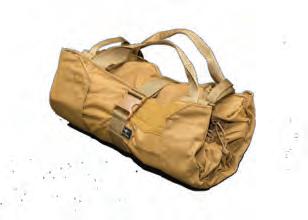
We’ve got the gear for Your next adventure.







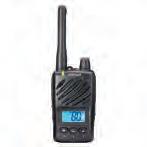







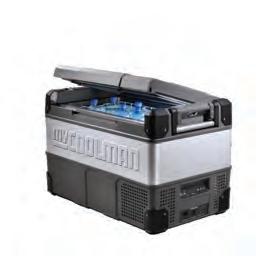

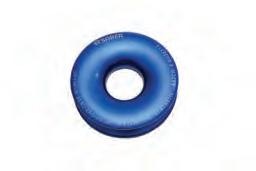

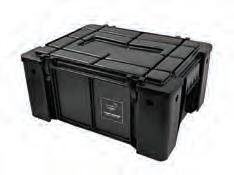
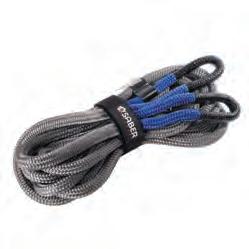

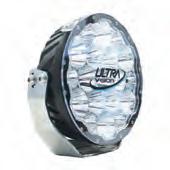
Redeemable online using the above coupon code during checkout at www.a247.com.au. Minimum spend $100. One use per customer. W4WDMAG ENTER CODE ON CHECKOUT $20 VOUCHER @a247gear www.a247.com.au 1300 995 727 $25 VOUCHER
Along the spectacular coastline between Broome and Wyndham towering gorges, breathtaking waterfalls, ancient art sites and some of the best fishing in the country awaits. Grant and Linda couldn’t resist experiencing all of this, plus more, on an adventure cruise with Diversity Charters.

Asdie-hard Kimberley visitors for a very long time, its natural beauty and remoteness continues to draw us back time and time again. So much so, we liken it to be our second home these days. And as 4W drivers, we’ve ticked off many of the usual big-ticket items that draw others like us to the region, while we’ve also squeezed in some of those hard-toreach locations by taking to the skies. But if there was one thing tucked into the back of our minds we longed to make reality one day, it was cruising along the Kimberley coast. With its thousand-plus kilometres of coastline and hundreds of islands dotted offshore between Broome and Kununurra, there’d be no shortage of things to experience and explore. By taking to the water, it would provide another perspective to the region we love, and the only way to truly experience more of her secrets. With an upcoming milestone birthday, the timing was right, and what an unforgettable celebration it would be.

10 Western 4W Driver #118
Chasing Waterfalls &

ALONG
By Grant Hanan & Linda Bloffwitch
Loving every minute of our front row seats at Kings Cascades.
Adventure
THE KIMBERLEY COAST
With a little research, we soon learnt there’s no shortage of cruise operators in the Kimberley, so we put some criteria together that would help us select an operator. First and foremost, we wanted to maximise our time on the water and looked for the longest cruise duration possible. We found cruises generally varied between 6-14 days on average, and those longer durations travelled from Broome to Wyndham or Darwin, or in reverse. We also learnt the best of the best attractions accessible from a Kimberley cruise are located between Broome and Wyndham. That narrowed things down and we started by looking for an operator who did this leg, discounting any others that continued to Darwin.

With that bit sorted, there was still a lot more we needed to tick off before making a decision. Choosing a small group operator meant the boat wouldn’t be crowded and could get into places where larger boats couldn’t. These two factors were important, as we didn’t want to fight for space on a
tender or miss out on getting close to attractions due to a boat’s size and guest capacity. Other criteria included having a cabin with our own ensuite. While this isn’t a biggie for some people, having our own was a big-ticket item on our list. Lastly, timing was the key. As our cruise coincided with an early April birthday, we would chase early season waterfalls and look for something that would work in with our dates.
To be honest, we weren’t sure whether we’d find a cruise that could accommodate everything we had on our list within our budget, but we needed to start somewhere. After more research, we were pleasantly surprised we found an operator that looked the goods, budget included. Diversity Charters offers a 14 day Kimberley Dream cruise from Broome to Wyndham or in reverse, taking a maximum of 12 passengers, and with a couple of cabins having their own ensuite. With all meals, fishing and other activities included, we were over the moon it ticked all our boxes, so the deal was done.
Spectacular King George Falls was in full flow during our cruise.
12 Western 4W Driver #118
After organising our cruise to coincide with another trip we’d planned along the Gibb River Road afterwards, we left our setup in Kununurra and flew to Broome a couple of days before Diversity departed. As alcohol on the boat is either BYO or can be arranged on your behalf by the crew, we took some time in Broome to shop and stock up for the trip. There aren’t any shops along the way to restock if you run out, so very careful planning here is the key.
By the time departure day arrived, we felt like kids bursting with excitement to open presents on Christmas morning. Our cruise began at Broome’s picturesque Gantheaume Point, where all guests were met by smiling Diversity crew and whisked by tenders from beach to boat. Welcome drinks awaited as we climbed aboard, and where we met our skipper, Cal Angove, and the five crew. Before departing Broome, Cal indicated there was some flexibility with the cruise itinerary and asked whether there were any specific places we were hoping
to visit. When I piped up that I’d love to visit Sheep Island if possible, he answered, “Yep, no worries”, without so much as blinking an eye. His positive response took me completely by surprise and made me feel like I was opening those Christmas presents again. With introductions and the safety briefing completed, we steamed out of Roebuck Bay with a sundowner in hand and soaked up sensational views of the setting sun. Now this is the Kimberley life!

Diversity is very much at home in the Kimberley waters.
 Our skipper, Cal at the wheel.
Our skipper, Cal at the wheel.
Western 4W Driver #118 13
It didn’t take us long to pick up Cal’s relaxed, approachable and easygoing nature is what he’s all about, and his passion for the Kimberley runs deep. “The remoteness of the Kimberley coastline is like nowhere else ...” he said during one of our many fishing sessions, “… and I still pinch myself every day about how lucky I am to show people how beautiful it is”. We were never going to disagree.
When the tides up here are the biggest in Australia and the difference between high and low watermarks can be as much as 12 metres, navigating the coast can be treacherous to say the least. Yet Cal has been traversing these waters for more than a decade. He’s been a skipper on both private yachts and charter boats since he was 22, before taking the plunge to buy his own boat four years ago. It’s an incredible story really given he’s just hit thirty. Getting into the groove of life on Diversity as a guest was very easy. At just over 20 metres in length, Diversity is a sleek and well-appointed twin hull catamaran, and we were never going to be cramped for space even if the boat was full. As it turned out,
we shared our early season cruise with six other passengers. We quickly settled into our luxurious cabin on the flybridge which had ample space, adjustable air conditioning and an ensuite. Diversity has a no-shoe policy while on board, and we were all encouraged to make ourselves feel at home. I don’t think any of us found that difficult at all. Diversity has three living areas, so we could take our pick where to admire the views, chat with others, read a book, or simply relax. The bow was the place to be for sundowners and snacks while watching rainbow-coloured sunsets, and gourmet-style main meals and desserts prepared by our chef, Nick, were generally served outside on the rear deck.
Speaking of food, Nick, was an absolute master in the kitchen and ensured the troops never went hungry. Somehow that was never going to happen when he consistently dished up delicious gourmetstyle meals and snacks that rivalled fivestar restaurants. On the off chance you still had an ounce of spare room to fill between meals, it was always easy enough to help yourself to barista style coffee
Watching Montgomery Reef appear on a dropping tide.

14 Western 4W Driver #118
Diversity’s three tenders returning from a fun-filled adrenaline-pumping ride through the Horizontal Falls.

or a selection of teas, or let loose on the biscuit jar. Diversity’s excellent hospitality didn’t simply stop at our stomachs, but also extended to the cabins which were attended to daily. Ris and Cora were both a hostess with the mostest, working tirelessly during the cruise to ensure guests had the best time possible, leaving no stone unturned with their impeccable attention to detail.
Our first introduction to the tumultuous Kimberley tides was a wild ride through the spectacular Horizontal Falls. This was one destination we’d visited a decade ago for another milestone birthday, whizzing through the falls back then in a 20+ seat fast boat. This time was going to be different as we’d be on one of Diversity’s tenders which is significantly smaller. Being a little apprehensive at first, I’m not sure why we had any reservations because we had more fun in the tender than we did all those years ago. Perhaps it had something to do with the number of times we zoomed up and back through the swirling waters of both gorges as I lost count after six.
Besides the Horizontal Falls, Montgomery Reef is a unique and special destination we had looked forward to experiencing having grown up watching the exploits of Kimberley icon, Malcolm Douglas. On a dropping tide, we all jumped into the tenders to witness the reef pop up in the middle of the ocean, creating waterfalls upwards of three metres. Seeing this amazing phenomenon just a short distance in front of us was something we won’t forget in a hurry. Next to us just feet away was an abundance of turtles, sharks and golden trevally, while birds of all sorts on top of the reef were dished up a fish sushi train as many were caught in the shallows. It’s no secret the Kimberley coast is teeming with marine life and the fishing is simply off the charts. We can’t say we’ve ever been diehard anglers, but we knew we had a serious problem if we couldn’t catch at least one. With plenty of fishing action daily, we were thankful our expectations were well exceeded, and fresh fish made it to the menu on a few occasions. Coral trout and fingermark seemed to be the crowd
Western 4W Driver #118 15
favourites, but seriously, you can’t come all this way without catching a barra. But as we found out, that’s not always easy. Towards the end of the trip we started to get worried our barra drought would continue, but as they say, good things come to those that wait. While fishing off a rock ledge up the Berkeley River, the stars aligned, and lady luck was on my side. After feeling a couple of sharp tugs and the rod bending awkwardly, I sprang into action with some words of encouragement by first mate, Brent, and deckhand, Jake. A few minutes later and it was all over. I think I had to pinch myself I’d actually reeled in an 87cm beauty. Not bad for a first ever barra catch, and coincidentally on my birthday too. What a present! But with the Kimberley such a large place, there’s plenty more to catch than just fish. One afternoon we went ashore to prise oysters the size of a fist off rocks, which were later prepared by Nick and devoured by all with a sundowner on Diversity’s bow. Another day, we dropped pots by some mangroves and later enjoyed mouth-watering chilli mud crabs again prepped by Nick that night. This was seriously good tucker.
But it’s water that truly makes the Kimberley so special and cruising early in the season will have you visit sights that completely blow your socks off when there’s so much water around. We saw cascading waterfalls everywhere we went, with well-known landmarks like Kings Cascades and King George Falls well and truly pumping. The roar of the water was deafening at both places, which got significantly louder the closer Cal edged Diversity towards the falls. Inching his way forward, he soon had Diversity’s bow under the falls giving all those congregated up front a refreshing pummelling shower. This is where cruising with a smaller boat that can get in real close to these types of attractions has its distinct advantages.

While Cal anchored close to King George Falls for a couple of hours, we took to the tenders and headed for land to hike to the top of the falls. While the climb might be steep and gave our legs a solid workout, the swimming above the falls and the view from atop was worth every aching muscle. Our itinerary included a swim every day during the
Ready to reap the rewards of our oyster hunt.
 Not bad for a first-time barra catch.
Not bad for a first-time barra catch.
16 Western 4W Driver #118
A morning shower of a different kind.
cruise; if it wasn’t in some spectacular gorge or next to some crystal-clear falls, a beach swim or two was on the cards when deemed safe by our croc spotter. For another completely unique and amazing experience, we swam in the middle of the ocean when a sandy cay popped up during low tide and even had a kick of the footy.
Living up to Diversity’s motto, 'Adventure by day, luxury by night', our days were jam-packed with activities that usually started around 7am with either a cooked or continental breakfast. But when the sun starts to peak a little after five in these


parts, we’d all be up early and head out on to the bow to take in those spectacular sunrises. Besides fishing and swimming during the day, there were plenty of other highlights. With much of the Kimberley a canvas for indigenous art, we visited numerous spectacular art sites, and also hiked to the wreck of a crashed DC3 plane at Vansittart Bay.
If truth be told, there were just so many highlights of the cruise. Cal was true to his word and anchored Diversity off Sheep Island, so we could take the tenders to shore for a visit. This island’s prominent history dates back to the late 1880s when an attempt was made to establish a settlement which failed before it got going. The oppressive heat and humid weather of a wet season arrival would have made establishing camp a nightmare. Then there’s the island’s hilly terrain that’s covered in large rocks, so conditions are far from suitable for grazing sheep. Topping things off, massive tides played havoc while settlers unloaded the boats, and the tides swallowed up a great deal of their
Fun under the sun at one of the islands we visited.
Western 4W Driver #118 17
stores. Suffice to say, the settlement was pretty well abandoned within that first year and today there’s only a few bits and pieces that remain including a couple of lonely graves. Our visit to the island turned out to be bittersweet … we were grateful to have got there, but on the flipside our visit was tinged with sadness knowing we were standing where many people’s dreams had been shattered. As the days passed and Diversity steamed closer towards Wyndham, I was dreading our Kimberley cruise coming to an end. I was far from ready to leave and could happily have stowed away for the return journey to Broome and do it all again. Before disembarking in Wyndham and hopping on a waiting bus to take all guests to Kununurra, it’s not until reflecting upon our adventure that we soon appreciated the magnitude of it all. Not only had we travelled more than 1,000 kilometres since leaving Broome two weeks earlier, but we visited attractions we’d never heard of,

Grant catching his first coral trout.

 Ready to take a dip in another secluded pool.
We found waterfalls everywhere we went.
Ready to take a dip in another secluded pool.
We found waterfalls everywhere we went.
18 Western 4W Driver #118
of,
came
ever wanted to
the
get to
the way to go.
of
it’s the journey,
runs a
it as an

up in one.
are a


no disputing
well

INFORMATION BAY For more information about Grant and Linda’s Kimberley cruise and other cruises offered by Diversity, check out the Diversity Charters website at: https://diversitycharters.com.au Rainbow-coloured sunsets were the norm during our cruise. experienced adventure we’d only dreamed
and
away with lasting memories and newly made friends. If you’ve
experience another side of
Kimberley that you otherwise couldn’t
by 4WD, then a cruise is
Think of
adult’s version
fun when it provides everything …
the destination, and the experience, all wrapped
Cal and his young energetic crew
well-oiled machine, and he
tight ship to ensure guests leave with unforgettable memories and experience that trip of a lifetime. There’s
they
and truly hit that mark. Ph 02-62804334 Email sales@responsiveengineneering.com.au www.waterindiesel.com.au Western 4W Driver #118 19
Legging it from Lockdown
By Susie Underwood
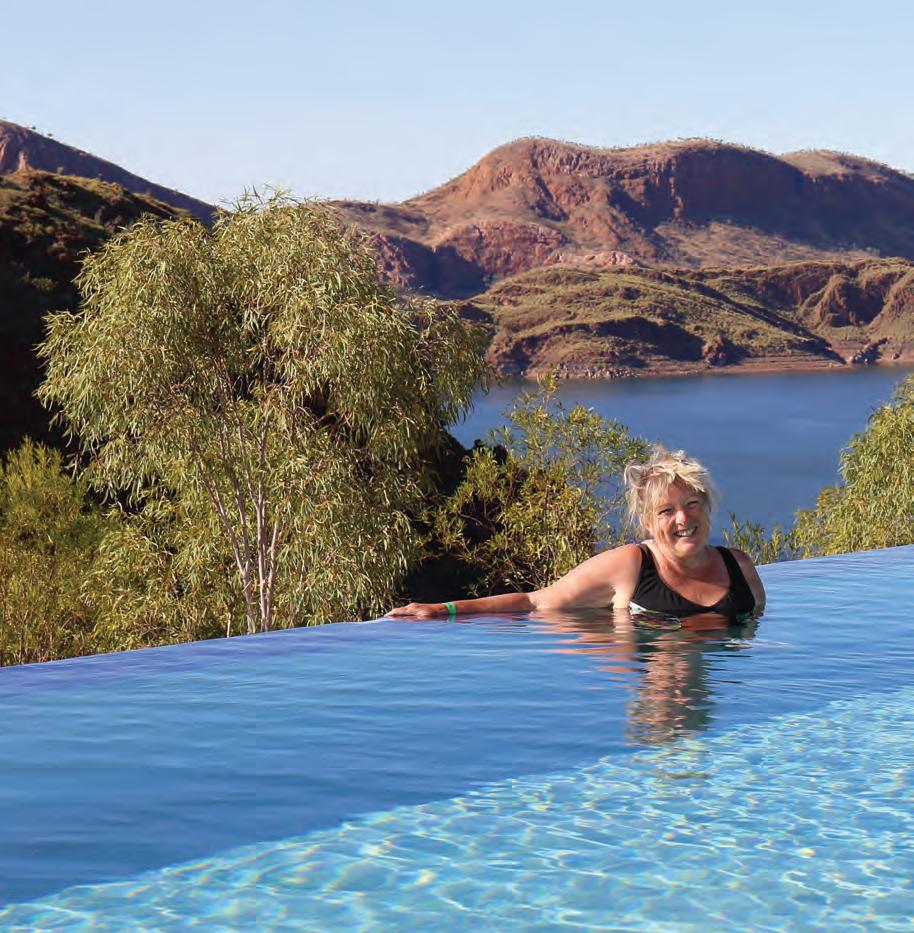
Infinity pool, infinitely coolfreezing actually, with the best backdrop in Australia.
PART 2 20 Western 4W Driver #118
Once past El Questro, it was a left turn on to the Great Northern Highway and into Wyndham, its northern terminus. Fortified with cake and coffee from the bakery, we motored up to the Five Rivers lookout which has stupendous views of the Ord, King, Durack, Forrest and Pentecost Rivers. The Port of Wyndham was spread out below us, busy loading live cattle, ore and agricultural products on to cargo ships. We were told that the occasional luxury cruise ship also picks up passengers here before heading to Broome. Descending from the lookout we took a leisurely drive around Wyndham before heading out of town to Parry Creek farm resort, where we decided to prop for
a few days. The campsite is quite big, with lovely showers and a convivial restaurant and bar which provided us with cold beers and a bucket of prawns at the end of the day.

I innocently asked if it was okay to swim in the lagoon, which the question was met by a snort of laughter and an, "Only if you don't mind sharing with Fat Albert (the resident croc)". Silly me, I had thought salties only lived in tidal rivers, I hadn't thought they could be in landlocked lagoons. Anyhoo, I decided against a swim with Fat Albert and consoled myself with another beer. We were also warned to be on the lookout for crocs travelling between the lagoons while we were out walking, a fact which had me tiptoeing tentatively around the walk trails
Cooler climes heading home demanded a warming fire at night.

Western 4W Driver #118 21
the next morning, my croc radar working overtime. It's a testament to my husband's patience and good humour that I didn't wind up neck deep in the lagoon. At the end of my trepidatious circumnavigation of the lagoons we parked ourselves in the restaurant and treated ourselves to a slap up breakfast. We were enjoying our second coffee when we got chatting to a couple of Kununurra locals at the next table, Greg and Narelle. Greg modestly replied "I paint birds", when asked what he did for a living. I urge you all to Google Greg Postle next time you're in front of a computer and check out his art works. They are mindbogglingly lovely. We were lucky enough to visit him in his studio while in Kununurra and the birds are so life-like you would swear they could fly off the canvas.
While chatting to them both, Nick enviously eyeing off Greg's enormous camera, they mentioned a few spots to check out, one of them Marlgu Billabong, which we visited the next morning. There is a really well laid out bird hide on the

The view from the Five Rivers Lookout is stunning in every direction.
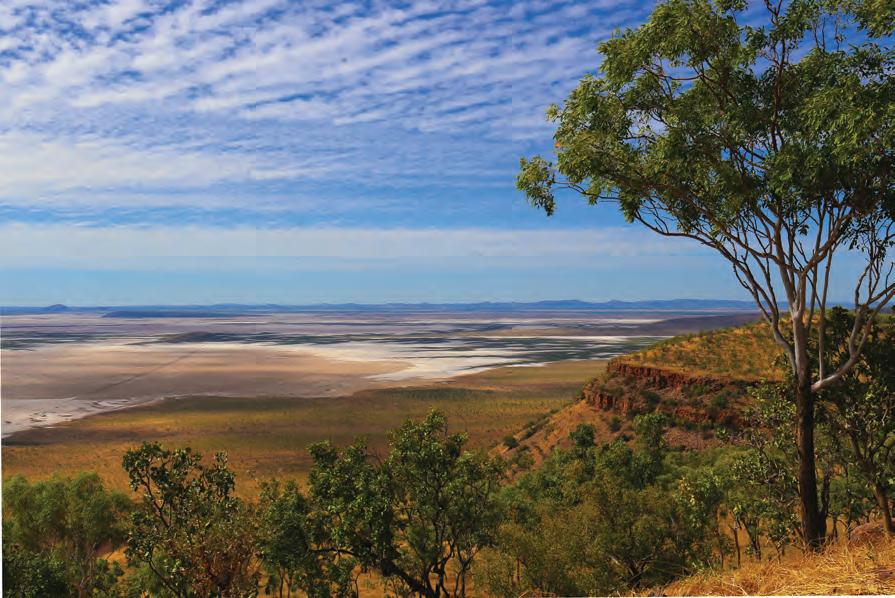
One of Marlgu Billabong's residentnasties goes lurking for lunch ....
.... while lunch remains safely elevated.

22 Western 4W Driver #118
edge of the billabong which we installed ourselves in with camera and binoculars to check out the wildlife. Well! Scanning the banks opposite turned up the most enormous croc I have ever seen. It was at least five metres long and nearly as wide, with moss growing on its back. I couldn't take my eyes off it, they really are primeval creatures. A couple of people arrived and were standing on the banks of the lagoon carrying on an animated conversation. Well, before you could say, "look out", this massive animal had turned and slid into the water, head pointed at the people on the other bank, just daring them to take a step closer. It was soon joined by another smaller (only four metres) croc and they sat there patiently, waiting for a sucker to stick a toe in. Luckily they didn't. It was amazing to see the birds casually walking past and around these monsters as they sunbaked on the banks and there were even a few perched on their backs when they were in the water. We eventually tore ourselves away and motored into Kununurra to stock up on supplies, only
to find that (it being Sunday), the supermarkets and most tragically of all, the bottle shops, were closed. Resigned to an alcohol-free night, we propped ourselves at one of the town's caravan parks for a quiet night on the shores of Lake Kununurra. We walked into town the next morning through Celebrity Park, where various national and international celebrities have had trees planted in their honour. (Yeah but no Kate's Bush or Twiggy's Forrest - Nick) Kununurra is a lush green gem of a town, guarded by the rock walls of the Mirama National Park. We had a few days there, catching up with newfound friends, finishing our trip with a delicious dinner at the Pumphouse Restaurant before taking off for Lake Argyle.

I have seen photos and heard stories of the fabled infinity pool at Lake Argyle and I was thrilled to be finally visiting it. This has got to be the best swimming pool in Australia bar none. Once again, the caravan park was mostly empty and we had our pick of places to set up. Once that was done, it was towels over the shoulders and into
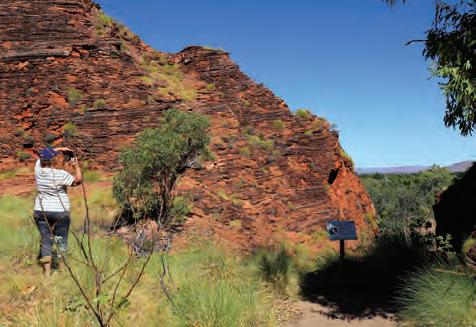 Kununurra's birdman extraordinaire, Greg Postle creating birdlife so real it could fly off the canvas.
A gap in the stratified Mirima National Park frames Kununurra townsite.
Kununurra's birdman extraordinaire, Greg Postle creating birdlife so real it could fly off the canvas.
A gap in the stratified Mirima National Park frames Kununurra townsite.
Western 4W Driver #118 23
Everything is larger than life in the Kimberley including this Goliath stick insect (Australia's second largest insect) we found on an 80 series wheel arch.

the pool. It was a tad chilly, but the view! I could have sat there for hours gazing out over the lake. The next day we embarked on the sunset cruise out over that blue vastness, stopping somewhere in the middle to jump over the side on our pool noodles while our skipper floated trays of champagne out to us revellers. It was an absolutely idyllic experience and I didn't give a thought to the 30,000 freshwater crocs who are said to inhabit the lake (much). The trip back was well timed to coincide with a breathtakingly vivid sunset over the Carr Boyd ranges, and then it was back to the resort for a dinner (cooked by someone else) with pink gin chasers (it was Nick's idea). We also hiked around the bluffs overlooking the lake, bumping into a fella Nick used to work with back in the last century - it sure is a small world. We also visited the old Argyle Downs homestead, transplanted stone by stone to high ground before the lake flooded. The museum in the homestead documents the rise and influence of the Durack family in the Kimberley but does sidestep the early brutal treatment of aborigines when the area was being settled. After our lazy days at Lake Argyle, it was back into Kununurra to re-stock and over the Ivanhoe Crossing,

Nick relaxing after 30 years at the editor's desk.
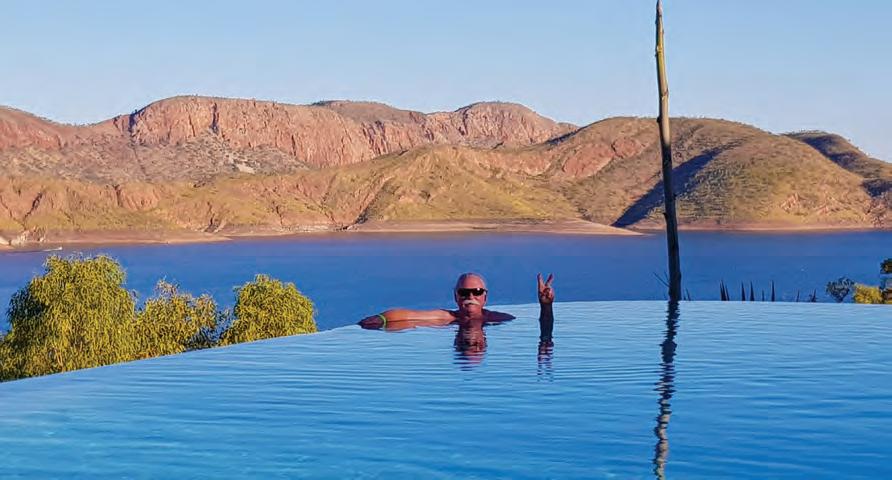
Is there a freshie nibbling my butt? Champers in Lake Argyle.
24 Western 4W Driver #118
heading to a bush camp on the banks of the Ord River which one of our new friends had told us about. We pitched up at this magic little camp site, under trees and on the edge of a tall sandy bank, which was lucky because I spotted a rather large croc cruising around down river. Needless to say I spent all my time safely up on the bank. We had an idyllic few days there, bird spotting and reading, only moving on when the pantry started to thin out. After stocking up in Kununurra (food and a sneaky peanut butter surprise at Spilled the Beans cafe), we headed off to Purnululu National Park to explore the Bungle Bungle Range.

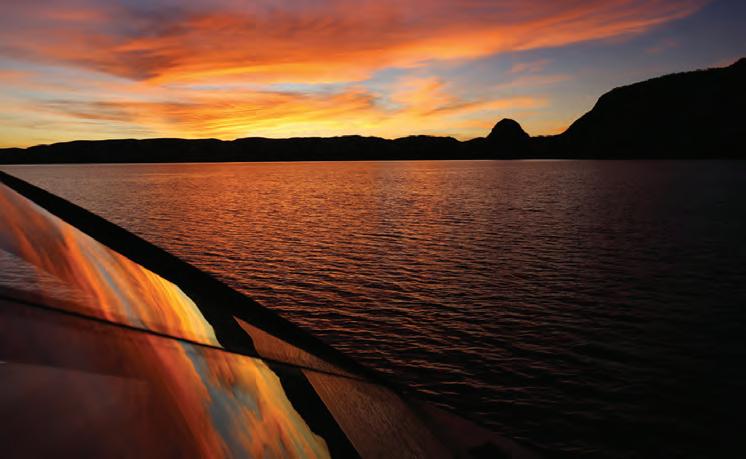
I'm sure all Australians are familiar with the beehiveshaped banded domes of this range and I was a bit excited to be getting up close and personal with them. After traversing the 53km track in from Great Northern Highway, which was in reasonable shape we thought, despite all
 Argyle sunset reflected in the cruise boat windscreen.
A Kimberley bush camp to die for.
Cobbler from the Ord and well up thebank to avoid the snapping handbags.
Argyle sunset reflected in the cruise boat windscreen.
A Kimberley bush camp to die for.
Cobbler from the Ord and well up thebank to avoid the snapping handbags.
Western 4W Driver #118 25
Wandering into Echidna Chasm.
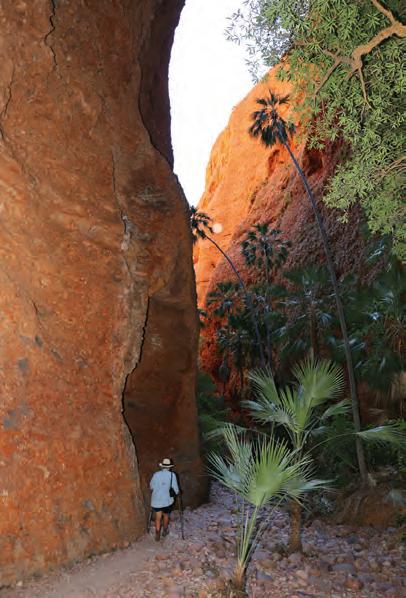
the dire warnings we had been given, our first stop was the Visitor's Centre to check out the lie of the land. Luckily we lobbed in about 10 minutes before closing time. The centre had only opened for the school holidays due to a sudden influx of visitors and was being mothballed again for the 2020 season. We camped the first night at an eerily empty Kurrajong Campground at the northern end of the range, heading out early to explore Echidna Chasm. What an awe-inspiring walk that was, through the narrow chasm with only a sliver of daylight visible above the towering rock walls. After visiting the Osmand Lookout, we stopped for lunch at The Bloodwoods before heading to Walardi Campgrounds at the southern end of the range. This is where the bucket list sites lie - the Domes and Cathedral Gorge. It was getting quite hot by this stage, so we opted to head for camp and wait for the cool of the morning for our next adventure. What a stunning, eyepopping experience! We walked through the Domes, ooh-ing and ah-ing all the way, before wandering past the sentinel termite mounds to the main event, Cathedral Gorge. What a place! At first sight, it looks like just another rock overhang with a pool in the middle, until you realise that those
The road into Purnululu was in great shape and travelled in third with lowered tyre pressures.

26 Western 4W Driver #118
tiny dots you can see on the other side are people. The size of the place is breathtaking, our experience enhanced by one of the dots on the other side suddenly breaking into song. Her rendition of 'Amazing Grace' brought tears to our eyes and goosebumps to our flesh. It truly was an amazing experience. We were very reluctant to say goodbye to this magical place and I'm sure we will be back again soon.
The next part of our journey took us through Halls Creek (the less said the better), refuelling at Fitzroy Crossing and finally pitching up in a little rocky amphitheatre off the Leopold Downs Road which we promptly named the Valley of the Giants. It was guarded by ridiculously anthropomorphic rocks and dotted with boab trees, so we spent a day and a half
Easter bunny ant-hill guards the entrance to Cathedral Gorge.
there, checking out the rock formations, taking photos of the trees and generally relaxing (I had a luxurious foot rub and spa while drinking in the sunset).
From the rear of the magnificent Cathedral Gorge where a lady with a beautiful voice sang 'Amazing Grace'.

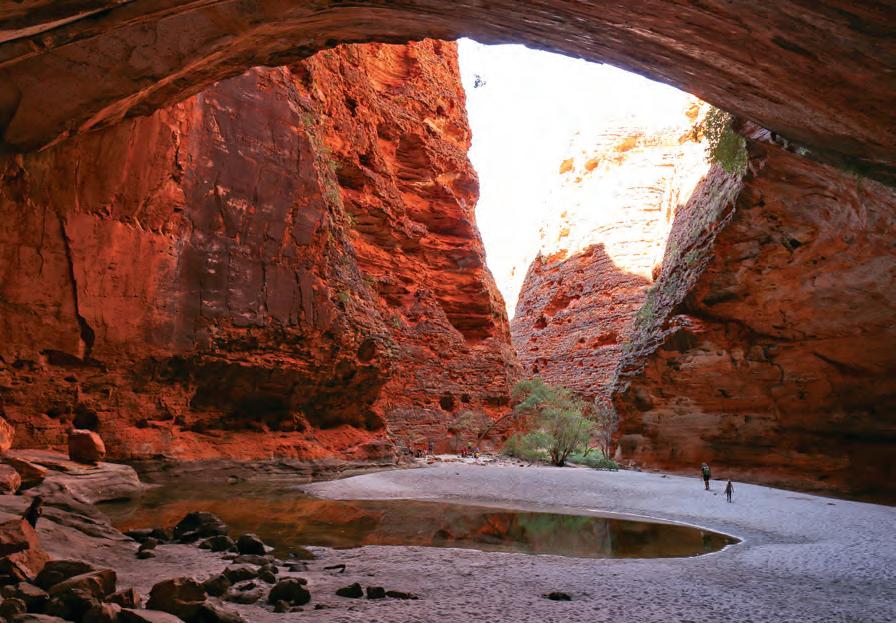
Western 4W Driver #118 27
Tunnel Creek - well, I never thought I would voluntarily walk into a pitch black hole in the ground, thigh deep in murky water and infested with crocodiles. Nevertheless, I ventured in, clutching my torch nervously in one sweaty fist, my pearls in the other. I know Nick enjoyed the walk, it is lovely at the other end of the tunnel and I did relax the death grip on my torch on the walk back, but I was very happy to see the sunlight on the other side.
We camped that night at Windjana Gorge, home to Alistair the agile wallaby who was sadly disappointed that snacks were not forthcoming, despite him batting his eyelashes for all he was worth. Next morning we ventured off to explore the gorge. We arrived just in time to hear a group
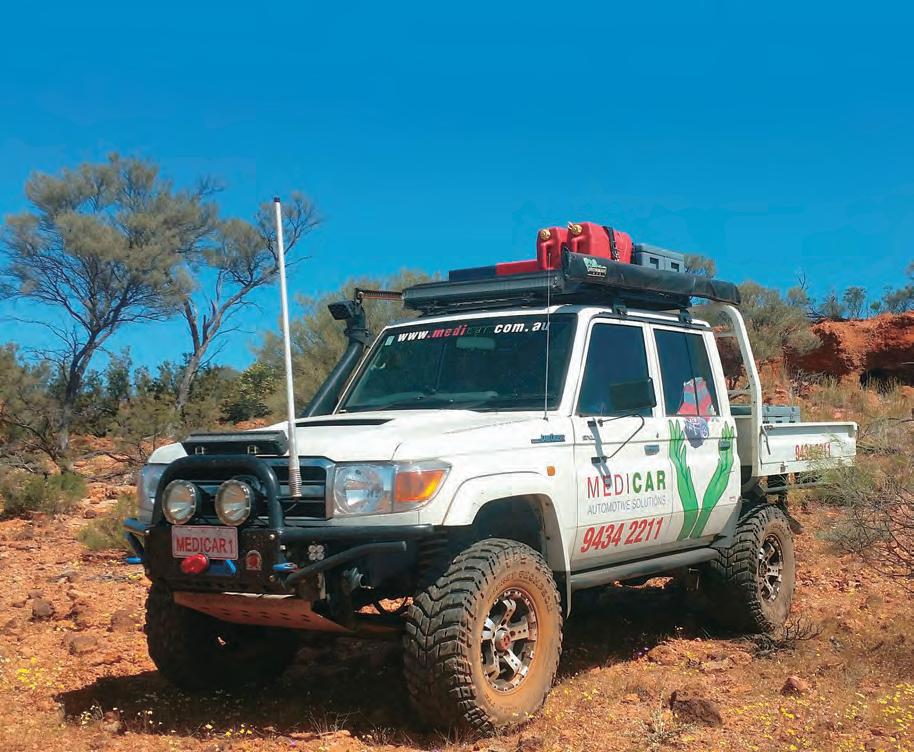

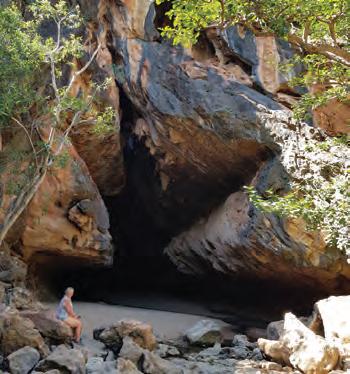

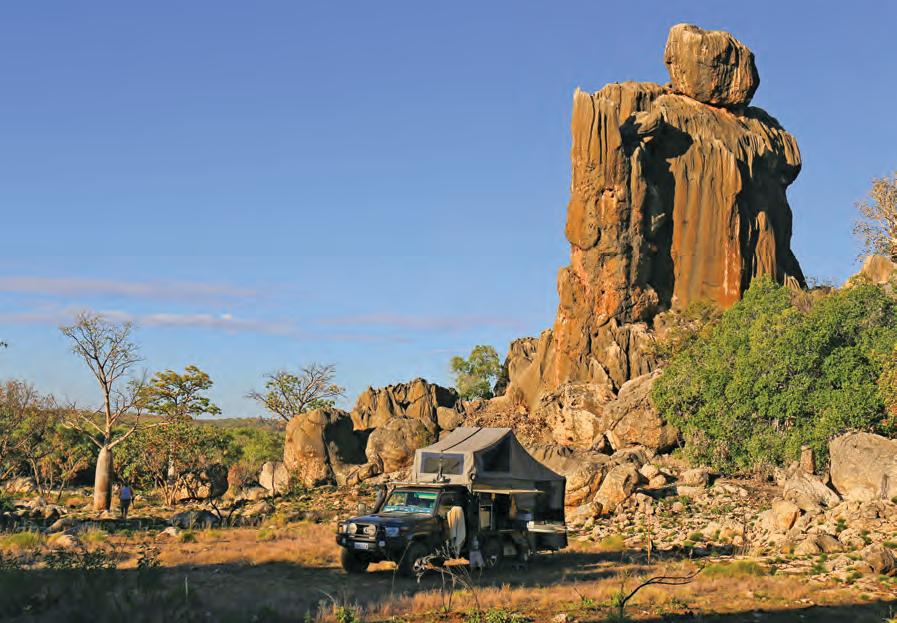 My intrepid guide encourages me across croc-filled murky depths in Tunnel Creek.
Gratefully out the other end where Jandamarra (Pigeon) met his.
Devonian reef erosion forms some wonderfully weathered remnants.
My intrepid guide encourages me across croc-filled murky depths in Tunnel Creek.
Gratefully out the other end where Jandamarra (Pigeon) met his.
Devonian reef erosion forms some wonderfully weathered remnants.
28 Western 4W Driver #118


What makes an exceptional 4WD experience? Over 30 Years All 4WD Servicing and Repairs KNOWLEDGE, EXPERIENCE AND PREPARATION. 4WD All Custom Work Power Chips Competition Bars Side Steps Canopies Drawer Systems Winches 4WD Tyres and Rims Diff Locks Nudge Bars Cargo Barriers Lights Awnings Compressors 4WD Servicing and Repairs 3” Exhaust Systems Bullbars Rock Sliders Tow Bars UHF Communication All Recovery Gear 2” & All Competition Suspension Upgrades Airbags Scrub Bars Long Range Fuel Tanks Dual Battery Systems Roof Top Tents & Swags Roof Racks “healthcare for your 4wd”
of blue-winged kookaburras giving voice, their song echoing off the rock walls. It was such a Kimberley experience. I was standing there, listening to the joyous sound, drinking in the scenery - the rock walls, the sandy beach speckled with basking crocodiles - thinking to myself this is the quintessential Kimberley. Everything seems so much bigger and more alive there. There are so many


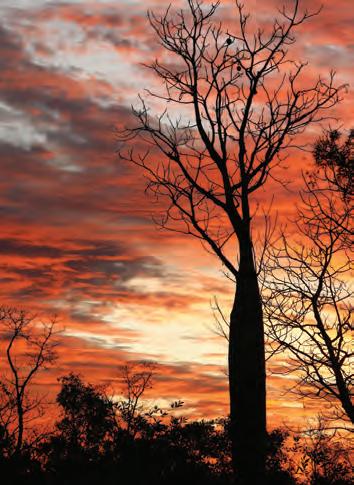
birds of every kind of feather, with a song range from the sweet and soothing to the bawdy and raucous, the grass is taller and lusher and the boulders are somehow bouldier than their southern cousins. I can understand how people come for a visit and never leave. It certainly puts a hook in your heart and I cannot wait to get back there and soak up more Kimberley beauty.
Stunning Windjana Gorge with ubiquitous resident bottom right.
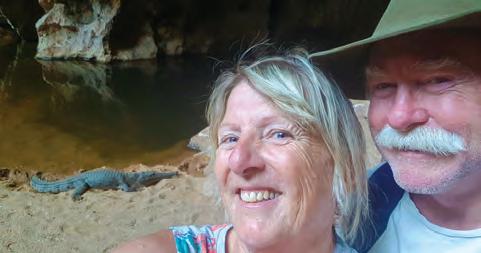
 Never take your eyes off a crocodile.
A boab in sunset silhouette.
Never take your eyes off a crocodile.
A boab in sunset silhouette.
30 Western 4W Driver #118





SUPASERVICE SUPAQUALITY SUPAFIT SupaFit Seat Covers SUPAFIT SEAT COVERS Australia’s SAFEST Seat Cover 1800SUPAFIT sales@supafitseatcovers.com.au www.supafitseatcovers.com.au Canvas - Waterproof, Durable Denim - Comfort, Improved Fit Seat Airbag Compatible • Australian Made
Capable of great
LAND ROVER
By Ray Cully
The Defender 110 is missing that tactile coalface interactive driver engagement style that original Defender owners love and shared with Toyota 79 series and pre-JL Jeep Wrangler fanatics. You’re now cocooned in a protective shell of electronic wizardry. Make no mistake, the captain still pilots this ship. But it’s from a refined and well-appointed bridge without the need to shovel coal in the engine room.
Granted, this new Defender may lack that old world simplistic charm, but there has been a massive leap forward to meet or exceed expected standards of safety and performance of a modern SUV.
If you’re willing to embrace change and modern engineering design, advancements in chassis development, and ground-breaking technology, then this vehicle delivers on all fronts. I’m talking about smoother ride, better handling, stronger fuel-efficient engines and off-road performance more akin to a modified 4WD than one straight off the showroom floor. More importantly, the new Defender delivers the impressive on-road driving dynamics and safety expected of a modern
genuine 4WD Land Rover product. For me it’s a combination of all these things which makes this vehicle so good. Love it or hate it, there’s no denying the new Land Rover Defender will catch your eye for longer than a fleeting glance.
This all-new model doesn’t make any effort to comply with current styling trends and blend into a sea of SUV similarity. Its bold individual and unique design is instantly distinguishable from the crowd, and is undeniably Land Rover.
The new Defender’s front end is a modern and bold step forward from the original Defender, embracing both newer design language and traditional DNA easily recognisable from other well-known Land Rover models. This modern interpretation stands on its own, unencumbered by the boundaries or engineering limitations placed upon the previous generation. Yet respectfully it still pays homage to its predecessor with subtle elements such as the Alpine light windows in the roof, a large single-side, hinged rear door and spare wheel mounted on a vertical rear end. So, perhaps the apple hasn’t fallen that far from the tree.
Do you love classic old-school truck appeal that is rugged around the edges; or enjoy a vehicle that feels like nothing short of a nuclear holocaust will deter its simple mechanical approach of raw guts and determination to get the job done? If so, you may find the all-new Land Rover Defender at odds with tradition.
32 Western 4W Driver #118
things
DEFENDER

110
Western 4W Driver #118 33
Just as fashion changes, so too has the Defender’s status amongst its peers in the Land Rover stable. No more the strippedout basic commercial offering at home with Wellington boots, bib and brace overalls with a long sleeve plaid jacket. Significantly extending the original Defenders core capabilities, this new vehicle brings with it a more relaxed and comfortable tone of blue denim jeans, chambray shirt and some RM Williams boots, making it more appealing and relevant to a much wider demographic. Defender completes the Land Rover line up; from Range Rover’s opulent luxury, to the family friendly, highly capable Discovery. This rugged square-jawed intrepid explorer was purpose built to master challenging terrain so we could safely enjoy the more adventurous side in all of us. If you think about it, there’s no denying Land Rover has done a masterful modernisation of what is effectively the quintessential practical box on wheels.
Our test vehicle, a Defender 110 P400 SE finished in Santorini black, had a formidable presence with its broad, bold front-end

styling. It looked even more aggressive with its Transformer style LED headlights and tribal markings in the guise of crisp white daytime running lights. All nicely offset by the accented silver-grey lower air intake grill cover that’s discreetly swept back at the outer edges to deflect vast amounts of cool air into the intercoolers when aggressively force feeding the Defender’s power plant.
The commercial square grated grill and matching side vent covers on the front quarter guards added to its rugged appeal. The non-functional fake checker-plate panels adorning the tops of proper front quarter guards and inset bonnet complete with 110 decal are a nice acknowledgment of an earlier time.
Side on, this beast is a vertical slab, only broken by the chamfered waistline extending forward from the tapered instep of the rear body panelling and running the length of the vehicle. The horizontal roof line complements the squared-off glass and wheel arches, giving the Defender a strong, assertive stance. Although I’m
34 Western 4W Driver #118
not sure I see the relevance of the large decorative flat panel placed over the C pillar and encroaching into the rear window area.
Given how chunky the body design is, Land Rover’s D7x aluminium monocoque design is three times stiffer than a traditional bodyon-frame. So, it comes as no surprise that the Defender will easily handle a static roof load of 300kgs; plenty of capacity for a large roof top tent and two adults. Packed down and ready for transit, it’s still has a dynamic load of 100kgs. That leaves you with a vehicle carrying capacity of 800kgs to be divided up amongst passengers, cargo, tow ball weight and 4WD accessories.
At the rear, the modest uncluttered design and specific placement of the recessed LED taillights show an uncanny resemblance to the simple styling of its predecessor, confirming this vehicle as a genuine member of the Defender family. There’s also a silver-grey centre piece to the integrated rear bumper to complement the front and complete the design. While standing on elegant machined 20inch rims, at least they were wrapped in
Good Year Wrangler All Terrain

Adventurers as opposed to low-profile road tyres. This allowed me to breathe a little easier, given our intended test route.
The very vertical rear and upright front allows the forward or aft overhang to be kept to an absolute minimum, enabling the 110 Defender to achieve an impressive approach angle of 38 degrees with a ramp over and departure of 28 and 40 respectively, when the suspension is in offroad height. Add to this high sill panels, and no less than 291mm of ground clearance with a wading depth of 900mm, and it’s obvious this new Defender packs some serious credentials for a vehicle straight off the showroom floor.
Land Rover is exceptional at designing interiors that match the vehicles' intent. Pure opulent luxury in the full cream Range Rover or a balanced blend of commercial design practicalities and visual elements for the Defender. There are big multifunction chunky rotary controls, Allen key bolts on door panels, and a storage shelf running the length of the dash. It integrates entry grab handles into the
255/60R20
Western 4W Driver
#118 35
dash framework to provide a perfect gripbar when undertaking adventurous offroad driving. There’s the practicality of rubber to brush or wipe out dust and dirt. The extremely comfortable heated and electrically adjustable front seats with memory position on passenger and driver’s side make it easy to find the perfect seating position. Or swap between drivers with a simple one touch seat adjustment. Our SE seating was finished with leather inserts and covered with a heavy weave canvas style material that felt very durable.
The utilitarian boxy design allows for a more vertical window line, meaning head and shoulder room is spacious. Wide opening doors and well-placed grab handles front and rear make it easy to climb in or slide out. Interestingly, the upper door lining is covered in a wetsuit style material, it’s also on the console lid and across the top of the dash. It wipes down easily and seems water repellent, how durable it would be with sunscreen, sweat and red dirt only time will tell.
A brilliant feature is the ability of the rear-vision mirror to switch to a full width digital screen at the flick of the button. Land Rover has mounted a rear vision camera on the roof of the vehicle. So, when the rear of the cabin is loaded to the ceiling with boxes or camping gear, you can still see what is behind the vehicle. It takes a little getting used to, because of the very wide angle of view, but is a tiny stroke of genius design.

I also liked the ability to access both front and rear doors by keyless entry, making those times when you just want to drop something in or grab something out of the back seat super easy. Nice!
The rear seat works as a standard 60/40 split, with the base tumbling forward and the back rest laying down to create a level flat floor. Or you can separately fold down just the centre to carry longer items. Rear head rests quickly fold forward when not needed, improving rearward visibility. There are even door ajar warning lights in the armrests. With a 6’ driver, there’s an impressive amount of leg room in the rear. Dual air vents on the rear of the console ensure plenty of cool air for rear occupants, with controls to adjust mode, fan speed and temperature.
I was pleased to find the centre seat in the rear wasn’t as bad as expected. The traditional kid's only seat could comfortably seat an adult for a moderate distance without complaint. Or you can fold the back support down to create a comfortable arm rest and somewhere to place the macchiato for the two-rear passengers. There’s no lack of connectivity with a USB port on the back of each of the front seats,
with dual 12v cigarette sockets and USB ports located just below the AC controls. And there’s also four ISOfix points for those with youngsters.
Pull open the rear door and access is tall and reasonably wide; there’s good height
36 Western 4W Driver #118
from floor to ceiling offering 1,075 litres behind the second-row seats, and as much as 2,380-litres when the second row is folded flat. Both the rear floor and back of the second-row seats are covered in a hard plastic checker plate style covering for easy cleaning. A vehicle jack sits under the rear floor along with a privacy blanket for the rear cargo area. Convenient bag hooks are on the rear pillars, and I really liked the ability to raise or lower the suspension for loading height or trailer connection via the controls mounted just inside the door. A standard 12v outlet is on the passenger’s side with a 230V 180W GPO on the driver side. There’s a control for fan speed, which I’ll assume is there for the 5+2 seating option with one rearward facing vent on the passenger’s side C pillar.

Jump into the command seat and at first glance the interior design may look simple and uncluttered. But it’s what you don’t notice until you use it, that gives ongoing appreciation to how much design thinking went into the placement and configuration of all the vital controls and driver information displays. Land Rover has nailed the concept of less is more, and as a result the cabin has a relaxed unpretentious and spacious feel, with just the right blend of visual and tactile commercial touches to signify you’re driving a robust purpose built 4WD. Unlike the traditional integrated dash to floor design, our SE Defender’s console is an interesting open design with a large storage area at the front. The large lid doubling as an arm rest houses a very handy refrigerated compartment, and there’s an inductive charging platform for phones. There’s also the option to have a centre seat in the front; how practical is that retro concept? Honestly, the more time I spent inside this vehicle from city to country, the more I appreciated how good it truly was.
All switches and rotary dials are neatly clustered together in a logical layout on a central panel that extends outward from the dash and which also houses the electronic joystick gear shift lever. Above that is Land



Western 4W Driver #118 37
Rover’s new Pivi Pro infotainment system, which is intuitive to use and feature-rich with easily accessible menus for a range of driver information. The interactive instrumentation driver display is crisp and clear and enables you to view a range of information in the centre including GPS navigation, phone, audio, camera views and 4WD information.

However, not all is perfect! The amount of wear and scuff marks evident on the rubberised cup holder compartment made it look very grubby and old before its time. The other issue was a stain on the canvas covering of the driver’s seat, which looked like it had been treated with cleaning products but without success. I saw a YouTube video of someone who had washed their vehicle with soapy water and opened the driver’s door to grab something. A small amount of water and soap landed on the seat, and they’ve been unsuccessful in removing the resulting stain. I would expect enhancement in material choice or protectants in future models.
Press the start button and there’s an infectious rasp from the exhaust as the 3.0L inline petrol six bursts into life before settling down into a subdued idle. Engage drive and the Defender glides off effortlessly and you pick up momentum. The first thing you notice is how solid and planted this big heavy vehicle feels. However, large glass, good sized mirrors and a high seating position provide great visibility and the nicely assisted electric steering, responsive throttle and powerful brakes make it surprisingly easy and relaxing to manoeuvre in city traffic or around suburban streets. Even parking in snug carparks presents
no real challenge with excellent surround cameras to keep external clearances in check. As a daily driver, the Defender is quiet and comfortable. Its roomy interior is family oriented with practicality in mind to accommodate transportation challenges involving children, teens and fur kids for the extended family.
Move onto the freeway and the midrange response is smooth and linear in its delivery. The torque at slower speed is so good that you feel like you’re driving a diesel, yet it keeps the crisp acceleration of a spirited petrol. This is thanks to the clever mild hybrid technology further enhancing the 3.0L’s already impressive performance. The MHEV 48V system features an electric supercharger for immediate response at low rpm transitioning over to the twin-scroll turbocharger to deliver impressive top-end power. Give a firm squeeze on the throttle and the Defender will execute overtaking duties with eye-widening authority. But if that’s not impressive enough, provoke this beast and the Defender will unleash 294kW of aggression through its sophisticated and muscular driveline, while harnessing a 550Nm surge of torque as the traction
38 Western 4W Driver #118
control works hard to maintain grip. This 2,361kg Defender 110 propels itself from stand still to 100km/h in an exhilarating burst of only 6s. Given its 89L fuel capacity, and an indicated drinking habit of 9.9L/100km, then with a moderate right boot you should see somewhere between 700-800km on a tank. Load it up with gear and pull a trailer and you’ll naturally be south of that. From subdued inner city commuting to enthusiastic driving or working hard on challenging terrain, the 8-speed automatic transmission borders on a precognitive ability to read the engine's mind, enabling smooth and precise gear changes, whatever the circumstances.

Getting out onto the open road at 110km/h, the Defender settles into being a relaxed cruiser consuming long stretches on the blacktop with considerable ease. Gliding along, the well-calibrated air suspension disperses with all but the largest of the surface irregularities, cushioning its occupants from harsh bumps and vibration. Interestingly, when covering more textured road surfaces at speed, the Good Year Wrangler All Terrain Adventurers created a noticeable hum which intruded into an otherwise quiet cabin.
Despite the Defender’s large bulk, you’ll feel a good level of confidence and stability when changing direction or tackling long sweeping bends on country roads, allowing you to relax and enjoy the drive. Understandably, there’s more body roll than a Dynamic Response equipped Range Rover Sport, but Land Rover’s Adaptive Dynamics does a more than reasonable job of monitoring driver input, vehicle speed, steering position and body movement 500 times a second, allowing the Defender to rapidly adjust suspension response to changing conditions.
The Defender utilises Terrain Response II, which is as good as it gets. Land Rover was the frontrunner, implementing this functionality in 2003. It’s no surprise that in 2021 it remains the benchmark technology by which we judge all others. The Defender has eight settings to choose from including ECO, comfort, grass gravel snow, mud and ruts, sand and rock crawl and there’s even a wade function. Plus, this accomplished system is configurable for driver requirements. Yes, you can tailor how the vehicle reacts by altering several key systems to best suit the terrain conditions.
Western 4W Driver #118 39
Turn onto the gravel and the combination of subtle air suspension, adaptive dynamics, and being able to spin a dial to select grass gravel and snow from the terrain response system uncovers yet another level of capability. Despite corrugations, potholes, deep patches of gravel mid corner, even sudden undulation changes or off-camber bends, the Defender relished the conditions. Drive sensibly, and it never feels skittish or light-footed, even under throttle or firm braking. Traction control, dynamic stability and ABS intervention ensure the Defender remains predictable and stable even over ball-bearing gravel.
With a tow ball weight of 350kg and braked towing capacity of 3,500kg, this new Defender has all the right attributes to make it a good stable tow vehicle, limited only by its fuel capacity for long hauls. I figure the after-market boys will provide plenty of options to address that deficit.
Time to get serious and push the Defender into the rough. Selecting low range and raising the suspension height we dialled up rock crawl, engaged All Terrain Progress Control and set off to negotiate steep loose gravel climbs and twisted rocky ledges covered in shale and loose stones,

followed by deep moguls guaranteed to leave wheels hanging precariously in the air and sticky mud that would turn road tyres into slicks.
We figured a short steep section with deep offset hollows would test the Defender’s ability to meter the level of traction control from fully locked to open and back again in a very short distance. Too aggressive and the vehicle will labour to climb, not enough and the system would jerk and buck as it tried to arrest the spinning wheel causing further loss of momentum and traction.
Switching on All Terrain Progress Control and setting it to its minimum speed, we removed our feet from both pedals and pointed the Defender’s nose skyward. Slowly and with controlled application of throttle, it began to climb. Watching from outside, I could see the passenger’s front wheel began to lose grip from the surface; there was a momentary pause, a reduction in engine torque, and then it crept forward. The moment the passenger’s front wheel left the ground it remained completely stationary, showing 100% of the drive was being redirected to the driver’s front wheel that was still in contact with the ground. As the passenger’s wheel gently
40 Western 4W Driver #118
touched down, there was another change of pitch from the engine as the driver’s rear wheel left the ground and it repeated the process. The Defender climbed to the top with no sign of duress or strain. We repeated the test several times to experience and observe from outside and behind the wheel, all with a repeatable and consistent outcome.
Moving on to the rocky ledges, the Defender’s ground clearance really came into play. With 291mm of clearance, we easily cleared obstacles that would have scraped on other standard non modified vehicles. This was also the chance to try out the Defender’s technology party trick, having the driveline displayed in the main instrument cluster showing wheel position, and suspension travel. We activated the cameras to enable Land Rover’s advanced ClearSight Ground View technology, which lets you see the ground usually hidden by the bonnet. By using a delayed feed taken from just in front of the vehicle, it passes underneath at the same time you drive over the terrain. Every genuine 4WD should have this camera functionality as standard. You can literally watch the placement of the front wheels from inside the vehicle. Brilliant!
Driving over any rocky terrain requires gentle application of throttle and brake, often in combination to maintain vehicle balance and forward momentum. The Rock Crawl mode makes several adjustments to the differential, brake and throttle response providing the driver with accurate control over the vehicle. And it works very well indeed, as we balanced the vehicle several times on two opposing wheels to negotiate an obstacle.
Hill launch assist also proved its worth on several large boulders with the rear wheels only just having straddled the ledge, any roll back would have seen the vehicle slide sideways, but the system held the vehicle motionless, allowing time to make a smooth transition from brake to throttle.

Slowly making our way to the top, over sharp rocks and pointed stones, my remaining angst was not for the Defender but the tyres. The smeared gravel dust on the front looked like a smirk on its face, showing how much it was enjoying being off the blacktop.
With such large reserves of torque on tap, great ground clearance, and no low hanging diff centre to act as an impromptu plough between the wheel ruts - the mud bath was a non-event. Other than a great opportunity to get some great pics and let's face it; Land Rovers look perfect covered in mud!
Making our way down a rough old dry washout as we headed back toward the highway, I couldn’t help but think just how easy the day’s challenges had been. I’d truly underestimated what the new Defender would deliver. Like many taking a road test from a dealership, my first impression was of impressive on-road prowess. This was comfortable, powerful and a real joy to drive. With such good blacktop behaviour
Western 4W Driver #118 41
there
to
That’s
develop for mechanical reliability, can only be proven through the test of time.

The Defender’s strength is that it provides an exceptionally balanced performance both on and off-road in a stock standard vehicle. What it delivers in comfort, performance and practicality, with a 5 Star safety rating and a new level of off-road prowess is what makes this vehicle so desirable. With respectful deviation from its predecessor, the new Defender will blaze its own path and generate a whole new generation of admiring loyal followers.

had
be a compromise in its offroad capability. But there isn’t; as good as it is on the road, it's as good off-road.
not saying another manufacturer or other vehicle does one or the other better. Conclusion: The new Defender can’t hope to capture the nostalgia and feeling that you get from a simple hands-on mechanical style 4WD, and it's not trying to achieve that mystical goal. The durability of interior materials, and the reputation the Defender will Price: $102,736 Engine: 2996cc Turbocharged (+ e-Supercharger) In-Line 6 Cylinder Petrol Output: 294kW/550Nm Transmission: Eight-speed automatic Tow Capacity: 3500kg Fuel: 9.9L/100km Safety rating ANCAP 5 Stars. FastFacts Options as fitted to test vehicle: Sliding Panoramic Roof $4,370 Three-zone Climate Control with Rear Cooling Assist $2,405 Advanced off-road Capability Pack $2,210 Santorini Black Metallic Paint $1,950 Style 5095, 20 inch 5 split-spoke, Gloss Dark Grey with contrast Diamond Turned Finish $1,560 Off-road Pack $1,448 Comfort & Convenience Pack $1,414 Black Exterior Pack $1,079 Driver Assist Pack $948 Privacy Glass $845 12-way Heated, Electric Memory Front seats $806 Cabin Air Ionisation $455 Air Quality Sensor $195 Matte Black Bonnet Decal $280 Bright Rear Scuff Plate $485 Price as tested: $123,168 42 Western 4W Driver #118


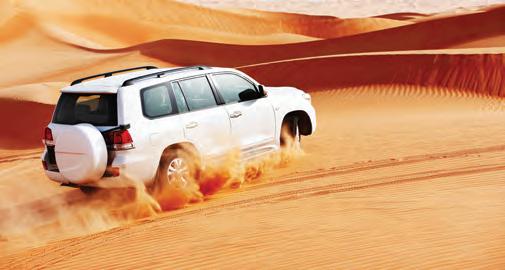
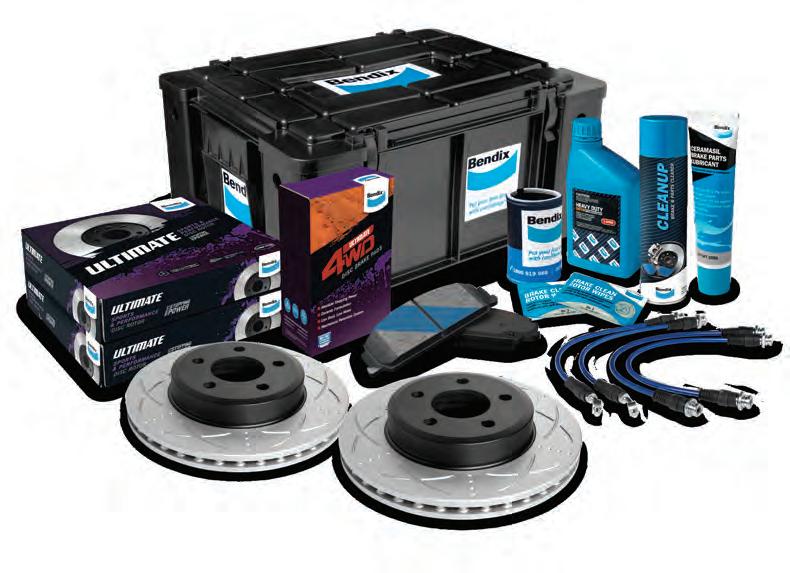
Find solutions for every brake job at www.bendix.com.au Or freecall the Bendix Brake Advice Centre on 1800 819 666 Bendix is a trademark of Garrett Advancing Motion Inc. This comprehensive kit includes specially compounded high performance CERAMIC material brake pads for increased stopping power in extreme conditions plus the latest Bendix Ultimate Rotors designed and developed specifically for Australia’s demanding conditions. The Bendix Ultimate 4WD Brake Upgrade Kit with advanced brake pads and rotors, braided lines and a host of ancillary items is the ultimate brake upgrade for the latest 4WD vehicles such as Ranger and Hilux.
BREMER BAY The beauty of
 By Jon Love
By Jon Love
A few hundred kilometres from home it was just another day in paradise, and as we crested the sand dunes on our way to camp, not even the grey clouds encroaching on the horizon could dampen our spirits, but perhaps the 20mm of rain forecast for the following day might!
44 Western 4W Driver #118
Nestled into our paradise campsite with the tall dunes of vegetation towering over us.
Ourentry into campsite number one guided us through a descending track surrounded by densely green bushland, and as you pull out onto the beach you’re presented with the unique landscape of the Bremer Bay region. With the glistening of the sun off the water to one side and the incredibly steep wall of bushland on the other, the area creates a truly picturesque sight to take in. As it was my first time in this region, on many occasions I would sit staring at the elegance of the surrounding environment.

It wasn’t long before our convoy was cruising up the beach, exploring everything the small bay had to offer. As you head up along the waterline a small reef shelf stretches out across the water, displaying a beautiful contrast of rolling white foam mixed with the bright blue and dark yellow of the limestone. As you approach the tip of the beach you become hugged up against the granite rocks that sprawl out into the bay, but unequivocally the most unique feature was the sight of the small freshwater creek that flows down the steep wave of the hill, through the trees and onto the beach below. With the sound of the swell gently crashing against the shore and

Fishing from the granite rocks overlooking the bay.

Western 4W Driver #118 45
the trickle from the stream running through, this made for the perfect campsite. It wasn’t long before we had the beds set up and the barbeque out ready for a few snags and chops to fill the grill. With the red ball in the sky making its way under the horizon and the last of the light disappearing for the day, the sizzle of chops on the grill filled the campsite as we sat back and looked forward to the adventure to come.
Day two started off with an early coffee overlooking the bay from the rooftop tent, a cool breeze whipping off the surface of the water to make for a snug viewing of the landscape around us. Fortunately the clouds had backed off and the sun was once again making an appearance, underscoring the beauty of the bay. With rain expected and an overwhelming eagerness to explore what else lay around the corner, we took off exploring on foot, leaping between boulders and carefully edging down rock faces to peer into the clear blue water below. Naturally a few fishing rods tagged along for the ride, perching up on a granite rock that provided a neat spot to fish from, all the while showcasing the bay and its many gems. A few herring made for a good bit of competition between the group of us, seeing who could pull in the biggest catch, but in true fashion we were left with our hands in our pockets for the most part! Unfortunately time came to stop feeding the local sea dwelling
Looking off into the distance with the end of Reef Beach in sight.

population with poorly hooked bait and to pack up the gear, getting prepped for the day ahead. It’s always disappointing leaving such a unique campsite, but with a couple more days ahead of us and finding a gem on day one, future prospects were looking promising.
It wasn’t long before we ascended our way over the hill that overlooked the bay, weaving through bushland and following the tracks that laid ahead of us, following the coastline and the cliffs that sat over it. We ended up perching on top of a hill to watch a pod of thirty or more dolphins swimming around a bay not too far away. As I was prepping to throw up the drone the unmistakable sound of liquid pooling under the Troopy echoed in my ear. Hoping
As you could imagine from its name, Reef Beach is littered with reef shelves like this one.

46 Western 4W Driver #118
it was something minor I crouched down to see where it was coming from, and much to my dismay it turned out to be diesel streaming from one of the tanks. Not exactly the most reassuring sight to see. After some investigating and an attempt to stem the flow of fuel coming out, none of the attempts came to fruit as the leak was tucked too far behind other components of the body. With the leak fluctuating between a slow drip and a steady pour, we opted to head back into town to see if we could get it looked at. As it turned out the route to town was still an adventure in itself, coasting over beaches and navigating our way over rocky outcrops that lay scattered across the beaches. In no time we were back on the black top and rolling through town. Strangely enough, after multiple inspections of the underbody, the leak had completely stopped, and to this day has never reemerged. Feeling confident the issue was at bay, we opted to pay a visit to the local Bremer Bay Brewery, enjoy a pint and then hightail it again for the next destination.
Back off the beaten track, the weather looked like it was finally about to turn the tide. The grey clouds began to roll back in and a cool breeze was kicking into action. In character with the region, we were once again cruising on top of a large hill with the ocean occasionally peeking through the tree line. The track that wound down the hill and allowed you to access the beach below proved to be a fun, slow drive, taking you through dense bush while throwing in steep, undulating drops that needed to be carefully negotiated. All the while glimpses of the coast would appear andTaking a moment to appreciate the view on our dash back to town.

 Peaking the hill overlooking Reef Beach and getting a glimpse of things to come.
Peaking the hill overlooking Reef Beach and getting a glimpse of things to come.
Western 4W Driver #118 47
then disappear as you weaved and bobbed your way over the terrain. The end of the descent is marked as you drive out into the clearing with sand dunes surrounding you, guiding you to a clearing that’ll place you on the doorstep of the coast. However it wasn’t all sunshine and rainbows (quite literally). As we came up to the passage heading to the beach another car in the convoy radioed in with an issue. Having pulled up to assess the situation, it seemed that the steep descent and the uneven terrain caused the rear right-hand spring to pop off the axle. Whipping out the tools and wedging the Maxtrax under the car for support, we tinkered away to get the issue sorted, not the easiest task given the weight of the car and the softness of the sand. Misfortune was narrowly avoided as the bottle jack collapsed under the car, causing it to violently drop with heads working away underneath it. Fortunately a quick response saved those working below it, with the tyre wedged between the car and the sand prevented it from going any further, underscoring the importance of placing it between the chassis and the ground for additional protection. Before long the spring was back in place and the convoy made tracks into the first section of Reef Beach. Eager to pull up for the day and establish our second campsite, we scouted
Some dune-side mechanics to get the rear spring back on the axle.

locations with the best protection from the oncoming storm. A crevasse cutting its way into the limestone ended up being our home for the night, with ample shelter from the wind and a first-class view of the storm rolling toward us. Some tucker was enjoyed briefly around the campfire, but the night was quickly retired as the first drops of rain began to fall.
A clear morning and blue skies welcomed us into day three, and with plenty of exploring around Reef Beach on the cards, we didn’t hang around camp too long. A quick coffee was complemented with the
Night two in the shelter of the crevasse stretching back into the dunes.

48 Western 4W Driver #118
Are we there yet? The hard walk to the top for a speedy ride down.
view of the rolling swell breaking over the distant reefs, one of which drew particular interest to us. As the engines turned over, the convoy moved its way over to the eastern-most point of the beach, where a small oasis opens up, presenting a calm and cosy corner of the beach. Perhaps a hundred metre stretch of beach and shallow reef sat adjacent to each other, providing a sanctuary of peaceful crystalclear water shimmering in the sunlight. Pressed up against a steep granite rock ledge, this allowed you to walk out further into the bay, peering through the water with bommies scattered across the seabed. With high tide already set in and a number of sharp rocky outcrops between the beach and the cove, the cars were parked up against the dunes and we set off on foot to enjoy what the little oasis had to offer, and with no other soul in sight, it was our own slice of heaven. The opportunity to snorkel in the cove was swiftly taken up, and we ventured into the depths, exploring the reef shelf and the abundance of fish life that accompanied it. A rod was thrown out at one point but to no avail. Climbing the rock ledge that cosied up against the water provided an insight into the expanse of the dune systems that lay ahead of us, as well as the clarity of the water below and the occasional fish breaking the surface.
Just enjoying the serenity on the open beach plains.

Time came again to head back to the cars and press on with the journey, with a fair bit of distance to cover and an eagerness to venture into the dune systems ahead. Traversing Reef Beach made for an incredibly peaceful drive, with firm sand, ocean as far as the eye could see to one side and mountainous sand dunes to the other. There was certainly plenty to capture your eye, and capture our eye it did. A steep incline led us to a lookout that displayed the expanse of dune systems running against the coast, creating a jawdropping view. Behind the dune continued its steep ascent, and taking full advantage of this, the boogie board was tossed from the roof and I drew the short straw to be the test dummy. What seemed like an eternity of climbing and a punishment for a lack of exercise, I finally clambered to the peak, taking a seat to enjoy the view from the top, but more importantly sucking in air and letting the lactic acid in my calves settle down. With the board positioned on the steepest section of the dune, and hope as my strategy, I pushed off and, much to my surprise, sped off down the face. Narrowly avoiding being ragdolled down the slope,

Western 4W Driver #118 49
I managed to keep the nose forward and slipped my way back to the cars. Needless to say we spent a fair bit of time taking turns to rocket down the slope, but eventually we ran out of breath, so we pressed on. Our path now led us off the beach front and along some bright green vegetation, tracking along a cliff with the view of a thunderous swell crashing against the limestone walls. Once again the weather had turned sour on us, with the wind and rain beginning to make its appearance once again for the day. Eventually after negotiating a number of steep, rutted descents we pulled up with the next leg of the beach dash in sight. Sitting tall on a cliff overlooking Pallinup Beach, perched on its eastern-most edge, we peered out over the bay to assess if we could make it through. Conditions at this point were starting to deteriorate, with the storm well and truly in place, sending large swell rolling up the already limited room on the beach. Rubbing salt in the wound, the tide was coming back up to its second high of the day, which we estimated would give us an hour to make it to the other side. With no quick exits easily visible on the maps or as the eye could see, we figured that if something went south on the crossing, it would quickly chew away our time as the tide creeps slowly up the beach. Not only this, but the only entry onto the beach would be via a dodgy limestone and boulder hopping operation. Something that in the dry
could be achievable, but with the rain not going anywhere and the occasional wave sweeping between the rocks, it would only cost precious and limited time. In the end we decided the risk didn’t outweigh the reward, and with no desire of adding a few submarines to the convoy, we opted to double back and seek refuge in the dunes for the final night of the trip. Less than an hour later and we were back on Reef Beach, wedged between two mini dunes that offered ample protection from the wind, at least for the time being. We got settled in easily enough, popping open the roof top tent, rolling out the awnings and setting up the barbeque. With a fair bit of driving behind us and an opportunity to relax, we cracked a couple of tins and broke out the bocce balls, enjoying the serenity; but in the end it was all short lived.

Our camp for the final night, not long before the mayhem of the upcoming sandstorm.Spanner in the works. Perched up overlooking the Pallinup Beach run and the rising tide.

50 Western 4W Driver #118
With no warning the occasional gust turned into a gale force wind, whipping up sand and violently pelting it against anything that obstructed its path. Caught off guard we put our heads down and made for camp. Within seconds the pegged down awnings were flapping around, poles waving in the air like an inflated ‘tube man’ out the front of a store. One of the more unfortunate realisations I had was that some windows in my tent were open, and I soon found a layer of sand covering the doona, much like everything else. We ended up taking refuge behind one of the collapsed awnings, although not completely safe from the developing sandstorm on the other side. All up this lasted about half an hour, then it ended as quickly as it started. We emerged from car doors and stricken tarp to assess the damage done, and what a mess it was. Equipment laid buried under several inches of sand, awnings were left tangled, yet amazingly didn’t break, and even the insides of the cars were all covered in
Campsite carnage. Emerging from behind the awnings to a mess of buried gear and toppled equipment.

sand. To this day, several months after the trip, sand continues to blow out of my fan vents when turned on. Despite the mess and despite the chaos, it didn’t dampen our spirits, and once things had calmed down we were back out throwing the bocce balls, with dinner pre-heating on the fire and a bright yellow and red glow casting across the horizon. There wasn’t much to be disheartened about.
With the final pack-up complete the next day, we were about ready to set off for the journey home, but not before completing one more task. The previous day while transiting between Pallinup and
The calm after the storm, with a cracker of a sunset over the horizon.

Western 4W Driver #118 51






52 Western 4W Driver #118

 Photo: Marc Rowley
Photo: Marc Rowley
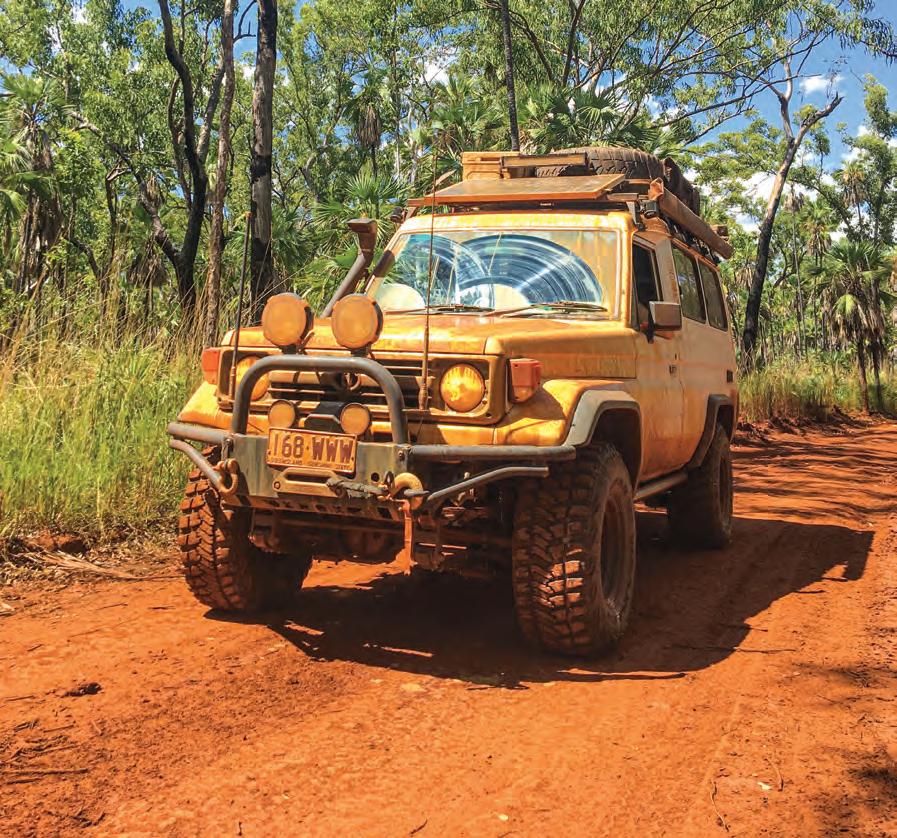 By Benedict Smith
By Benedict Smith
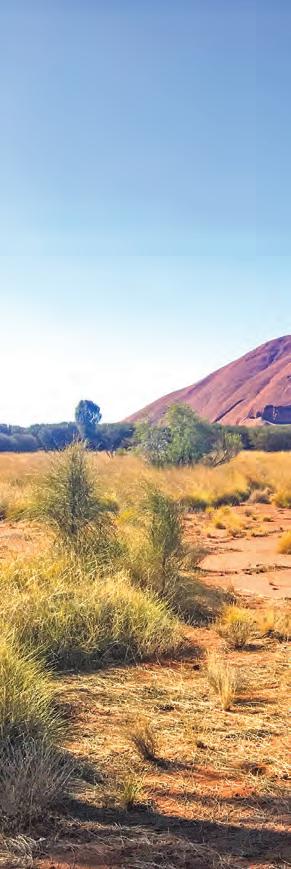
The LANDCRUISER Legend
The go-anywhere, two-up tourer.
54 Western 4W Driver #118
It is no secret among the 4WD fraternity that the Toyota badge commands respect and admiration, even from those that own the ‘other’ big name brands.
The Toyota LandCruiser has become a legend, particularly in the land down under and none more so than the mighty LandCruiser Troop Carrier.

The earliest LandCruiser, a prototype named the BJ, was produced in 1950 and designed for the Japanese military. The BJ was powered by an in-line, six-cylinder, 3.8 litre OHV petrol engine. It competed with the US Willys Jeep and the British Land Rover and was successfully launched to the general public as a very capable off-road vehicle. The LandCruiser was born!
Following the Second World War and Japan’s recovery, Toyota had future plans to export its domestic vehicles to overseas markets. It was during this time, from 1956 on, as part of the company’s tactics, they
called the foreign release, the LandCruiser strategy. And they knew their product could hold its own against rivals Land Rover and the Willys Jeep.
The LandCruiser assisted Toyota in establishing a foothold, with the idea of selling passenger cars to the growing export market. And while these early model LandCruisers were running simple petrol engines with very modest outputs, the decades that followed saw the development of higher powered petrol models and a variety of diesels.
First introduced to Australia in the late 1950s as a 2-door, long-wheelbase LandCruiser wagon (LandCruiser 20-30 series, 1955-60), the earliest variants were very rudimentary vehicles and this formed the basis of their legendary status.
The FJ25 was one of the earliest to be put to work on Australian soil. Leslie Thiess, then boss of Thiess Constructions, won an
Why the Toyota Troop Carrier is regarded by many (including the author!) as the ultimate tourer for outback adventures.
HJ75 Troopy.
Photo: Marc Rowley
Western 4W Driver #118 55
$18 million contract to build a tunnel at the famous Snowy Mountains Hydro-Electric Scheme in NSW. He needed a tough-asnails vehicle for the largest engineering project ever undertaken in the country. He found exactly that in the LandCruiser. Impressed by the no-nonsense nature of the FJ25 and meeting with then Toyota president Eiji Toyoda, Leslie secured the Australian import rights and purchased 13 vehicles to work at the Snowy Mountains project. The vehicles had a few issues, notably gearbox and front axle troubles because the working environment was very tough. However, the industrious Japanese came to the aid, with engineers sent to the project to rectify the issues. They had new parts flown out and sent broken pieces back to Japan. The engineers and designers could work out the failures and come up with solutions in-house.
Despite the issues, these early LandCruisers quickly gained a reputation for toughness and reliability, qualities which have endured to the present day. They became the preferred choice of vehicle for industrial, mining and agricultural work and the intrepid traveller across Australia.

When the FJ model arrived (FJ25 and 28), it was powered by a 3.9 litre petrol engine and mated to a four-speed manual transmission, with the front-wheel drive engaged by an additional lever. An ultralow crawler ratio provided first gear in the
transmission and there was no low/high transfer case.
The renowned 40-series LandCruiser was introduced in 1960 and was dubbed the FJ40 (F for the engine type, J for Jeep). Despite the 40-series' similarity to the previous model, it was a revolutionary product. The model was given an upgraded three-speed main box and dual-range transfer case, improving on the 20-series. Better assembly techniques improved the end product and the new two-speed transfer case betters the 4WD off-road capabilities.
A number of wheelbases and body options followed, such as the popular FJ45, 4-door wagon and the earliest long-wheelbased Troop Carrier, the FJ47. From the mid 1970s a diesel engine replaced the old petrol (with BJ and later HJ models), making it suitable for long distance travel.
There are some fine examples of the ‘47 series still in use in the country and Northern Territory local, Luke Drennan has a unique looking FJ47 Troopy, nicknamed ‘Zombie’. Luke said he built his creation with spare parts into the beast it is today. Riding on 38-inch rubber, powered by a 350 Chev V8, 5-speed and dual lockers, it is an off-road animal!
The FJ47 and FJ55 soon grew in popularity and many family holidays were made possible with the reliable old girls. By 1975, a larger 2F-type 4.2-litre, inline-six cylinder 40-series crossing the Pentecost.
56 Western 4W Driver #118
Photo: Luke Drennan
was added to the line-up. This engine would power the LandCruiser until 1983.
With recreational 4W driving on the rise and a few after-market manufacturers producing some basic bolt-on goodies, the popularity of the Troopy as a tourer was in its infancy. It would earn its cult status over the following few decades as each model improved on its predecessor.

The introduction of the 70/75 series LandCruiser in 1984 replaced the 25year reign of the 40 series. The styling became more angular and there were short-wheelbase, medium and longwheelbase variants. The latter came in both cab-chassis/utility and Troop Carrier models. There are plenty of 75 series Troop Carriers on adventures around Oz today. They can be found in the back streets of suburban Sydney to the outback towns and communities of Western Australia.

One prime example, belongs to Marc Rowley from North Queensland, who has built his HJ75 into a go anywhere, two-up tourer. In fact, he took it on a 34,000km lap of Oz in 2019, starting and finishing in Airlie Beach. Marc said he was blown away by the support he received from fellow Troopy Legends on the Troop Carriers of Australia Facebook page. The TOA family are likeminded folk with a passion for all things Troopy related. And if Marc had a question or needed advice on his rig, he knew where to go. With almost 10,000 members in the group, there was no problem Marc could not overcome. The mighty HJ75 now has a little more than 500,000 kays on the clock and is still going strong!

The 70s became popular with the Northern Territory Police Force, mine sites across the country, backpackers and government departments Australia wide. What other vehicle could carry up to 11 people over some of the toughest terrain and clock up half a million kays or more? Surely there would be units out there that have travelled over a million kilometres and still in use.
The 70-series cemented its reputation with the arrival of the 1HZ, 4.2-litre, straight six diesels and has endured longer than any other LandCruiser model. The late 90s saw the introduction of a coil-sprung front end (78-series), doing away with the leaf packs of the 75 models. And since 2007 have had the 4.5 litre, V8 turbo-diesel turning the wheels.
The 78s have been around since 1999 and to complement the coil-sprung front end, also gained longer leaf springs in the rear, five stud wheels (replacing the six stud 75s), new front indicators, grill and a redesigned steering wheel.
FJ47 Troopy, 'Zombie'.
JOIN ME ON AN ADVENTURE TO REMEMBER Custom 4x4 Adventure tours throughout the KIMBERLEY Tag-Along 4x4 Tours & small group specialists www.kimberley4x4tours.com.au Western 4W Driver #118 57
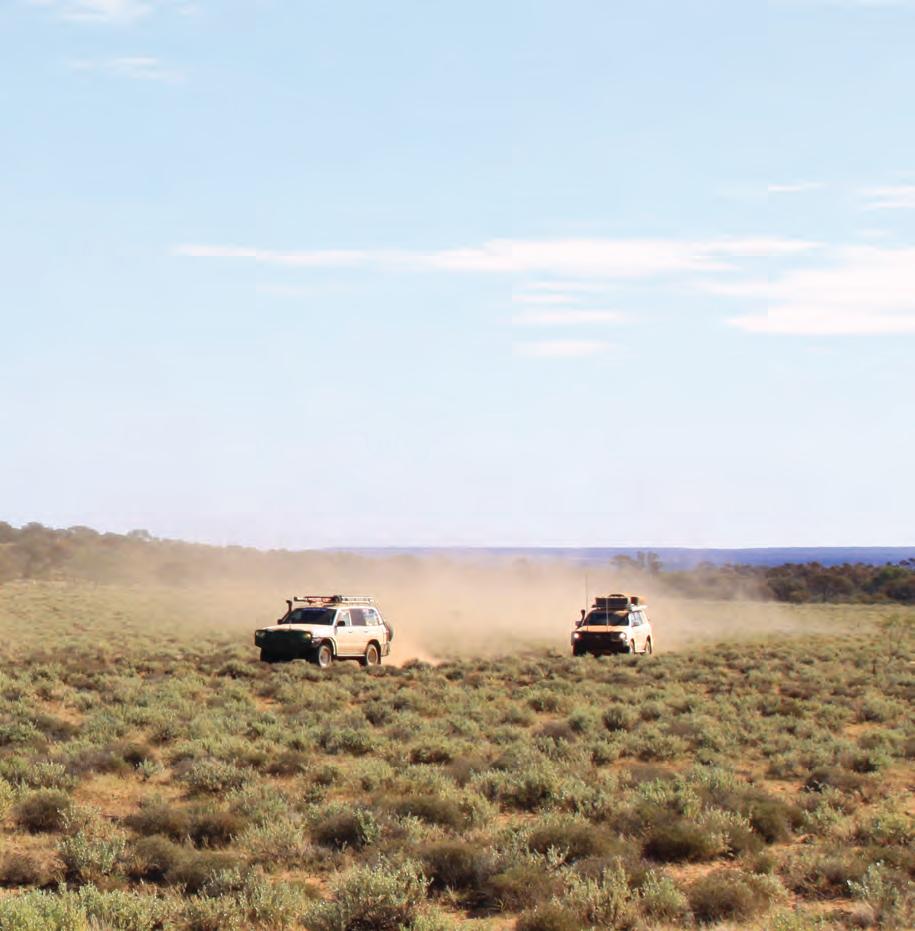

REPCO AUTHORISED SERVICE CENTRE AUTHORISED SERVICE • Ironman 4X4 Accessories • Mechanical service and repair • Log book servicing • Full auto electrical service • Satellite phones and communications 1/35 Great Eastern Highway, Kalgoorlie Phone (08) 9091 4797 www.goldfieldsoffroad.com.au Keeping you on the road ... even when you’re off road Exciting new showroom & product range now available!
Marco Kettelhake, a Kununurra local in the East Kimberley, previously owned one of the finest examples getting around. He and his partner Mona spent days, weeks and months planning their build and kitting out their beloved 78 Troopy for an extended trip around the country. They set off at the end of the wet season, 2018 and headed clockwise on the trip of a lifetime. The author wanted so badly to join his mates and his own 78 series was begging to go on an adventure but hey, that is another story!



Marco and Mona had built, in their eyes, the ultimate, 2-up tourer for their needs. And that folks, is the beauty of the Troop
The options are endless when it comes to fitting out your vehicle.
Carrier. There are so many ways of modifying them to suit your exact needs. Be it an 11-seater for carrying the footy team, a five-seat RV for Mum, Dad and three rugrats or in this case, the perfect platform for a couple to travel the nation in relative comfort.
There are so many incredible aftermarket accessories and gadgets these days for our 4WDs, it can get overwhelming building a doit-all rig. As long as you do your research, find out what modifications are legal and what are not and most importantly, get them certified by an engineer. Removing or adding seats to a Troopy is a common mod, as many owners will tell you, the factory seats leave a lot to be desired. But with smart planning, doing your homework and getting the necessary paperwork to have your cake and eat it too, will have you smiling for thousands of k's to come.
With the back chopped off, this set-up is perfect for Ian and Michele's camping trips.
Photo: Ian Harvey
Western 4W Driver #118 59
Speaking of smiling, the V8 Troopy owners don’t seem to frown much. And why would they, when they have that sweet sound of a 4.5-litre turbo diesel under the bonnet. The 1VD-FTV as it is commonly known, arrived in 2007 along with a wider front axle/track and wider chassis to accommodate the new powerplant. It was available in the Vdj-78 Troopy as well as the 79 series cabchassis and later the 76 series wagon. And it has earnt serious credentials as a reliable and smooth operator, capable of being tweaked for higher horsepower and torque for those wanting a bit more.
For the first time, a higher spec GXL was also introduced for the cab-chassis and luckily for us, the Troop Carrier. Which brings us to a rather unique build and one that has to be seen to be appreciated. Kimberley locals, Ian and Michele Harvey have possibly one of the most modified and interesting V8 Troop Carriers we have come across.
A 2008, Vdj-78 GXL Troopy, with more fruit than he could poke a stick at, Ian knew he had the perfect vehicle for his needs. It would serve the family duties for several years before he and Michele made the decision to chop the back off and transform it into their perfect 2-up tourer. It actually took five years and four different remakes of the rear to settle on the current setup!
The whole project has been professionally done and engineer certified and Ian and Michele certainly make the most of their one-of-a-kind Troopy. They spend just about every weekend camping and exploring their backyard and Ian is still finetuning the setup. You just have to see it to really appreciate the dedication, the time and effort put into it.
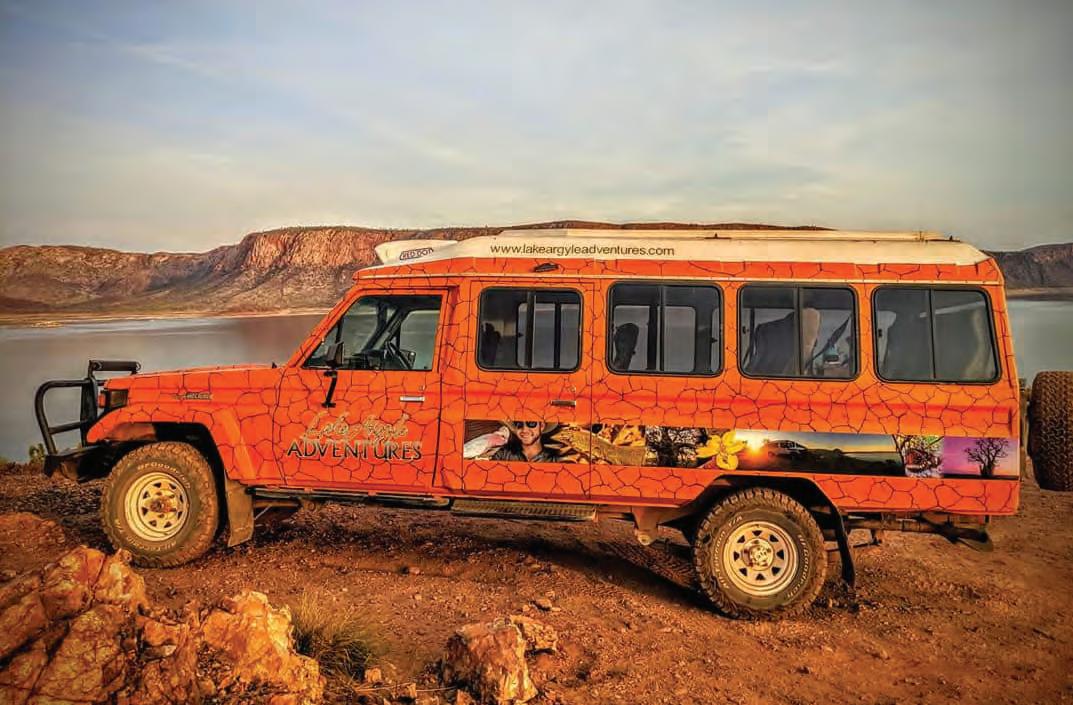
And that folks, is why we own the vehicles we do. We rely on our pride and joy to get us there and back again and we put in the time and effort to make them more capable and more comfortable. Ask any Troopy owner and they will tell you there is no perfect setup but with the right platform and time and a lot of patience and $$, you can modify them to the nth degree.
For more than 60 years, the LandCruiser has remained a favourite among the increasing number of foreign imports. The simple engines, tough-as-nails drivelines and rugged build quality, earned them serious credentials across the globe, from the FJ25 to the current model LC78 Troopy. A real testament to the enduring brand, the LandCruiser Troop Carrier has cemented its place in history as a true legend in the Australian 4WD scene. A legacy that may outlive religion.
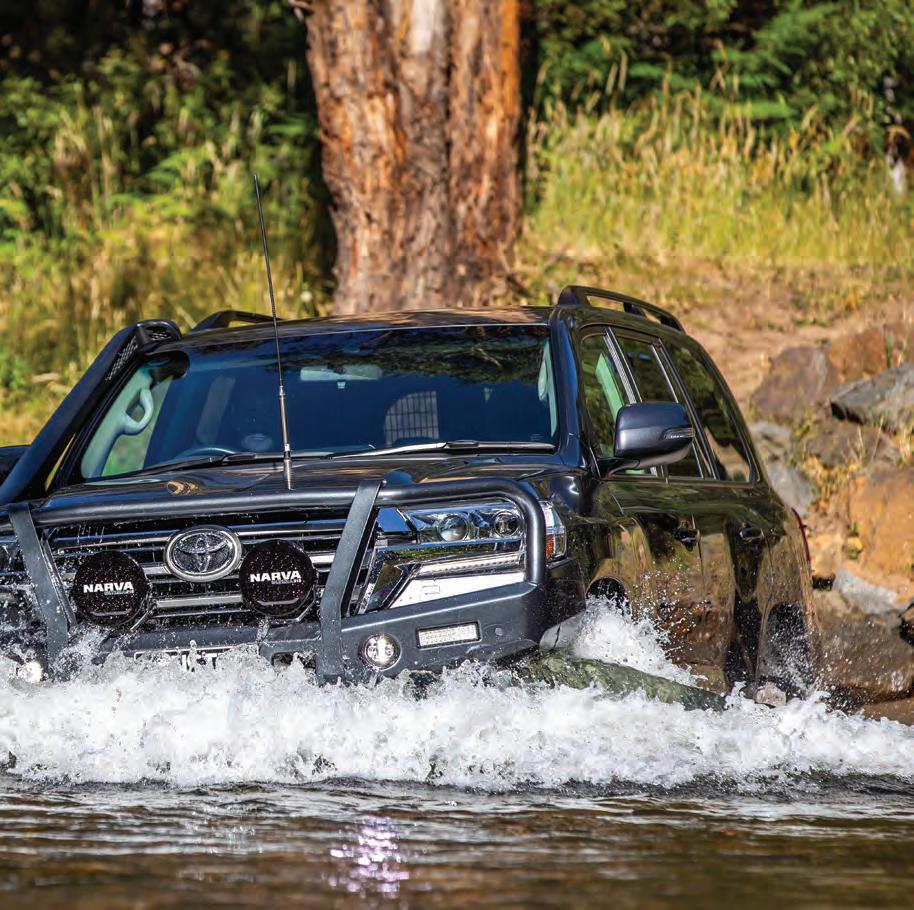 Arkana Troopy.
Photo: Josh Melville
Arkana Troopy.
Photo: Josh Melville
60 Western 4W Driver #118



Distributed by Brown & Watson International Pty. Ltd. www.narva.com.au National Toll Free: 1800 113 443 *30% more light than the equivalent sized first generation Ultima High Powered Driving Light. 30% BRIGHTER* The newly upgraded Ultima L.E.D 180 and 215 MK2 Driving Lights now produce an unbelievable 30% more light output with a 20% longer beam.* ultima .com.au See the best lights we’ve ever made at ULTIMA L.E.D MK2 HIGH POWERED DRIVING LIGHTS 30% MORE OUTPUT* BOLD BLACK EDITION AVAILABLE KIT 2 LAMPS & HARNESS
A pat on the back
 at theBy David Wilson
at theBy David Wilson
Australia possesses plenty of ripper 4WD destinations and South Australia has more than its fair share and amongst the best can be found in the north of the state.

The Flinders Ranges are an exceptional destination and it’s 4WD-friendly because of a now decades-old initiative of the locals.

Trackside erosion is what brings people here and makes for the challenge.

62 Western 4W Driver #118
Twenty-five
years ago they recognised that they could make a nice fillip to their and the district’s revenue stream by encouraging 4WD tourism. Having a network of trails kept people in the district, hopping from station to station and sharing the dollars around.

One of the most creative members of that clique of landholders is the Luckraft family of the Bendleby Ranges (42km NE of Orroroo). Jane and Warren, and now the next generation, Kylie and Charlie, set about blazing a network of trails across the hills on the property in their Bendleby and Hungry Range formations, the most famous trail being the Billy Goat Track, which for twenty years rated amongst the toughest in the region.
Up and down like a yo-yo on Yakka Ridge and getting some low range mojo going.
Not ones to rest on their laurels, they’ve had the dozer out to add more desire to their property with the creation of what the Luckraft’s call King’s Ridge and Pat’s Peak, a pair of trails that spin off old Billy Goat to complement the journey with some more white-knuckle experience for the uninitiated.
Bendleby is a pretty full experience, with excellent accommodation and camping, walking, hiking and mountain-bike trails to support the 4WD activities. As much as I like my camping, I have to tell you there’s nothing better than coming back to base at the end of the day and laying my head to rest in a proper bed at either the Gumdale or Crotta homesteads, the Acacia Cottage or in the Shearers Quarters at The Springs.
Western 4W Driver #118 63
If you must camp then know that there are plenty of established campsites scattered through the hills where you can drag a tent, a swag or a camper trailer in and have your own private piece of Flinders nirvana. About the only hustle you’ll encounter could be from a mob of Apostle birds, Corellas or a passing skippy or three. It’s serene. Because of the nature of the hills and the gradients a lot of the steep trails are one-way only and from a management perspective it makes total sense because the loose screes get chewed out mighty quickly with a spinning wheel hovering over them.
To get to Pat’s we took a leisurely day-trip through the Hungry Range, coming from The Springs to the intersection at Lantern Gate before heading skywards. You’ll then bump into the meeting point of the Front Track and you guessed it, the Back Track. These are station trails, graded and in good condition, albeit a little dusty, that have been used to transport stock and attend to land management and fencing tasks.
Quick stretch en-route to Pat’s Peak. King’s Ridge razorback is a dozer scrape atop a soaring range.

The trail starts its climb towards Yakka Ridge where there’s a couple of lookouts that offer great views of the Minburra Plain below (600-odd metres below). Yakka is a great trail to get your low-range mojo going, tyre pressures reduced to a sensible and flexy 15-18psi range and first or second gear selected depending on how technical

64 Western 4W Driver #118
They come from all over South Australia and the world to tackle Billy Goat Ridge.


the section might be. The descent to Sandy Bore below is always a crowd-favourite, a couple of low-grip descents will have you skimming over the surface and reminding you that you’re merely a passenger whilst Mother Nature guides you down the hill. Hill-Descent Control be damned, it’s not going to offer any extra reassurance!
The Bush Banana (Marsdenia australis) is a central Australian bush tucker food and grows on a vine.
Back down on the flat between Sandy Bore and East-Side Bore you’re running with the Hungry Range on your right-hand side and heading south. You’ll likely see goats roaming the woodland that’s largely Black Oak and Bullock Bush. The really observant amongst you might see the vine of the Bush Banana twirling around the trunk of a host tree and the pendant avocado-sized and shaped fruit.
 Prado tippy-toe at Yakka Ridge.
Prado tippy-toe at Yakka Ridge.
Western 4W Driver #118 65
From East-Side it’s all up again and straight into Billy Goat.
The ridge section is steep and not for the faint-hearted and a word of warning, once you commit there’s no turning around, no time for panic or tears for fears, just grit your teeth and send it … gently. Sending it hard might spell doom. We observed that a recently cracked sump had dumped a tell-tale ribbon of black diesel oil up the hill, making navigation a breeze, but you’d wonder about that engine’s longevity?
The passage of time and countless vehicles has worn this track to its core, regularly you’ll bump into rock steps of embedded shale with razor sharp edges and requiring more articulation out of your suspension than the maker likely provided. So lock up that back axle, grab first or second again and tippy-toe to the summit knowing that you’ll likely need to get out to do some road-building.
On the ascent Billy Goat doesn’t suffer fools and traction is the name of the game. Luckily this generation Prado has great traction control.
If you’re scared of heights don’t look out the side windows because the valley floor is a long way away and as a driver, grabbing the occasional glance in the rearview mirror is likely to give you a moment of panic. It’s steep.
On our most recent visit we were driving a couple of stock-standard utes, a new 2021 Isuzu D-MAX X-Terrain and a 2020 Mitsubishi Triton GSR, both running passenger car tyres and typically closer to Flinders Ranges earth than I’d like. Thank goodness they both had diff-locks which balanced out the badness. You see, sidesteps are a liability in this sort of country and inevitably they’re going to touch down.
The score midway through the account was Rocks 2, Sidesteps 0. Yep, they got whacked and twisted, the Isuzu’s to oblivion and the Triton’s able to be straightened once home. Another casualty was the Triton’s mass-balance dampener, a lump of metal hung off a bracket at the front of the rear diff that’s awkwardly exposed to rock impacts. We did.

66 Western 4W Driver #118
This is what happens when manufacturers don’t take 4W driving seriously. Triton has this lump sitting in front of the rear diff and it’ll always get clobbered.


Atop Billy Goat you can step out of the car (if you made it this far) and give yourself a pat on the back because you’ve just knocked off one of the hardest trails going for a noncompetition, registerable 4WD. Suck in that clean outback air and take a panorama of the location because it’s stunning! But don’t get too cocky because after you make the top turn and head right (north) and past the traditional descent down to the Three Gates intersection, continuing gets you on to King’s Ridge.

Had to whip the phone out to immortalise the trail in that moment … knees make for great steering.
Try as hard as you might you’ll inevitably touch down on a lump of quartzite that won’t yield.
This bulldozer scrape runs atop the main Hungry ridgeline and follows its contours and does very little to flatten them. Up hill and down dale you’ll go splitting the rarefied air between Yuruga Hill and Eke Hill.
It is a bit tamer than Billy Goat and I’m OK with that because I know in time it’ll erode and become every bit as craggy as Bee-Gee and I look forward to seeing that evolution (err erosion). In a decade it’ll be banging on a ten on the Gnarly-Meter.
I was a little incredulous with the first ascent, so much so that I had to whip the phone out to take a pic of the Triton ahead of me. My co-pilot Steane took exception to me steering with my knees whilst snapping the moment. I couldn’t see what the problem was?
Watching the sidewalls of the tyres flex over those pointy bits had me wondering whether we’d bitten off more than we could chew because passenger car rubber is junk. Luckily the rubber-Gods were smiling on us all weekend because pressure maintenance saved the day.
Picking an appropriate line required some spotting at times, so we took turns, alternating from behind the wheel and swapping the driving tasks or outside on some sighting moments for one another’s benefit when it was super-technical.
There’s nothing more likely to convey just how steep the gradient might be than hanging in the reassuring harness of your seat belt and on plenty of occasions in the descending phases that was our experience. Somehow goats thrive in these conditions, their surefooted and unfearing gait sees them flanking us on hills just as steep and doing it without vehicular assistance.
Eventually Pat’s Peak is reached, not sure of the height as I didn’t have a gadget to record the altitude, but I can assure you you’ll find more typically breathtaking views unfold and all around that look like they could reach all the way out to Broken Hill given half a chance.
After a couple of hours amongst the clouds, the spinifex and the rocks, the trail heads back down to the plains and their intersecting creek beds with the familiar River Red Gums and paddocks recently refilled with sheep. Life out here is pretty tenuous and the drought of 2019-2020 resulted in totally destocking the property to preserve what little vegetation there was. Winter and Spring rains in 2020 repaired a lot of that harm and now the yards are alive with plenty of bleats and baas.

Another steep descent near Yuruga Hill.
Pat’s Peak panorama over Minburra Plain.

BOOKINGS ARE ESSENTIAL Call Kylie on: (08) 8658 9064 Email: admin@bendlebyranges.com.au www.bendlebyranges.com.au
68 Western 4W Driver #118






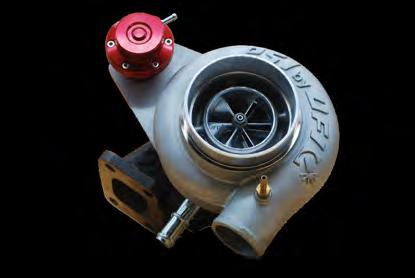
FUEL INJECTION UNITED AND TURBOCHARGER SALES AND SERVICE • • • • • • •
John Forrest is without doubt one of WA’s favourite sons. Not only was he a surveyor, but also an explorer, and he led three major expeditions into uncharted country. He also became the first Premier of WA, and upon moving to federal politics held various ministerial positions including acting Prime Minister. He was knighted in 1892 and in 1918 he was recommended for a barony, however he died from cancer on the sea voyage to England and was buried at Karrakatta.
His most famous expedition was in 1874 from Geraldton to the DarwinAdelaide telegraph line. He left Geraldton on 1st April 1874 with a party of six men (including his brother Alexander), 20 horses and eight months provisions. We take up his expedition north of Wiluna and follow it via various landmarks through to Alexander Spring.
Reaching the area of today’s Canning Stock Route (CSR), Forrest discovered a large water hole on Kennedy Creek and named it Windich Spring after Tommy Windich, an Aboriginal guide. At Windich he blazed a white gum F41, being his 41st camp since leaving Geraldton. The tree still survives but the blaze has long been overgrown. Continuing northward he then discovered and named Pierre Spring (later CSR Well 6) after Tommy Pierre, another Aboriginal guide.

ofIn the FOOTSTEPS
70 Western 4W Driver #118
Forrest again headed further northward, and on 2nd June he discovered “one of the best springs in the colony … and is as clear and fresh as possible”, he named it Weld Spring after Governor Weld. Weld Spring would later become CSR Well 9. Here he blazed a corkwood tree F46, it has long since disappeared, presumably burnt by fire. Forrest’s party was resting here when on 13th June a party of some 40 to 60
Aborigines attacked. They were repelled by gunfire. Forrest’s party then built a stone fort thatched with tree branches to keep them safe from any night attack. The ruins of the fort are still visible today.

Forrest conducted several short expeditions using Weld Spring as his base camp. Windich and Weld Springs are trackside on the CSR wheel track. Entry and exit to them is via Well 1 or Well 5 via Granite Peak Station or Well 9 via Glen-Ayle Station. Permits and fees apply.
By Phil Bianchi
Western 4W Driver #118 71
Leaving Weld Spring, Forrest’s party headed south-easterly in search of water. They camped near Mt Moore, named by Forrest after Mr. W. D. Moore from Fremantle, a subscriber to the Expedition Fund.
Mt Moore, which provides extensive views from the south west to the south east, is located near the Carnegie Glenayle Road. It’s a relatively easy climb to the top where there is a plaque commemorating the 1974 Forrest Centenary retracing expedition led

by Stan Gratte of Geraldton. While camping at the foot of Mt Moore, Forrest blazed a tree F50. Nowadays the tree is dead and the remains of the blaze is lying face down in the dirt. We identified the tree after finding a shiny metal sign attached to it which was placed there by Robin Sharp in 1987. The tree had fallen over since then. Using fencing wire, we relocated the sign so it can readily be seen by passers-by. Our next quest was the blazed tree at Camp F51. We had prior approval to search for the tree which was deep within Carnegie Station country. After many fruitless hours of driving station tracks in search of the
 Forrest's fort at Well 9 on the CSR.
Photo: G and D Sweetman
Forrest's F50 blazed tree at Mt Moore.
Forrest's fort at Well 9 on the CSR.
Photo: G and D Sweetman
Forrest's F50 blazed tree at Mt Moore.
72 Western 4W Driver #118
blaze, we made several satellite phone calls to Carnegie seeking more information and were then able to pinpoint the tree. The tree was still alive, but the blaze had been eaten out. Despite initially being unsuccessful in locating the blaze, the search took us through some spectacular country with ranges, mesas and a mosaic of trees and grasses.

We had permission to use station tracks to get to Carnegie Station to refuel and shower. Near Carnegie Station Homestead was Forrest’s eaten out F52 blaze on a live corkwood tree. It was at one of the waterholes on Cooringanarranda Brook. The remains of a grown over blaze cut by explorer Lawrence Wells on 31st July 1896 is also on this tree. While we were at Carnegie Station, we were told that around 10th January 2020 huge
rains drowned Glen-Ayle Station, with 200mm in 12 hours and Carnegie Station, further southward, had a record-breaking 270mm in 24 hours. Creek banks burst, with some of the station roads being under 4m of water. Although the rains were welcome, there was huge fencing loss, significant track damage and many cattle were drowned; some of which were lodged in trees.
 Forrest's F51 blazed tree.
Forrest and Well's F52 blazed tree.
Forrest's F51 blazed tree.
Forrest and Well's F52 blazed tree.
Western 4W Driver #118 73
The manager at Carnegie Station also told us that soon after the rains, around the homestead, hundreds of turtles dug their way to ground level. My alter ego, Truthful Phil, ever on guard against reprisals was sceptical about this. He had heard of burrowing frogs but burrowing turtles! Anyway, back in civilisation the internet tells of a flat-shelled long-necked turtle, Chelodina steindachneri, that inhabits the area and that they have evolved to survive the harsh conditions by being dormant between rains. Truthful Phil’s caution was placated, declaring Australia’s animals never cease to amaze.

On the Gunbarrel Highway and heading eastward and then southward along the David Carnegie Road, our next target was Forrest’s Camp F59. The turn off to the camp is located 40km south of the junction and then 4.5km east. We located the blaze on a living gum tree, but it was eaten out long ago. Northward of the blaze, some 1.6km away is a large rockhole Forrest named Windich Rockhole after Tommy Windich, who found it. This rockhole is usually dry, but on some occasions there is water in it although it may be covered in animal faeces and green slime. A visit
 Forrest's F59 blazed tree.
Windich Rockhole.
Forrest's F59 blazed tree.
Windich Rockhole.
74 Western 4W Driver #118
to both features is worthwhile but they can be difficult to find because they are rarely visited, and the wheel pad to them is basically non-existent.
While Forrest continued his traverse eastward, we returned to the Gunbarrel and continued east, then took the Hunt Oil Road (HOR) southward. Geraldton Bore, with a hand pump, is located at the junction. This spot also offers great camping among the trees. Please note that while the hand pump functions most of the time, don’t rely on it. Have a backup plan in case you cannot get water there.
The HOR is a well-used track, with the top end traversing vast open plains of spinifex, growing almost wheatfield like. However, despite being well used, early in the season the spinifex growth on the track can be a dangerous problem with a high risk of under vehicle fires. Do fit a spinifex guard on the front of your vehicle and regularly check for spinifex build up and remove it with gloves and a billy hook.

Approaching Sutherland Range, which is some 106km south of Geraldton Bore along the HOR, the country drops some 40m in elevation and the creek lines, mulga and gum trees become more prolific, providing numerous camping opportunities.
Forrest arrived in the area on 13th July 1874 and spent some time here exploring and naming features. He named Mt Allott and Mt Worsnop after the Mayor and Town Clerk of Adelaide respectively, and nearby the Alexander Spring after his brother and expedition member. Mt Worsnop, a mesa, provides 360˚ views of the desert and the range; Mt Allot, a prominent headland of the range provides extensive views north, west and south with Mt Worsnop being prominent. On top of Mt Allott is another Stan Gratte 1974 Forrest Centenary retracing expedition plaque.
The vast plains of the Hunt Oil Road.
 Mt Allott plaque.
Photo: Alan McCall
Mt Allott plaque.
Photo: Alan McCall
Western 4W Driver #118 75
In naming Alexander Spring, Forrest was to cause much angst among future explorers and prospectors including Carnegie, Hubbe, Carr-Boyd and Woodhouse. This was because on arrival they expected to find a spring, only to discover it was not a spring but a rock hole and often it was dry.

To the south of Mt Worsnop is Woodhouse Lagoon, a freshwater lake that occasionally has water. Fossicking around the edge of the lake will often reward with stone artefacts of Aboriginal origin. By all means look, but please leave them where you found them.
Our trip following Forrest ceased here because we were unable to obtain permits for access or to travel further eastward due to the COVID-19 pandemic and no access being permitted to any Aboriginal communities.
Forrest continued his journey via Blyth Creek, Warburton Range, Fort Mueller, Skirmish Hill, Musgrave Range and completed the expedition on arrival at Peake Telegraph Station.

Following the 1874 expedition of Big John, as he was often called, was a most rewarding trip. Finding Forrest-named features, together with the blazed trees, although eaten out, was incredibly special and being out in such striking desert country was awe inspiring.
 Alexander Spring.
Local resident.
Alexander Spring.
Local resident.
76 Western 4W Driver #118

Permits are required for CSR access. Application can be made online at: permits.canningstockroute.net.au Permit requirements for access to the Gunbarrel Highway, David Carnegie Road and Hunt Oil Road may have changed due to the Gibson Nature Reserve coming under joint management with the Ngaanyatjarra people in late 2020. Check this site: www.ngaanyatjarra.org.au or www.dplh.wa.gov.au/entrypermits For access to any pastoral station always seek permission beforehand as your presence may interfere with mustering or other station work. Fees are payable for access to and from the CSR via Glen-Ayle Station (08 9981 2989) or Granite Peak Station (08 9981 2983). Other than travelling on the Gunbarrel Hwy or Carnegie Glenayle Road, permission to travel on Carnegie Station is required (08) 9981 2991. Carnegie Station sells fuel and at the time of our visit it was $2.50 per litre. They also provide camping and have dongas available as well. For a comprehensive CSR travel guide order a copy of The 4W Driver’s Guide - Canning Stock Route by Phil Bianchi www.western4wdriver.com.au/shop John Forrest’s expedition journals are published in Explorations in Australia by John Forrest. INFORMATION BAY Have you got yours? Travellers can use this guide to plan their trip using the wealth of information provided along with detailed Hema maps showing the location of all the wells and other sites along the length of the CSR. Order your copy today from www.western4wdriver.com.au/shop $39.95 Western 4W Driver #118 77
By Grant Hanan & Linda Bloffwitch
If you’re ever planning on travelling to remote areas without a fuel or supply stop within cooee, we’ll be the first to put our hands up and say travelling with other vehicles is the wiser and safer option. At the very least, travelling with a second vehicle means you won’t be left stranded if things go pear-shaped. Although travelling with a bunch of others has its benefits, you might just find it’s not always roses. In fact, it’s never fun watching a potential war break out after someone’s bacon and egg cook up isn’t ready by wheels up time. At the end

of the day, it’s all about compromise when travelling in a group. With that said, you do have a choice. You can either tolerate the group and accept you may not get to do everything you want, or you can try going it alone.
This is where travelling as a solo vehicle has its benefits. For starters, you’re not choking on others’ dust. Then, when any dust is made, it’s your own and going behind you. And if you’re travelling somewhere and pop over a rise, it will be high-fives when you’ve been the first to see wildlife in its natural
Want to travel solo but don’t know where to start?
Grant and Linda have travelled this way for years, and share their tips on how to safely hit the tracks as a single vehicle.
Solo GOING
78 Western 4W Driver #118
habitat. Nor do you need to worry whether you’re making too much noise at camp, and you don’t need to collaborate with others about changing travel plans at the drop of a hat. These are just some of the things that make solo vehicle travelling appealing. But make no mistake. Being a single vehicle travelling remotely and complacency don’t go together. In fact, it could kill you. While that might sound a bit melodramatic, it can, and does happen. Nobody ever wants to hear you’ve made the news for all the wrong reasons. Yes, disasters can happen

 Travelling solo means no noisy neighbours to contend with.
Travelling solo means no noisy neighbours to contend with.
Western 4W Driver #118 79
to the best and most experienced travellers, but being prepared and having anticipated an event means you’ve already thought about it and what you might do when things go south.
So what can you do? Well, no doubt you’ve heard the saying that prevention is better than cure. Start by developing a maintenance check procedure for your set-up well before leaving home, so you can follow it on a daily basis while you’re on the tracks. The types of checks on this list should include things like checking under the bonnet for fluid levels, and crawling underneath to look for any
Remember to regularly check up top in case any gear has come loose.


Performing maintenance checks is simply part of our daily routine.
leaks and anything that might be working loose. Also, always check wheels nuts, especially when you’re travelling on corrugated roads. Remember to add in checks of your roof racks and all the items kept up top to your list, and regularly give the hitch assembly, suspension and tyres a once over if towing. The check should take no longer than 10 minutes daily and should become part of your morning routine just like having that morning cuppa. Let’s look at some other things to consider if you’re travelling as a solo vehicle.
 Something we came across during one of our trips.
Something we came across during one of our trips.
80 Western 4W Driver #118
BREAKDOWN
A breakdown of any sort will test your level of mechanical knowledge and reasoning. Naturally, a wellmaintained vehicle goes without saying, but having it serviced by technicians who understand your type of travel and the expectations of your vehicle while travelling is a top priority. This is also the time to have any extra things checked and serviced. Servicing and spare tyres are two of the basics to address if towing, and it’s a massive bonus if your trailer can have the same wheels and tyres as your vehicle so they’re all interchangeable. The main trailer failures we’ve come across on the tracks are generally suspension related. You know, things like wheel bearings, broken springs and hangers, and hitch coupling fatigue and breaks. Basically, your camper needs to be capable for tackling the tracks your vehicle can take you to. You also should be carrying the right spares so you’re prepared if things go pear shaped, otherwise the worst-case scenario may mean you have to unhitch and leave the trailer behind to get help.

The owner of this would have had a rude shock when they eventually stopped down the track and found it missing.
TYRES
After destroying a tyre while using tyre sensors we’ve now upgraded to a more reliable brand.
We’re not talking a simple puncture here, but where someone’s spare is already cactus, another tyre’s gone flat, and they don’t have a plug kit. We’ve also seen others on the track who are carrying plug kits, but the puncture is well beyond plugs and where a patch and glue, possibly even a tube would be handy to get them to the next town. This is why you need to carry the tools and have a bit of know-how to keep you going. We’ve even seen brand new tyres get a puncture where the driver didn’t know it and kept on driving until the tyre was wrecked. Ok, we’ll put our hand up for that one. Things could have been different if we had good tyre monitoring equipment as an early warning device (which we thankfully now have after replacing our old one that let us down too often).
FLAT BATTERY
This one happens to the best of us. Accidently leave a door open or an accessory on and you’ll find the battery drops overnight to a point where it won’t crank the engine over. The simple solution here is to have a second battery that’s capable of crank starting through an isolator switch or even from jumper leads. It’s also easy enough these days to carry

Western 4W Driver #118 81
a small battery jump starter pack in your vehicle, but test it before leaving home to make sure it can start your vehicle. Another option is a solar solution of sorts to recharge the battery, but you may have to sit around while it recharges.
BAD FUEL
This isn’t uncommon in remote places when fuel can be stored in a range of tanks. And while it may take longer to fill, use a fuel filter funnel from the beginning to ensure the fuel isn’t contaminated. We also like to carry spare fuel filters, so you just need to know how to change one. It’s also handy to know what process your vehicle has for re-setting any alarms, so do some research before leaving home. This isn’t something you want to learn out on some remote track.
fabricate and make a range of brackets to get us going. Lastly, with some vehicle batteries and a stick welder, it’s possible to repair broken metal parts. You can’t rely on some passerby to lend you that shifter you need, so tools and spares isn’t an area to skimp on for solo vehicle travelling.

COMMS
We wouldn’t contemplate any remote travel without taking a fuel filter funnel.

SPARE PARTS & TOOLKIT
Our kit has a very good bottle jack, some hand tools, spanners, screwdrivers, hammers etc., that we always travel with. We also like to include a battery handheld drill, grinder, saw and a rattle gun. Using this combo plus having some pieces of steel plate, various nuts, bolts, pop rivets and a pop rivet gun, we can pretty well
Your mobile phone isn’t any good to you the minute you’re out of phone service, so we carry a satellite phone with a comprehensive list of numbers to call for help in the case of emergency. If we can’t fix the issue ourselves, it’s peace of mind knowing someone could possibly talk us through a vehicle problem to get us going again. Or it could be that you’re making that call for someone to come to you. But knowing who you’ll be calling before you’ve left home and what process you need to follow, adds a bit of comfort that there is help available if needed.
A satellite phone can sometimes be your only contact to the outside world.
 You might only use it once on a trip, but you’ll be glad you’ve got it if you need it.
You might only use it once on a trip, but you’ll be glad you’ve got it if you need it.
82 Western 4W Driver #118
TT-VJ33 $1350
TT-VJ38 $1350
TT-VIGM $1350
TT-VI58 $900
TT-VIBR $900
TT-VIDW $1350
TT-49135-07310 $1350
TT-VIEZ $1350
TT-K0422-582 $1350 + gst
3.2L Pajero TT-49135-03410 $1350 + gst
Mitsubishi Pajero 4M41 TT-VT13 $1350 + gst
Mitsubishi Pajero 4M41 RHF5 3.2L TT-VT12 $1350 + gst
Mitsubishi Triton TT-49135-02912 $1350 + gst
Mitsubishi Triton / Challenger RHV4 4D56 2.5L 100 Kw TT-VT10 $1350 + gst
Mitsubishi Triton / Challenger RHV4 4D56 2.5L D-ID 100 Kw TT-VT16 $1350 + gst
Mitsubishi Triton 4M40T 2.8L TT-49135-03130 $1350 + gst
Nissan Navara 3.0L ZD30 D22 1411-9S00A 170 Kw TT-HT12-19D $1350 + gst
Nissan Navara D22 2.5L RHF4H TT-VN4 $1350 + gst
Nissan Patrol HT18 TD42T Y61 GU watercooled TT-14411-62T00 $1350 + gst

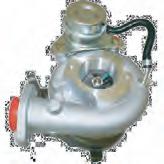
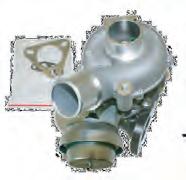
Toyota CT20b 100 series 1HD-FTE TT-17201-17040 $1350 + gst
Toyota CT26 80 series 1HDT TT-17201-17010 $1350 + gst

Toyota Hi-Ace TT-17201-30180 $1550 + gst
Toyota Hi-Ace TT-17201-30200 $1550 + gst
Toyota Hi-Lux / Prado / Front runner 2.8 L TT-17201-11080 $1550 + gst
Toyota Hilux 3.0 L 1KZ-TE CT12B TT-17201-67010 $1350 + gst
Toyota Hilux 3.0L CT16VGT 1KD-FTV D4D TT-17201-30110 $1550 + gst
Toyota L/Cruiser 12HT 1HJ61 TT-17201-68010 $1350 + gst
Toyota L/Cruiser 1VD-FTV V8 twin turbo LC200 series TT-VB22 $1850 + gst
Toyota L/Cruiser 1VD-FTV V8 twin turbo LC200 series TT-VB23 $1850 + gst
Toyota Prado 3.0L CT16VGT 1KD-FTV D4D TT-17201-30160 $1550 + gst
484 Great Eastern Highway Ascot WA 6104 m: 0418 922 018 | p: (08) 9478 2144 | f: (08) 9478 2166 e: sales@turbotech.com.au | w: turbotech.com.au CALL +61 8 9478 2144 WeWantToGiveYouABoost Brand new highest quality | 12 months conditional warranty Each unit fully tested prior to sale | OEM quality and performance Trade and volume discounts if applicable TURBOTECH BRANDED TUrbochargers Price List Ford / Mazda Bravo 2.5L RHF5 B2500 TDCI
+ gst Ford Ranger/ Mazda BT50 3.0 J97MU 115 Kw
+ gst Holden Colorado RC 3.0 L
+ gst Holden Rodeo <97
+ gst Holden Rodeo 98-2002
+ gst Holden Rodeo Isuzu Dmax
+ gst Hyundai KIA / SANTA FE 2.2L CRDI TF035
+ gst Isuzu Dmax / Holden Colorado 4JJ1 3.0L
+ gst Mazda CX7 Petrol
Mitsubishi 4M41 TF035 early
SURVIVAL TECHNIQUES
We’re not suggesting you need to be a Bear Grylls of sorts on the tracks, but you are responsible for your own wellbeing. Chat to your doctor about your travel plans well in advance and fill any medical prescriptions you need before you go. We treat our health checks no differently to those of our vehicle and camper, so they’re done well in advance. Having a good understanding of first aid wouldn’t go astray, so it’s always a good idea to jump on a course to keep up with the latest techniques. And while you can call for someone to talk you through an emergency with your satellite phone, don’t leave home without a comprehensive first aid kit. While you don’t have to carry every bit of gear in the kit so you’re a mobile hospital, you need a few more items than a packet of band aids and some panadol. We carry a few different kits that are scattered around our setup, and another is permanently left in a backpack which we use while bushwalking.
ACTION PLANS
You’re probably wondering what we mean by action plans, but it covers things like what you’ll do in the event of a fire, or if you need to be evacuated, what steps you’ll follow to make that call to be rescued. Or perhaps you have a vehicle accident, what you will do? Maybe you’ll travel with a personal beacon, and if so, where will it be
stored, and how will you use it? These are just a few of the things that can be included in action plans, but we think you get the idea. It all comes down to being prepared for that 'just in case' situation.
EMERGENCY SUPPLIES
If you’ve no other choice but to sit and wait until help arrives, it’s common knowledge that the golden rule is to stay with your vehicle. If this ever happens, our plan involves keeping out of the elements by erecting a shelter of sorts, making ourselves as comfortable as possible, and to simply conserve energy. For this reason, we always travel with an emergency supply of food and water, and we know how long that reserve can last if we had to alert authorities. And no, supplies doesn’t mean just carrying a couple of chocolate bars. It includes a range of tinned or packet meals and soups, and anything else that we’ve packed which is long lasting.
We don’t think you can ever be too prepared if you’re considering travelling as a solo vehicle, and complacency is less likely to set in if you can assess all the risks in advance. We live in a very big country and there’s loads to explore. Do the research, take the right approach, and you too can be on the receiving end of some sensational benefits that travelling as a single vehicle provides.
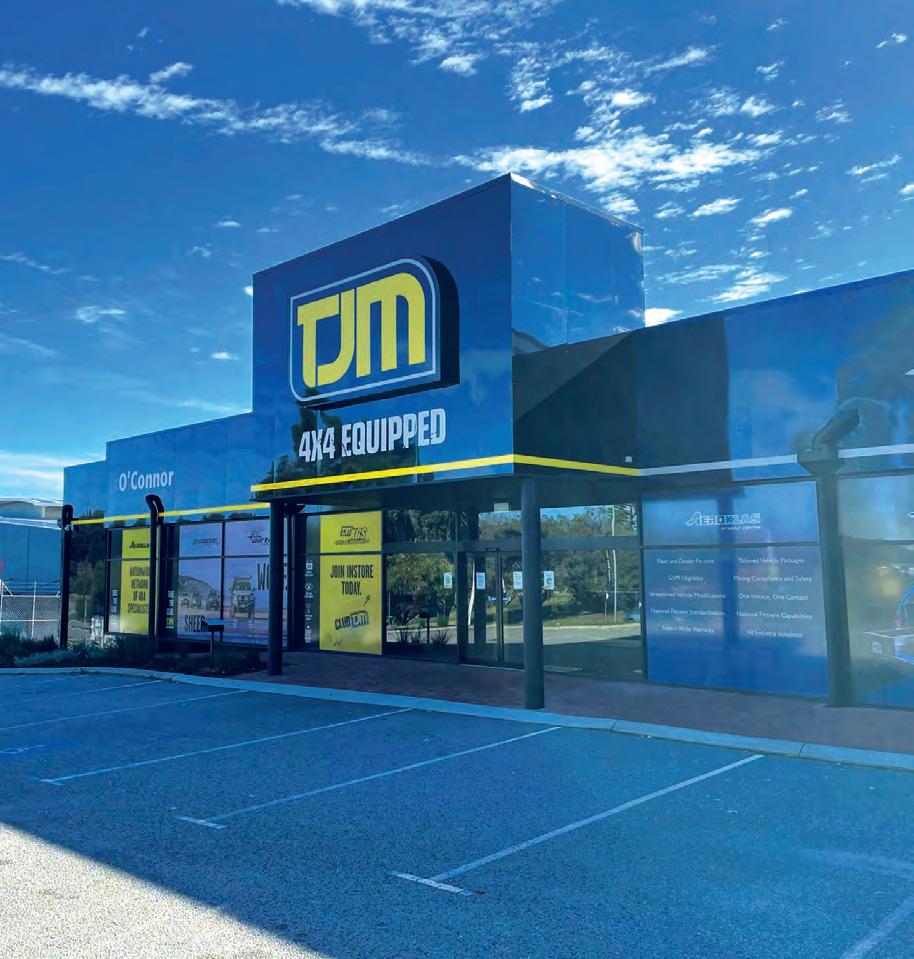
These guys had been stuck on the track for a day while waiting for someone to come and help.

84 Western 4W Driver #118


380 South Street, O’Connor WA 6163 Phone 08 6268 3200 O’CONNOR GET 4X4 EQUIPPED NOW OPEN
Nightscape
Disclaimer: Before you start reading this article, I am in no way a professional / master photographer. I am fully self-taught and learnt everything I know from reading articles and watching YouTube, so if I get the terminology wrong or I do things differently than the professionals, you now know why.
Everyone has their favourite hobbies or interests and for me it is 4W driving, camping and photography. As a result, I photograph some great places that only my 4WD can get me to. You don’t need a 4WD to do great nightscape photography but you do need a camera, equipment and some basic skills.

What is nightscape photography?
To me, nightscape photography is taking landscape images at night using the night sky with the stars as a back drop. Ideally, you will need an object as foreground interest and it can be anything as boring subjects during the day can become spectacular subjects at night, such as fence posts, old rusty vehicles, derelict buildings, your camping set-up etc.
Photography
Camped under the Milky Way.
86 Western 4W Driver #118
Words and Images by Karl Fehlauer / Westralian Images
You will also need to, in many cases, ‘light paint’ your subject by using external lights such as torches or strobes so that it stands out against the night sky. Light painting may sound difficult, but with some practice it becomes easier and I will explain the basics further on in this article. Images 1 and 2 (above) of Old Narloo Homestead in the Yalgoo Region are examples of this. Image 1 is taken using only available light, whereas Image 2 has had the homestead light painted in and you can see the difference it makes.
Sometimes, depending on the subject and time of year, you can use the moon to ‘light paint’ your subject and this will give a different effect all together. Another option is to use a combination of moonlight and light painting. Image 3 (over the page) is an example of using the full moon to light your subject. This image was taken at about 8.00pm and you can see that it lights up the church quite well. However, the downside is that you lose a lot of the stars due to the brightness of the moonlight.
In this article we'll concentrate on single exposure nightscape images only as taking multiple exposures and blending them into a single image is complex and requires a good understanding of masking and blending in post-processing software such as Photoshop.


 Image 1 - Narloo Homestead.
Image 2 - Narloo Homestead (light painted).
Image 1 - Narloo Homestead.
Image 2 - Narloo Homestead (light painted).
Western 4W Driver #118 87
what equipment do i need to do nightscape photography?

Firstly, you need a camera - obvious I know, but it doesn’t have to be a top of the line model or the most expensive one, as long as it works, that’s a start.
Secondly, you will require a lens and this is where it starts to become a bit more technical. Ideally, you need a lens that has a wide aperture such a F2.8 or wider but if you don’t have one, don’t worry, just use your widest aperture lens and work with it.
Thirdly, you will need a cable release or remote control so that you don’t cause vibrations in the camera when you press the shutter button. There are many types of cable releases on the market and they are very cheap but a very handy piece of kit to have.
Fourthly, you will need a tripod and yes, this sounds obvious but I have been at events
when people have turned up without a tripod and were expecting to hand-hold the camera. Unfortunately, no matter how steady you think you can hold a camera, it won’t work for nightscape photography. The tripod also needs to be a very sturdy one, a $50 cheapy off of Evil Bay isn’t going to cut it if there is any wind about.
Ideally you won’t want to be using the centre column of your tripod if possible because in many cases when extended they aren’t sturdy enough and will vibrate if there is any sort of wind blowing, so where possible, keep your centre column down.
Finally you will need a decent torch that puts out a decent amount of light and where possible, one that you can vary the strength of that light or be able to turn on and off easily.
Now that you have your camera equipment all sorted it’s important to understand how to use it to create your image.
Image 3 - Using the full moon to light up the church.
88 Western 4W Driver #118
HOW DO I CREATE MY IMAGE?
Nightscape photography, like all other genres of photography, requires an understanding of how exposure works to create pin sharp stars in the sky or to create star trails. Here we're going to concentrate on pin sharp stars. One big difference between landscape photography and nightscape photography is that during the day we don’t have to worry about the rotation of the earth, however, for nightscape photography this is critical because if your shutter speed is wrong, apart from either being over or under exposed, the stars will not be pin sharp and will have tails or streaks and this is because the sky is constantly moving. How long you can keep the shutter open will depend on the focal length of your lens. Essentially the wider your focal length is, the longer you can keep the shutter open. The narrower your lens focal length is, the shorter you can keep it open. For example, a 14mm lens on a full frame camera can stay open for up to 36 seconds before stars trails begin. A 50mm lens on a full frame camera can stay open for up to 10 seconds and a 100mm lens can stay open for up to 5 seconds.
SHUTTER SPEED
So how do you work out how long you can keep you lens open for? That's easy (well, relatively easy). If you have a full frame camera you need to know the ‘500 rule’ or if you have a crop sensor you need to know the ‘300 rule’. Essentially, for a full frame camera you divide 500 by the focal length of the lensso using our example above, 500 / 14mm = 36 secs or 500 / 50mm = 10 secs and so on.
For crop sensor cameras it is the same, except you divide 300 by the focal length - so 300 / 14mm = 21 secs, 300 / 50mm = 6 secs and so on. Note: these figures are rounded down to make it easier to work with.
If you are using a zoom lens, then every time you adjust the focal length you will need to recalculate the shutter speed. As you can see, for nightscape photography wider angle lenses are preferred as you can get a longer shutter time and more of the sky in the frame.
 Lake Norring.
Lake Norring.
Western 4W Driver #118 89
Old farmhouse building in the Karara Rangelands. Unfortunately the trees here were a little tall but I think the image turned out ok.

APERTURE and iso
Now that we have our shutter speed it's time to work out our exposure using our aperture and ISO.
To do this, open your aperture up to its widest point. So if it is a F2.8 lens open it up to F2.8, a F4 lens to F4 etc. Just be aware as you close down your aperture (F2.8 to F4, F4 to F5.6 etc.) you will need to increase the ISO substantially and you therefore run the risk of having too much digital noise, hence why it is better to use a lens with a wide aperture.
Once you have your shutter speed and aperture selected, you need to increase your ISO and I normally start at ISO 1600 and either work up or down from there.
For example, if I am using my 14mm F2.8 lens on my Canon 6D (a full frame camera) I would set the aperture to F2.8, my shutter speed to 30 seconds, my ISO to 1600 and I manually set the focus to ‘Infinity’. Note: auto focus doesn’t work at night!
With these settings dialled into the camera I will take a test shot and review the image. If there appears to be any ‘streaking’ of the stars I will decrease the shutter speed and
if it is under or over exposed I will adjust the ISO. Normally I will not adjust my aperture as I want as much light coming into the camera as possible through the lens, plus I am not concerned with the depth of field because it is night time and the depth of field is barely noticeable.
choosING A SUBJECT
So, now that you have the basics of how to take a nightscape image, the next thing to do is to find a suitable subject. To do this you need two things - firstly your subject and as I mentioned earlier anything can make a good subject for nightscape photography, you just have to have vision and imagination.
The second thing you need is dark skies and preferably clear, cloudless skies. Unfortunately, this isn’t as easy as it sounds because if you live in a major metropolitan centre or large town, then light pollution is going to be a major factor. Therefore, you are going to have to travel out into the countryside until you leave all the light pollution (or as much as possible) behind.
90 Western 4W Driver #118
Here in Western Australia, we are very lucky as much of our country inland has little effect from light pollution. Places like the North-Eastern Wheatbelt, the Great Western Woodlands and the Karara Rangelands are all within a two to three hour drive from Perth.

If you go further inland to the Goldfields, or north to the Murchison and Gascoyne Regions, you will get darker skies but it will take you longer to get there so these are more suitable for week-long trips. Finally, you don’t want to be in heavily wooded country, as tall trees will obscure most of the sky and the stars. Therefore, you want to be in open country with a clear view of the night sky.
My process for taking a nightscape image starts with the planning and this is my favourite part. How I choose a subject will vary greatly but once I settle on a subject or an area, then I start planning the trip to get there. Will it be an overnighter or will I need to be away for a couple of nights or longer? Will I be travelling to remote country and do I need to get any permits or permission from landowners?
Unimog at Glenburgh Station in the Gascoyne Region. This was taken using only internal lighting in the vehicle to give a different aspect.
Once I have all this organised, I start my normal trip planning process such as working out routes, fuel, food etc. On average I can spend at least a week or more planning a trip and the better planned I am, the more enjoyable it will be.
One thing I always like to do is get to my location nice and early to scout out the area and choose what my subjects will be and if possible set my camera up well before night fall. That way I am not rushing around in the dark and stumbling over things. One of the benefits of being able to camp where you are taking your images is that you can stay there for as long as you need and when you are finished you don’t have far to travel to go to bed and on this trip that worked out great.
In July 2020, just after COVID-19 restrictions were lifted here in WA, two mates and I headed off on a week-long trip from Perth to the Kennedy Ranges via the Karara Rangelands and the Murchison and Gascoyne Regions. It was a great trip and I managed to get a number of great nightscape images from it.
Western 4W Driver #118 91
I am planning on another big trip and revisiting some of the sites that I visited in July as I have a better understanding of the areas we visited. I have a number of images in mind, so fingers crossed that all goes to plan.



Hopefully, I have inspired you to get out and try some nightscape photography. Yes it is a little more difficult than normal landscape photography but with practice (lots of practice) it will become easier and even if they don’t work out, simply being out in the bush is bonus enough.

If you like to know more about nightscape photography or other types of photography, check out my website www.westralianimages.com and drop me




EXPLOREX CARAVANS 66 Prestige Parade, Wangara Phone 08 9302 2295 • reception@explorex.com.au www.explorex.com.au 92 Western 4W Driver #118









88 HARD-ANODISED REPLACEABLE ALLOY TEETH HARDER THAN ANY POLYMER, RESISTANT TO WHEELSPIN CORROSION RESISTANT SUPER TOUGH ENGINEERING GRADE REINFORCED NYLON Find your local dealer or shop online at maxtrax .com.au for FREE shipping & payment options!
By Amanda Burton Images by Red Dirt Australia www.red-dirt.net.au

It’s been a couple of editions now since we ‘came out’ about our minimalist modification orientation on fitting out our new-to-us LandCruiser. Hard borders erratically popping up and down has kept us close to home, but we managed to get away for a quick trial run. It was an opportunity to test out our (lack of) modifications to see if there was anything that we really couldn’t live without, before a bigger trip planned for later this year. So... IS LESS, MORE? Update on the Red-di Rt low-mod CrUiseR Gets us places we'd rather be. 94 Western 4W Driver #118
Ellendale pool camping.
The first time you pack for a trip with a new set-up is always a bit daunting. Over time you develop almost a muscle memory of where everything lives (and for me that is also a safety net that if there’s an empty space, it means I’ve forgotten to pack something). Straight off for me, the interior layout of the new National Luna fridge was very different to the old Engel and the collection of containers that I’d acquired over the years to ensure that every square centimetre of space was best utilised no longer did the trick. It pays to have friends who’ve been there and done that so you can learn from their experience. Nick and Susie have used a National Luna for years and thankfully Susie had shown me how to arrange things to fit the bottle of bubbles in, so with that most important item packed everything else was jumbled in around it for now and we were off. Fine tuning of containers and placement will be a work in progress. We headed northwards up the bitumen towards Ellendale Pool, just south-east of Geraldton. I will try to contain my zeal as a newly converted diesel vehicle owner, but OMG the pulling power! The old petrol Cruiser was no wall flower when it came to lifting up her skirts and surging forwards when asked, but you certainly knew all about it (admittedly that may have had a little bit to do with the throaty aftermarket exhaust system I’d had fitted on her - if you’re going to shell out on petrol for a V8 you may as well enjoy the full audio experience, hey?)
The new Cruiser with her diesel V8 seemed to feel no need to advertise, she just quietly pulled away, effortlessly towing Lucy the Glamper-Camper along behind her. I have a new appreciation for whoever said,


Western 4W Driver #118 95
“I’ve never met a newtonmetre of torque I haven’t liked,” and the new Cruiser seems to have them all in the right rev range to make towing a breeze.
If you haven’t already discovered it, Ellendale Pool just south of Geraldton is well worth the detour off the highway for an overnighter. The pool at the base of a cliff is reminiscent of a junior Carawine Gorge and it is beautiful to watch the colours change on the cliff wall as the sun sets. There’s easy formed gravel access and a reasonable amount of space to camp within the bollards on compacted gravel (as well as some grassed areas outside the bollards that would suit a tent). For $5 per vehicle per night you get three flushing toilets, rubbish bins, nondrinkable water and a couple of gas BBQs/ picnic tables. The pool is swimmable “at your own risk” as amoebic meningitis is a problem in warmer weather (when water temperature exceeds 24°C).

The plan from here was to head into the Murchison to baptize the new Cruiser with some red dust, looping up to do the

Ellendale Pool is like a mini-Carawine Gorge.
Butchers Track. The Weather Gods however had other ideas. The further inland we headed the more ominously the black rain clouds gathered. Experience has taught us that rain and travelling on Murchison Shire roads are mutually exclusive activities. The first drop of rain brings out the road closed signs and they seem to stay up until things are dusty-dry again. Discretion being the better part of valour we veered back towards the coast. It proved a wise decision as the rain began to fall. We finished the day setting up a wet camp at Galena Bridge, a mere 150km further north than we’d been that morning, but at least knowing that the road out would be open next day.
Next on the agenda was Ningaloo Station, but given our preference to avoid night driving (and yes, no bull bar and spotties this time, so no layers of protection to risk night driving) we weren’t going to make it in one relaxed run. Instead we decided to stop in at one of the Ningaloo Coast stations that we hadn’t visited before – Warroora. The main
Murchison roads and storm clouds don't mix.
96 Western 4W Driver #118
entrance was closed off with directions to access via 14 Mile - “Under good road conditions (read not wet) this track is 2WD accessible”. After the rain we found it with multiple murky puddles stretching across the width of the track, potentially hiding all manner of potholes and wheel ruts. There was no going around them so we got our feet wet, in the end encountering nothing to challenge our lack of lift or snorkel.
Passing the entry sign to 14 Mile, the 4WD beach camps sounded attractive. When we arrived though the reality wasn’t quite what we’d anticipated. I acknowledge that it was afternoon (never the most flattering time for a camp on the west coast with our afternoon sea breezes) and I know that seaweed comes and goes on the nicest of beaches but even with that, as far as actual campsites go I’ve seen more space in a can of sardines. We managed to convince the caretaker
that rather than jimmying ourselves in we really would be much happier back up the track in that lonely little turning bay we’d passed earlier. Next morning saw us beating a speedy retreat back to the highway.
It was only a short hop up to Ningaloo Station, though it is quite a drive across the station out to the coast on an everdeteriorating track (irks me when they mark a track ‘4WD only’ seemingly as an excuse not to have to maintain it). It is however well worth the effort and we arrived, shaken by the corrugations but having encountered nothing that challenged our lack of


 Wet entry to 14 Mile Warroora Station.
Camping like sardines at Warroora Station.
Wet entry to 14 Mile Warroora Station.
Camping like sardines at Warroora Station.
Western 4W Driver #118 97
upgraded suspension, at our campsite right on the beach. Though you could see your neighbours, there was at least enough room to swing a cat or two between us.


Leaving Lucy unhitched at camp we took to the beach and sandtracks over the next few days to explore and test out our capabilities in the soft stuff. The benefits of being so much leaner, minus all those heavy bars, winch, carriers, long range tank, steel drawer systems etc. etc. soon became evident. She just strolled along, skimming (well, skimming as much as a nearly three tonne vehicle can) over the soft sand and trundling up the sand hill tracks with no fuss. A definite plus for the 'low mod / light weight' argument. There’s plenty of space to play at Ningaloo with numerous bays to explore as well as the old whaling station ruins. Of course the snorkelling and fishing are the big drawcards, but some variety adds spice to life.
Having had more than enough of the NW Coastal Highway, on leaving Ningaloo we looped up to Towera Road and on to the gravel meandering down towards the Yannarie River where we set up camp near Chearie Pool for the night. Whilst the sun shone we had plenty of company, of the pesky winged variety. Nothing that a pair of FOF fly nets couldn’t handle though (FOF - acronym for F*ck-Off-Flies – seriously! Picked them up in Kalgoorlie years ago
and then struggled to provide a G-rated explanation to the kids of what the name stood for).
It was otherwise peaceful, there being no neighbours of the two-legged kind, and a nice little scramble over the marble-like rocks with picturesque views down the river to wind up the day.
Entering into the Shire of Upper Gascoyne the next morning we began to again see evidence of the recent rain, and just after
Flies are bad, mozzies are worse.
 Towing onto Lefroy Bay, Ningaloo Beach.
Magic campsite at Ningaloo Station.
Towing onto Lefroy Bay, Ningaloo Beach.
Magic campsite at Ningaloo Station.
98 Western 4W Driver #118
lunch came across a water crossing that had us unlacing our boots and heading in for a walk before we committed. At a solid based 0.4m it ended up being easily doable, no snorkel required. Talk with people about modifications and it’s a close race as to whether it’s a snorkel or a bull bar that is ‘the most absolutely essential’ modification that you need to do. Everyone seems to have a horror story about ramming into a seventeen-foot-high bull in the dark on the highway or drowning a vehicle crossing raging torrents of flooding rivers. I’m sure these things do happen (well, maybe the seventeen-foot-high bull story might have suffered a touch of fishing-tale-type exaggeration) but there is always a choice.
At this stage we’re still sticking with neither modification and making informed choices about where and when we go to reduce the risks.
After overnighting at a little pool off the track we headed towards Mt Augustus, stopping at Cattle Pool for a late breakfast – it is indeed a beautiful spot. Not feeling overly energetic we opted to drive the loop road around the big rock rather than attempting the climb this visit. We did manage a stroll along the rocky creek bed out to Flintstone Rock to take peek at the Aboriginal art there. I admit to not being much of an Aboriginal art connoisseur but the walk itself was pretty enough to make it worthwhile.


Off to wade the crossing.
 Marble-like rock walk near Chearie Pool.
Marble-like rock walk near Chearie Pool.
Western 4W Driver #118 99
We broke the trip home up with a stop at Bilung Pool. Tracks in the sand at the bottom suggest that there is still some sort of access to get down there, but we found a pleasant enough spot up top, tucked into the branches of the gum trees and looking down into the pool.





So all in all the new low-mod Cruiser’s first foray out into the sand, gravel and water was a resounding success. She pulls








like a train, floats over sand and wades through enough water that we got where we wanted to go. Fuel economy was much better (not that that’s actually much of an achievement, given the old petrol Cruiser drank like a thirsty sailor). The plastic drawer 'system' worked a treat and out it came when we got home to leave room in the rear for around-town jobs. Fine tuning the packing will be a work in progress. Verdict is that she has well and truly proven herself in the beginner’s division and we’re confident to now point her towards something a bit more challenging. The next trip is planned to be much further afield (might even risk crossing a border or two). Given the recent weather up north we’re expecting that there will be a bit of water around and likely some damaged tracks to negotiate. Range might require carrying a few jerrycans of fuel (no long-range tanks) and I expect the Maxtrax will have opportunity to earn their keep at some stage. Stay tuned.
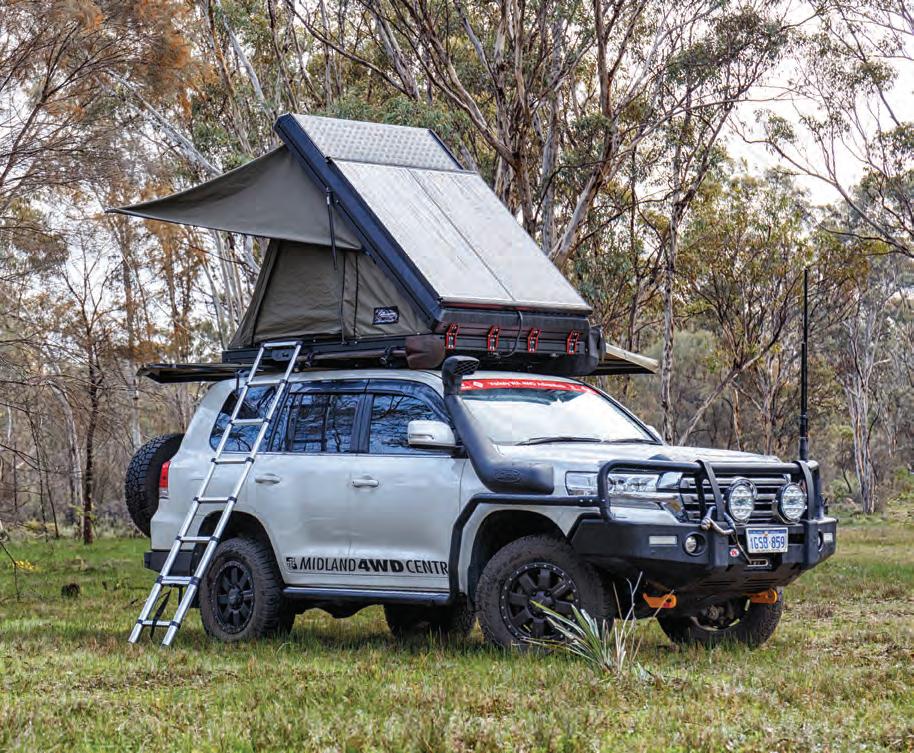
GENUINEHOSPITALITYOUTBACK YOU DESERVE IT Address: 53 Austin St, Cue 6640 Tel: (08) 9963 162 E: info@queenofthemurchison.com.au Web: www.queenofthemurchison.com.au GENUINEHOSPITALITYOUTBACK YOU DESERVE IT Address: 53 Austin St, Cue 6640 Tel: (08) 9963 162 E: info@queenofthemurchison.com.au Web: www.queenofthemurchison.com.au Q 53 Austin St, Cue 6640 Tel: (08) 9963 162 info@queenofthemurchison.com.au www.queenofthemurchison.com.au Plan a stay at the grand old Queen of the Murchison Guest House & Cafe, and soak in the history of Cue. Admire the preserved buildings, fossick for gold, photograph amazing sunsets.
Bilung Pool campsite view.
100 Western 4W Driver #118




Phone 9274 7844 sales@midland4wdcentre.com.au www.midland4wdcentre.com.au Pop in to see the huge range of gear and great service! DL 23701 MRB 3762 201 GREAT EASTERN HWY, MIDLAND YOUR ONE STOP 4WD SHOP
By Chris Morton Photos by LensNation
As a nation we love to explore and we are extremely fortunate to have such amazing landscapes and opportunities in our own backyard. My 4WD My Story is a series that seeks out everyday 4WDs and their owners to discover what makes their fourby the 'ultimate adventure vehicle' and the places they have been. As well as reading the stories in Western 4W Driver, you can watch the accompanying videos on Australian 4WD Driver's YouTube channel.
Since purchasing his 2004 model 120 series Prado, Todd has implemented some fairly significant upgrades to his fourby to enable his passion for off-road adventures. With a sleek but tough-looking exterior, he was attracted to the wide range of accessories and technical knowledge around the proven 120 series, providing him a very capable platform to build his ultimate tourer while still giving him the ability to hit some of the tougher tracks around home.

www.YouTube.com/Australian4WDriver
102 Western 4W Driver #118
The list of additions and modifications is long with every piece serving a purpose. From first looks we are greeted with a steel ARB Deluxe winch-compatible bar, sporting a 12000lbs winch and a pair of GME AE4705 UHF antennae. Illumination is taken care of with two 11.5" STEDI ST3K lightbars and a STEDI 50.5" TK2 bar fitted to the roof rack.

The underbelly is protected by ARB’s UVP bash plates and cover from the bull bar to the transfer case. A Superior Engineering 4" lift with Dobinson heavy-duty front coils provide a suspension upgrade along with significant upgrades to the lower control
arms, sway bars and adjustable rear shocks. A set of 265/70/R17 Nitto Trail Grappler mud terrains are fitted to the standard Prado steel rims giving the vehicle its grip. Accommodation is never a problem with the Gen 3 Alu Cab roof top tent and Oztent Foxwing awning ensuring that Todd and co always have somewhere out of the weather and a cosy bed within an easy climb.
The interior has received the full works with a custom roof console housing the GME UHF, map pockets, interior lights and twin volt meters. The stereo received some attention with a Pioneer touch screen head unit, upgraded speakers throughout and a
Check out My 4WD, My Story on Australian 4W Driver's YouTube channel. Subscribe today!
Todd’s 120 series Toyota Prado is his pride and joy. He has been tweaking and modifying it since 2013, developing his ultimate escape vehicle.
Western 4W Driver #118 103
4-channel amp to ensure any 'bush doof' is a resounding success.
The rear cargo area has the obligatory drawer system, 60L ARB fridge, 22L water container plumbed through to the rear with a 12 volt pump. An ARB twin air compressor is tucked away along with a 4L air tank to ensure that there is plenty of capacity to pump the Nittos back up. A KAON pet barrier ensures that everything that is in the back stays in the back in the event of a sudden stop. Todd has included a dropdown table with storage and overhead lights, making quick road side stops a breeze, even in the dark.
The original 1KZ-TE 3-litre turbo diesel, which at the time of writing had clocked over 470,000kms, also received some love in the form of a Safari snorkel, turbo boost tee running at 18psi, an aftermarket 3 bar MAP sensor, 3” Scotts Rods exhaust, an SR5 Hilux bonnet scoop covering a topmounted intercooler, catch can, an auxiliary battery (mostly to run the stereo) and a REDARC SBI12 battery isolator.
Todd says, “The modifications allow for a quick and easy camp setup in any condition with the capacity to carry extra food and water for extended trips away. The suspension upgrades make for a more comfortable ride and mean that there are
less places that are off-limits due to the vehicle’s capabilities.”

Todd has plans to upgrade the factory seats to something more comfortable along with some side impact protection. He is also planning for some 'weekend tyres' to provide added ground clearance on tougher tracks and more gauges to give a better overview of what the engine is doing.
His touring adventures have taken Todd to some remote locations around the country with his favourite being the Bilbunya Dunes area. “The Baxter Cliffs and Israelite Bay are an amazing corner of WA.” Closer to home, he loves challenging himself on the tracks around Harvey and Brunswick, with technical rocky sections his real passion. Todd admits that the Prado is getting a little long in the tooth and despite the work to improve it, the reduced ground clearance can be a challenge. The engine is getting tired, resulting in a lack of power in some instances and the lack of modern luxuries found in most new 4WDs leaves him wanting more.

This is Todd’s 4WD and this is his story. Watch the video at: www.YouTube.com/Australian4WDriver
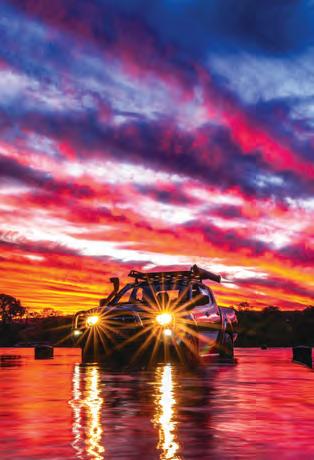

104 Western 4W Driver #118


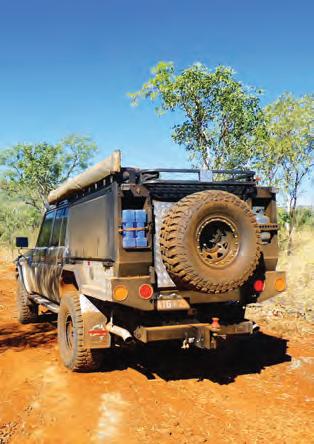





Are you a Western 4W Driver subscriber? Want to see your photo published on our next cover? MAGAZINE COVER PHOTO COMPETITION PLEASE READ BEFORE ENTERING: Specifications: Photo must be your own image, taken in a Western Australian location and include a 4WD vehicle. Eligible entrants: Entrants must be a current subscriber to Western 4W Driver magazine. How to enter: Entrants must email a high resolution image to submissions@western4wdriver.com.au using the free website: www.WeTransfer.com along with their name, address, phone number, email address and details of where the photo was taken. Duration of competition: The competition will open 1 June 2021 at 12.00 noon and conclude on 31 July 2021 at 12.00 noon. Number of permitted entries: No more than five (5) entries per person is permitted for the competition. Property of image: The entrant retains copyright of their image but grants Western 4W Driver permission to use the image in Western 4W Driver magazine and for promotion on social media platforms. Selection of winner: Winning photo will be selected by the editors of Western 4W Driver magazine. Prize details: Winner will receive a Hema HX-1 Navigator with sun visor, valued at $738.95 and their photo published on the cover of edition 119 of Western 4W Driver. Prize is not transferable or redeemable for cash. Delivery of prize: Western 4W Driver will arrange for the prize to be delivered to the winner to an address within Australia. Winner notification: The winner will be promptly notified by email following the end of the competition (including by being published and promoted on Western 4W Driver’s website and other social media platforms). WIN A HEMA HX-1 NAVIGATOR Valued at $738.95 Western 4W Driver #118 105
Lenny
the landcruiser
By Ashley Pearce
I think I am the sort of guy the marketing executives at Toyota Australia are on the lookout for. Impressionable, easily led, likes bright shiny things. The rumours of a new series LandCruiser have been out for some time now. So much uncertainty and rumour surround it. Will it have a V8 diesel engine? Will it be a Hybrid? Will it be a V6? I think only the engineers and senior managers know! Given the activity online in LandCruiser groups on social media, demand for a 200 series of any age has gone through the roof, and I for one have been one of those who brought forward a decision to re-join the Toyota family. Why? Because I want one!

106 Western 4W Driver #118
Let me take you back. I am sure a number of readers have been in my position. I first drove a Toyota LandCruiser 60 series back in January 1982. I was not long 13, we were on a family holiday at Guilderton and our nextdoor camping neighbour hired a 4WD every Christmas holidays. Looking back, probably a smart idea as he didn’t have the need for a big car throughout the year. Anyway, old mate Bill said, “Would you like a drive young fella?” Too bloody right I did. Once we had aired down on the sand north of the groyne, away I went. I drove up the beach to our favourite fishing spot with the biggest grin on my face. Whilst all the others went out fishing, I sat in the driver's seat, looking at everything that turned on and off. Forgoing a morning of fishing to sit and go over this magnificent white beast, I was hooked. That moment has stuck with me for nearly the past four decades!
Fast forward to my teens and twenties. My first foray into a Toyota 4WD was a Toyota Forerunner and then a Prado. Is a Prado a real LandCruiser? We loved that Prado, probably a little too much, and were never quite in a position to step up to a 'king of the road'.
So why now? Because I want one. Returning after our mid-year trip to Steep Point, Dirk Hartog Island and then inland to the Gascoyne, I was not unhappy with the performance of my previous vehicle, I just
wanted more. My wife and I spoke about an upgrade and the question was asked, "Why do you want a LandCruiser?"

"Because I want one."
You can guess how that went down with my wife. I was going to have to resort to facts and figures.
After a week or so of discussion I wandered into my local dealer to discuss what was on offer. It clearly looked like a plague of locusts had lunched on the stock and I was not spoilt for choice. As a GX was my only option I was going to have to up the specifications. The dealer loaned us a GX to test drive with my wife asking, “Does it have this?” No, that’s in the GXL and higher spec models. “Does it have that?” No that’s in the GXL and higher spec models.
End result: we got a GXL. Thankyou COVID, my ploy worked.
Clearly the current model LandCruiser, even with a facelift, is still a 13 year old vehicle. Nearly all of the safety features I had in my most recent vehicles are non-existent.
Did I care? No, because I wanted one!
After waiting what seemed a lifetime Lenny the LandCruiser finally arrived. My wife and I had already decided that if we were going to buy a vehicle like this and get back on board the Toyota train, we were going to do it properly and set it up for our purposes. Let the shopping commence.
Western 4W Driver #118 107
One thing we weren’t expecting was everyone having a different opinion on what you do and don’t need. What we have chosen is to suit us and our style of touring, and because I wanted it.
I engaged the services of the team at Off Road Equipment in Perth to assist me with the fit out. They have been fitting out vehicles for years, I 'wanted' ARB products and knew they had the expertise to do the job right. This is not a sponsored post and I paid retail for our gear. One question I was asked is, why didn’t I support local business here in Bunbury? That was an easy one to answer. I also run my own business and I prefer to support the businesses that support me.
Not being a hard core 4W driver, the vehicle needed to be set up to suit outback touring and beach driving. A suspension upgrade was the obvious first choice and we opted for an ARB GVM 4015kg upgrade. We tow an Australian made camper trailer, with a heavy tow ball weight and carry a lot of camera gear to document our adventure. ARB Safari Bar, ARB Solus lights, GME UHF
unit, Cel Fi Mobile booster and an ARB Frontier long range fuel tank followed as did a ScanGauge 2 to assist with additional vehicle performance information.

A Manta 4” exhaust upgrade was fitted to help the V8 breathe easier with the added bonus of slightly lower exhaust temperature. Not having had the vehicle for very long it is difficult to judge if we have benefited with lower fuel consumption.
A set of Supafit seat covers completed our initial build, providing some comfortable protection for the seats.
Since November we have managed to clock up over 5500km and given that my wife says that I have a constant grin on my face, it is a fair assumption to say that I am extremely pleased with my choice of vehicle. The Cruiser handled the corrugations and rough terrain east of Esperance with ease and I was even surprised at how well the supplied Dunlop Grandtreks performed. Lenny is still missing some modifications, with plans for a custom drawer system and dual battery setup. I’ll keep you updated in future editions of the magazine.
108 Western 4W Driver #118
SPOTTED IN THE WILD
BIN CHICKEN
Spotted
in Wiluna, our very own Shane the Sharkcaver was found with his head in a rubbish bin after claiming to have accidentally dropped his plastic container in there when he tipped out some food. Given that Shane had been in the field for almost double the time he originally allotted for this trip, we suspect this was a sneaky re-supply instead.

Proving how small the world really is, Shane said, "As i was bin chickening, bloody Nick Underwood comes up to ask if i was looking for a geocache. I sh#t you not."

Western 4W Driver #118 109
FINDING FANNY
Another South Coast Discovery
By Ashley Pearce

In the last edition (117) our changed plans due to the poor weather saw us venturing out east of Esperance up the Balladonia Track to discover the Deralinya and Bilbanya Homesteads. This whet our whistle for further discoveries in the area.

After a few days back in Esperance enjoying the likes of the Lucky Bay Brewery and fishing down at Dunn’s Beach we were looking for further adventures. As we were due to head back towards home within a couple of days and return in the future, we thought we would also check out a number of the free or low cost camps along the south coast between Esperance and Ravensthorpe.
The first campsite to check out was Quagi Beach. We ventured 60 kilometres west of Esperance and took a left turn down Farrells Road heading south approximately 11 kilometres to the coast. We weren’t surprised to find the Quagi Beach camp site completely full given the time of the year. Quagi Beach campsite is managed by the Shire of Esperance and DBCA. The campsite includes 18 camp bays of varying sizes and a near new composting drop toilet. There is also a day use area with ample parking for visitors, sheltered picnic area and a viewing platform. This beach is quite sheltered. The area surrounding Quagi Beach Reserve is surrounded by DBCA managed area along with the Stokes National Park. The area is dominated
110 Western 4W Driver #118
by rocky headlands and offers a range of activities such as swimming, fishing, snorkelling and kayaking and of course nature based camping. At $15 per night, per campsite this is bargain camping at its best. We have pinned this as a location to return to in the future.
If you don’t have a 4WD then Quagi is an ideal location to camp.
Just as we made our way down to the water the heavens opened again and we went back to the cars to find our next hidden gem.
Back-tracking up Farrell Road some four kilometres, you take the track to the left to enter the Stokes National Park. Being rockier and more washed out, this track was easily negotiated using high clearance than needing to engage 4WD. Initially it follows farming land to the north until the track veers in a south westerly direction. Approximately three quarters of the way along we saw the sign to Moir Homestead Ruins. This area is managed by DBCA with a small car park that can handle larger vehicles, but you would struggle to turn around if you were towing your off road van or camper in. Leaving the car park, we entered the gates to see numerous
buildings now only consisting of roofless limestone walls. The site includes the homestead (1873), blacksmith shop and shepherds camp and woolshed/stables built in 1880. These limestone ruins provide a visual focus to the cultural landscape of the historic pastoral property on which they are located along with providing an insight into the development of pastoralism in the south-west region of Western Australia. Its location at Fanny Cove near Esperance was a main entry point for gold prospectors travelling to the goldfields. These ruins provide a tangible reminder of a simple structure built c1880s based on Victorian Georgian model adapted to local conditions and built of local materials.
Some history, back in 1873 Alexander and John Moir were granted a lease of 14,000 acres around Stokes Inlet. This was extended to 57,000 acres by 1888. The Moir’s established their homestead near the eastern shore of the Stokes Inlet to graze sheep through the coastal vegetation. Their production of wool was then shipped from nearby Fanny Cove along with sandalwood that was still in plentiful supply. They also turned their hand to growing barley and other grain crops as feed for stock.
 Moir Homestead ruins.
Western
Moir Homestead ruins.
Western
4W Driver #118 111
A walk around the site sees numerous old buildings, a massive Moreton Bay fig and one of the biggest mulberry trees we had ever seen. Safe to say after our mulberry adventure at Rays Rocks we stocked up again and managed to get our hands stained red … again! One thing to be careful of is the wild bees in the area and many signs warn patrons of the bee risk. If you are allergic to bees, this is probably not an area to visit without appropriate medication if you get stung. It would be a slow trek back to the main road and back to Esperance.
Walking further around we came across the grave site of John Moir. Details of John Moir’s death can be extracted from The Inquirer and Commercial News 9th May 1877:
MURDER OF MR. JOHN MOIR.
We have received reliable particulars of the death of Mr. John Moir, a settler near Esperance Bay, who it will be remembered


was murdered by natives on his station the early part of last month. It appears that Mr. Moir had arrested and chained up two natives for some misconduct, which however our correspondent does not describe. Unsuspicious of any foul play Mr. Moir permitted the natives' women to remain at large with them. Nothing eventuated during the day, but in the evening, while Mr. Moir lay reading on a sofa in his house, the natives whom he had chained up rushed upon him, each armed with a blade of a pair of sheep shears and stabbed him in several vital parts of the body.
It has transpired that the natives' women, who being thoroughly civilised and friendly, had free access to Mr. Moir's house, stealthily removed the key to the padlock which bound their husbands, and released them to carry out their murderous purpose.
Grave of John Moir.
112 Western 4W Driver #118
The names of the natives are Tampin and Joe Fennatty.
As history has now revealed there is more than likely two sides to the story and sadly, will be one story we are very likely to never know.




Reflecting on this we walked further around the conveyer belt matting to the other areas of the ruins. All in all, an interesting insight into how these early pastoralists lived. National Park entry fees apply to each vehicle entering the Stokes National Park. Leaving the Moir Homestead ruins we ventured further south west to check out the Fanny Cove camp site. Not expecting much after the Quagi Beach site, we were very surprised to see how large and spacious these sites are. Nestled in coastal heath and just metres from the beach this site consists of four bays suitable for camper
trailers or tents. The camp site has a drop toilet, picnic tables and not potable water. The best thing … this site remains totally free with the exception of the National Park entry fee.



Lunch on the beach whilst we threw a line in was in order before heading off to check out the other camp site in the area at Shoal Cape. This is a camp site I wouldn’t recommend towing a trailer into but if you were tenting or swagging it would be perfect. Down from the camp site is a lovely bay that on the right day without southerly breezes would be perfect for a swim or snorkelling.
Back to Fanny … did we find her? Found her cove but after extensive research we can still not find out why this pristine and beautiful area was named 'Fanny Cove'.
Suffering from a bit of turbo lag? Sounds like you need a PedalBox 10% improved acceleration and confident overtaking Made in Germany for maximum performance Save 15% using code W4WD at checkout www.performancetune.com.au ☎ 1800 722 324 $340 (Bluetooth model $399)
Western 4W Driver #118 113
TALK TO THE EXPERTS
By Chris Morton
Nestled
just off North Lake Road on McCoy Street in Myaree sits WA’s oldest 4WD accessories store.
Since 1972 Off Road Equipment, or ORE as most people know them, have been quietly fitting out multiple generations of 4WD adventurers, equipping them with the gear and the knowledge to travel further and experience more of our great state and beyond.
As one of the state’s largest ARB stockists, they were recently crowned 'Stockist of the Year' for 2019/2020, a feat the team of 4WD enthusiasts are fiercely proud of.
Well stocked, the characterful store provides a unique experience for those looking to improve their 4WD’s capabilities as well as a plethora of information on where to take it. Four hoists and an experienced workshop team of six ensures that they are fully equipped to complete your job in a timely manner. Managing Director, Andrew Fardon, has been with the business since 1989 and is an avid user of the gear that they sell. With years of remote area travel under his tyres he is also able to offer that advice to his customers, knowledge which is rapidly becoming lost as less venture out into the red heart.
“Since starting with ORE back in ’89 I have witnessed the entire evolution of the 4WD, from humble beginnings with the Land
Rovers and 40 Series LandCruisers to the current luxury models we have today.” Andrew says, “It’s important to ensure that you are getting the right advice from those that use the equipment that they sell.”
Along with the 4WD focus, Off Road Equipment are also the state dealer for Australian-built CUB Campers. 50 years of manufacturing shows that these tough-as-nails campers are built for Australian conditions by a wellregarded Australian business.

“There is so much choice now in the camper trailer market, it can make it quite difficult to choose what is right for you. It can be a considerable investment so make sure you have a good understanding of what you want to be able to do with your camper and then go and look at them.” Andrew explains, “Yes, you will pay more for an Australian-built camper, however it pays you back in spades with its reliability and longevity, long after cheaper options have fallen apart. There is also the added bonus of a better re-sale value when it comes to upgrade.”
Having dragged these campers all over the countryside Andrew and his team should know.
The team at ORE love a good yarn and are more than willing to share their experiences. Support a family owned business, drop in and tell them Western 4W Driver sent you.
 Andrew Fardon.
Andrew Fardon.
114 Western 4W Driver #118
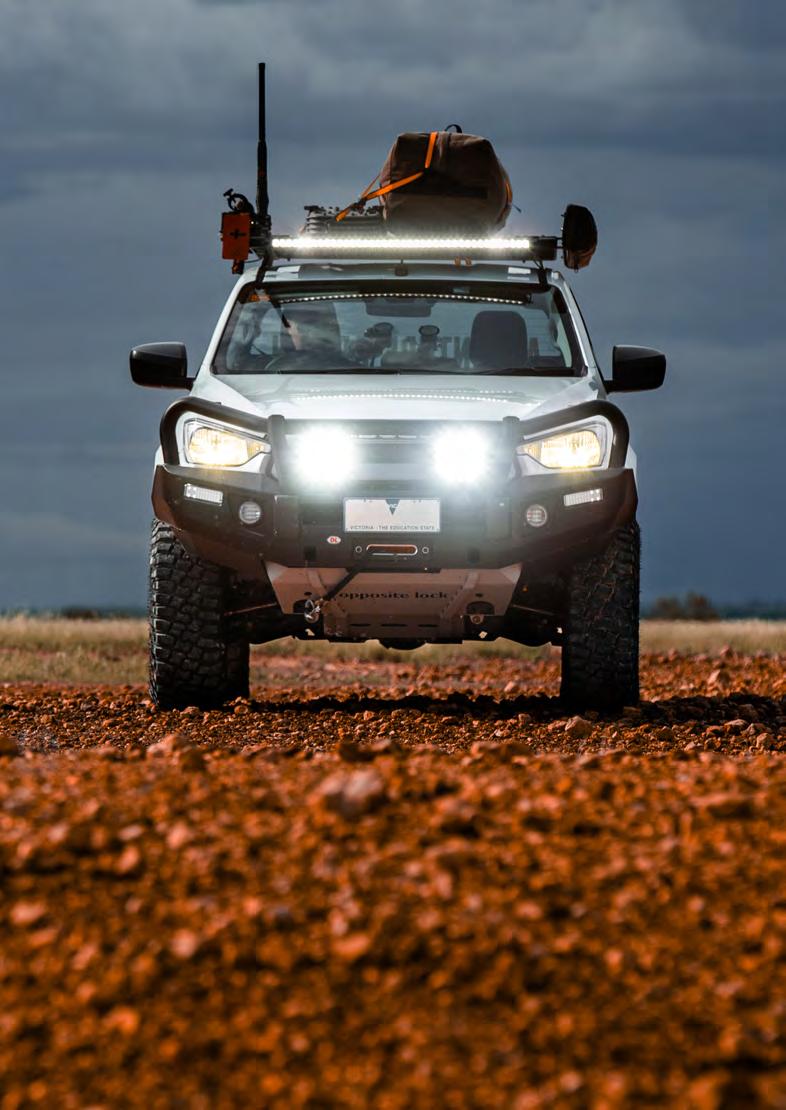
SAY HELLO TO A NEW GENERATION OF TOUGH The new premium steel bull bar for the ISUZU D-MAX FY21 has been designed to handle Australia’s toughest terrain, whilst keeping safety and the vehicle’s inbuilt intelligent systems at the forefront. @oppositelock4x4Oppositelock.com.au @oppositelock4wd1800 624 444
red dirt and horses
After a short COVID-inspired hiatus, racing returns to the Marble Bar Race Club with the running of the 127-year-old race carnival in the historic town. This iconic event has been held annually in July since 1893, traditionally drawing racegoers from around the country. With a slight elevation directly adjacent to the finish line, patrons in both the members and public areas get to enjoy breathtaking scenery of the surrounding countryside. With a Race Ball being held on Friday
By Chris Morton
night, 2nd July, the race weekend is more like a festival with outback hospitality overflowing.
This is a great, family friendly event that showcases some of the best the Pilbara has to offer and makes for a great break in your next Pilbara adventure. If you are planning to stop for a spell to enjoy the racing atmosphere then please ensure that you have booked as the town does get quite full.

INFORMATION BAY
The Marble Bar Cup returns this year on Saturday 3rd July 2021. Gates open at 12.00 noon with punters enjoying the first race by 1.30pm with a total of six horse races finishing at 4.30pm.
The last race of the day is the iconic mixed breed Iron Jack undie run which is a 100m sprint for those in their undies which draws a field of over 40 participants each year. There are many spills and grazes but always very keen participants. Previous years has seen crowds in excess of 1600 strong and we anticipate similar success in 2021. The most popular accommodation is at the track in a big open space graded specifically each year for visitors. Travelling food vans come to town and set up at the track to ensure punters are well fed. Tickets will be released in May and available online. Links to ticket sales will be advertised on the club's Facebook page: www.facebook.com/MarbleBarRaceClub
116 Western 4W Driver #118
improved departure angle
By Chris Morton
Readers of this magazine would be (I hope) well aware of our Ford Ranger camera truck build which we kicked off in early 2020.
With the replacement of the style side tub with a custom drop-side tray and removeable canopy, an issue was discovered in the rear. Now no one likes talking about problems back there but this one needed to be addressed, and quickly. The factory-fitted tow bar now sat lower than a lizard’s belly and was a serious obstacle when you think about departure angles.
Much Googling and talking to 'experts' followed with a decision to contact Milford to investigate their new towbar offering, the Ult1Mate Next Gen. After some discussions and inventory checks, a bar was found and sent over for us to fit to the Wildtrak.

For anyone who knows me, they will attest to the fact that my mechanical knowledge is somewhere between that of a rock and a gum tree and so I was looking forward to the challenge of fitting the bar by myself. OK so the step-by-step fitting video made a huge difference and made me briefly believe that I was an expert, but that is the idea.
After removing the factory bar, I channelled my inner Lego Master with the patented three-piece design bolting easily to the nether regions of the Ranger. Milford’s silent HitchHush ensures that there is no rattle or movement coming from the hitch, with it pulling double duty as the receiver cover when nothing is fitted, preventing it from filling up with gravel.
Having had the bar fitted for almost 12 months now and towing a variety of vehicles with it, I can honestly say that I really like it. I had some initial misgivings around the HitchHush, mostly because I had never had a towbar with anything like it before, however the bar has definitely grown on me.
Australian owned and operated with their headquarters based in South Australia, Milford have been designing and producing cargo barriers, tow bars and other innovative products for the automotive industry for the last 50 years and are known worldwide for their quality and performance. For more information visit: www.milford.one or give them a call on 1800 645 367.
Photo: Steane Klose
Western 4W Driver #118 117
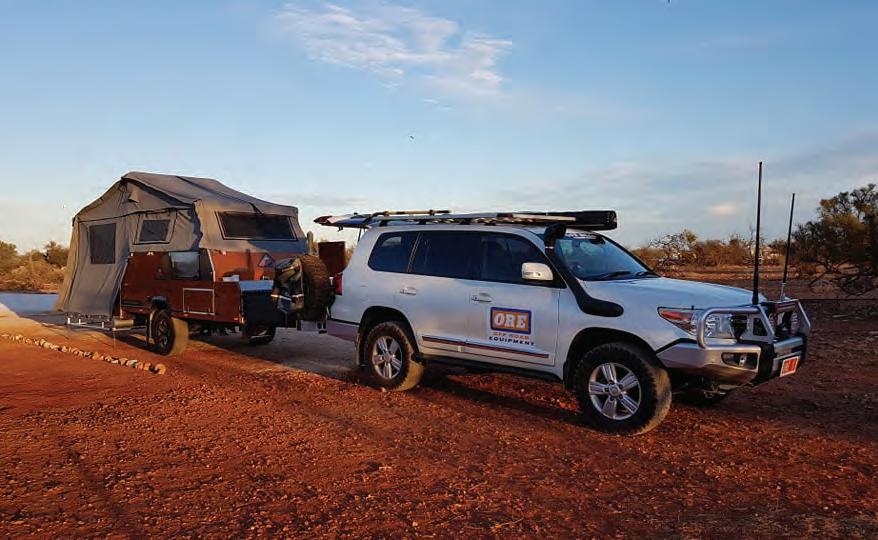














61 McCoy St MYAREE WA 6154 Ph: (08) 9317 2344 Fax: (08) 9317 2448 www:offroadequipment.com.au DL 19018 MRB 3101 OFF ROAD EQUIPMENT ORE The Great Outdoors! WITH EVERYTHING YOUR 4WD NEEDS! range includes camper trailers, rooftop tents and a comprehensive selection of 4WD accessories (including lights, tanks, racks, fridges and suspension kits). W.A. AGENT FOR CUB CAMPERS, DESIGNED AND BUILT IN AUSTRALIA. STOCKIST DL 19018 MRB 3101 ROAD EQUIPMENT Expl- ORE Outdoors! YOUR 4WD NEEDS! W.A. AGENT FOR CUB CAMPERS, DESIGNED AND BUILT IN AUSTRALIA. STOCKIST DL 19018 MRB 3101
Trapdoors
One of my Wildtrax travelling companions, Toni from Toodyay, showed me recently this photo she'd taken last year of a spider's ornate trapdoor and I was taken with its design, for all the world like a kindergarten drawing of the rays of a blazing sun. Most of the trapdoors I've come across in the desert are masters of camouflage, but this one, out near John Forrest's 'Gun Bucket Hole' (116th edition), seemed to make itself deliberately obvious. Toni told me she'd heard quite a story about the spider species that constructed it; a story from our guru of all things in nature, Kevin Coate, so I decided to Kevin it for myself. But Kevin was coy about providing information personally, and suggested I look up on the net specific research by arachnologist Barbara York Main who studied WA trapdoor spiders for nearly 50 years before she retired in 2017 at 88 years of age. During her lifetime she wrote several books on Australian spiders and their habitat and discovered numerous new species and genera many of which were named in her honour. The story to which I was directed indeed proved fascinating. Professor York Main (1929-2019), conducted some of her extensive wheatbelt research in the North Bungulla Nature Reserve situated about 15km NE of Tammin. Here, in 1974, she found that a yearling female trapdoor spider (species Gaius villosus, a chunky black or dark-brown, eight-legged insect eater) had left her mother's burrow to construct her own nearby, a silk-lined nest that she would occupy for life. A small sign was erected alongside by York Main identifying this as the trapdoor of spider number 16. This specimen was one of a number of long-term scientific studies undertaken by Perth's 'Lady of the Spiders',

as David Attenborough dubbed her in one of his documentaries. This burrow was visited and checked twice yearly. The sunburst array of leaf litter woven into the distinctive trapdoor construction of this species is all individually connected to silk filaments that extend beneath the trapdoor. The slightest movement of any of those radiating leaves would see No. 16 emerge to capture whatever tasty bug had walked over her trap. The only other times she would leave her retreat would be to deposit pheromones around her nest every couple of years to attract the wandering males of her genus.
As Professor Main scaled down her fieldwork prior to retirement, a young scientist, Leanda Mason took on the study.

In 2016, when she visited North Bungulla, she found No. 16's trapdoor pierced and

WILD TRAX
with IAN ELLIOT
Trapdoor.
Photo: Toni Chrimes
Western 4W Driver #118 119
torn open and the burrow empty. It was obvious that the spider had been attacked and paralysed by a wasp that had dragged her immobilised, but still living, body off to be a repository for wasp eggs and food for wasp larvae, just one of Mother Nature's more macabre rituals. However, there was no denying the scientific evidence: No. 16 had lived for 43 years. This made her the longest lived spider known in the entire world. Something to think about when you spot one of these amazing trapdoors out in the bush.
Pikalu and Calcalli
Since the brief recommendation of a particular four or five day round trip out of Laverton in my column last issue, it has been suggested that I should perhaps detail some of the sights to visit along the way. Some 22km before you reach Empress Spring on the David Carnegie Road, there's a turn-off on your RHS about 38km up from the Great Central Road. I've kept pretty quiet about these sites up to now although I have taken a few tagalongs in from time to time. However, I noticed photos and rough directions on the Tchukayirla Roadhouse notice board a few years ago and the track in was graded and signposted last time I went past, so it looks like the place is beginning to get better known.
It's now 33 years since I first visited the rockholes up this track in company with our Bindon the Bushie, geologist mate Mike Donaldson, old Bob Collard from Leonora and others. Bob and Mike had been shown these sites and told their names in the 1970s by Mickey Warren, an Aboriginal elder from that region. Bindon, who shared the cab of my Hilux, was along on this 1988 trip as a result of Bob requesting advice from the WA Museum on the possibility of an archaeological dig at Empress Spring. Our visit to Pikalu, Calcalli and other rockholes off the then Warburton road was

 Stone arrangements and dancing path at Calcalli.
Photos: Paul Kennedy
Stone arrangements and dancing path at Calcalli.
Photos: Paul Kennedy
120 Western 4W Driver #118
to satisfy my quest to document named, but unmapped, features for Geographic Names Section at the Lands Dept.

Following the side track up to the top of the rise, at about 1.2km you may be able to pick out the faint traces of an old airstrip on your RHS. About 250 metres further on the track curves northward to descend a rocky incline to the site of an old oil drilling camp. (This may have been the Eagle Oil Company as the David Carnegie Road was formerly locally known as the 'Eagle Highway.') If you keep straight on more to the NE from this northward curve within about 100 metres you'll find a group of gnammas overlooking the old campsite. These are the Pikalu Rockholes.
After having a bit of a look around, you'll find a faint track continuing eastward from Pikalu across a bare stony patch that may have been the site of an Aboriginal stone arrangement many years ago. It's now so kicked around by camels that it's difficult to say with any certainty. This track climbs generally NE over the hill about 1km before terminating at a convenient small parking space amongst stunted Miniritchie from which you can walk to the Calcalli caves, rockhole, stone arrangements and dancing path. These are all generally due N of the parking space at distances of 300 metres, 800 metres and up to 1km respectively.
You'll walk further than this because you'll need to follow a circuitous route around the end of the breakaway and across a stony gully to reach the impressive arched caverns. There is further rocky terrain to negotiate to reach Calcalli Rockhole, a tiny, but evocative reservoir in the wilderness. When you find the valley of standing stones spread out below this rockhole, and the ornate dancing path winding its way through the NW entrance to this natural amphitheatre, I'm sure you'll be struck, like myself, with the wonder of what primitive rituals and ceremonies may have taken place here in the ancient past. While there are no burials here (the ground is too hard), I'm certain that each of these stone arrangements was constructed to celebrate the memory of a stone age ancestor, so please be careful to conserve this precious ground. These days, I imagine you'll need to organise permits for a visit.
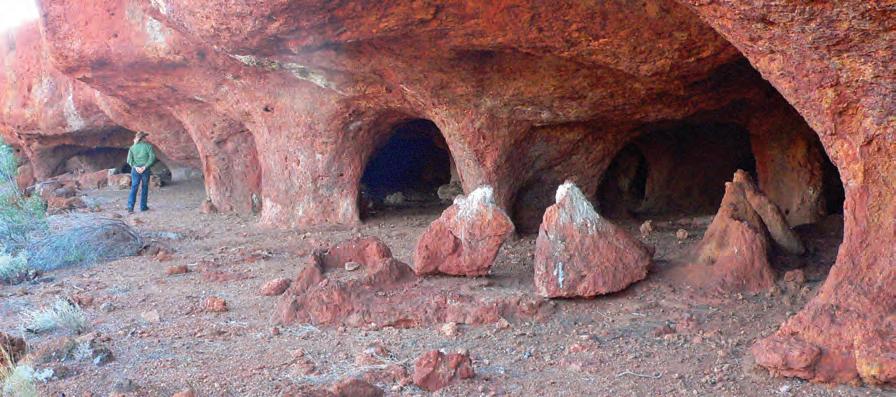 Calcalli caves.
Calcalli caves.
Western 4W Driver #118 121
What’s in a name?
POSITION
Averyimportant consideration in the recording of feature names for mapping purposes is the position of the feature. This includes, in connection with ranges, plains and watercourses, their extent or their source. That these determinations often remain vague or incorrect on current maps is an issue that is too often ignored by cartographers. A big part of the problem during my time dealing with toponyms in the Geographic Names Section of the Mapping Branch at the then Department of Lands was that staff at National Mapping in Canberra ignored much of the information supplied to them by the WA State authority.
I particularly recall the case of two remote gnammas (can’t recall their names now), situated up on top of a desert breakaway while the Natmap topo sheet ignored our listed position and showed them in a dry sandy creek bed below. When I asked why this was so, I was told that the decision had been made because it was thought by the young stereo-plotter officers more likely that two dark patches in the creek bed visible on air photos would be the named waters. I informed them that, during a personal visit, I had confirmed that the two dark patches were nothing more than small stands of gums growing in sand, that it was entirely illogical to expect 'rockholes' to be anywhere other than in rock, as up on the breakaway, and that our Lands Department position was supported by survey. I don’t know, but it wouldn’t surprise me if my protest is still being ignored.
Another disturbing example is Pinpi Rockhole, a rock-bound pool that is in the bed of a creek that was once within “Rudall River National Park” (renamed Karlamilyi National Park in 2008). The Aboriginal names of many features within this park
were originally recorded by Alfred Oliver Cromwell Ives, a Rabbit Proof Fence boundary rider based at Jigalong, who prospected the region in the company of local Aborigines during the 1930s. His work was brought to my notice by his youngest son when the park was first declared in 1983. I was loaned diaries that the two older sons, Noel and Robert Ives, had found in the roof cavity of their home after the death of their father. Determined to follow their father’s explorations, these two had organised an expedition out to the Rudall region in 1970, when they had placed copper plaques to commemorate their trip and their father’s early association with the area.
Armed with these diaries and the brothers’ photos, I was able to plot the positions of many of these features and had the names approved for use on maps. Pinpi (recorded as “Pinbi” by Ives) was one of the easiest to place. Situated on an unnamed southern tributary of Yandagooge Creek it was near a spot where a 3km long, WNW trending isolated dune met the creek. This was visible on air photos exactly as described and that position was submitted to National Mapping immediately the name was approved. You can imagine my surprise when the next edition of the !:250,000 topo map was published showing Pinpi symbolised as an unnamed waterhole and applying the name to another waterhole symbol some 2km downstream with no dune anywhere near. I’ve never been able to establish any reason for this.
During a visit to the park with naturalist John Tucker in 2006, we took the opportunity to check this out. We crossed the creek about 6km downstream from “sand dune Pinpi,” where there was an old prospecting track giving access, and followed up on the LH
with IAN ELLIOT 122 Western 4W Driver #118
bank to the spot shown as Pinpi Rockhole on the map. There were a few rocks in the creek bed there but no place where water would pool for any length of time. Continuing up to the vicinity of the dune, we found a magnificent pool with a rock cliff on the left bank shaded by a dense stand of gums. Here too, just to clinch the matter, we found the Ives brothers’ copper plaque. Landgate’s Geonoma database lists the correct position, but will the map ever be corrected? Who knows.
During my first ever visit to the Rudall River in 1985, CRA (now Rio Tinto) were carrying out mineral exploration in the park. This was the same year that they discovered the Kintyre uranium deposit. Within nine years, despite all kinds of opposition, they had permission to mine and this whole area, including Pinpi, was excised from the national park. The minesite was acquired by Cameco in 2008, they signed an agreement with traditional owners, the Martu, in 2012 and succeeded in obtaining environmental approval in 2015. Despite only being able to export yellowcake from the Port of Adelaide, Cameco are now advancing the project “at a pace aligned to market conditions,” whatever that means.

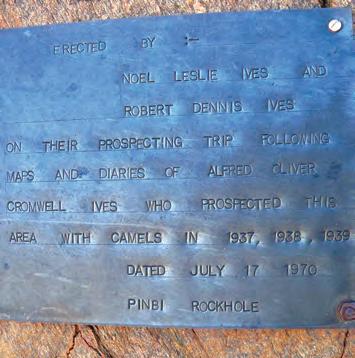
 Reflections at Pinpi Rockhole.
The Ives brothers' plaque at Pinpi Rockhole.
Reflections at Pinpi Rockhole.
The Ives brothers' plaque at Pinpi Rockhole.
Western 4W Driver #118 123
It Started with an Ink Bottle
By Chris MortonFAREWELL TO IAN ELLIOT
As it was once said by Geoffrey Chaucer, “Time and tide wait for no man”, so we all must succumb to the inevitable.
Ian Elliott, who has been contributing to Western 4W Driver magazine for the last 25 years, has made the decision that his body has endured enough boneshaking desert adventures and it is time to park up the 'troopy', put away the keyboard and turn the page on this chapter of his career.

For those of you who have been reading Western 4W Driver for a while, you would be aware of Ian’s prolific contributions to not only the magazine but to The Explorer Series guidebooks. First appearing in the 15th edition of The Western Australian 4W Driver’s Guide, Ian has gone on to have published a staggering 194 articles and columns, co-authored eight Explorer Series titles and their subsequent revisions. During this same period he has also taken the reins as a guest editor on at least three occasions.
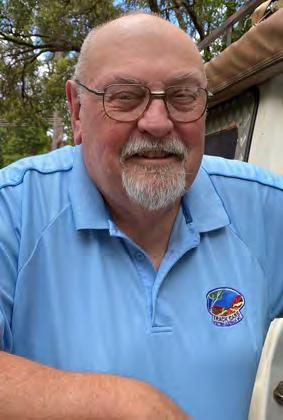
124 Western 4W Driver #118
about his hometown of Glen Forest. His interest in local history, first sparked





the discovery of an ink bottle buried at the base of his family home’s steps, led him to a 35year career with the Lands Department, in the Historical Names section. His very first Wildtrax column set the tone for his historical research when he introduced us to Empress Springs, “a remarkable desert sinkhole”, long known about by local Aborigines before being 'discovered' by dubious means by David Carnegie in 1896. It is Ian’s passion for retracing the footsteps
The 1994 cover of the 15th edition, where Ian's first Wildtrax column appeared.

of long forgotten explorers and prospectors from their own diaries which has led to hundreds of corrections being made to WA maps.
This may be an end to the regular inclusion of Wildtrax within the pages of Western 4W Driver however it is not the last you will hear from Ian. He will continue to contribute whenever he has something interesting to share.
On behalf of all the Western 4W Driver readers, Nick, Karen and myself we would like to thank Ian for his contributions over the last 25 years and the knowledge he has so willingly shared for the betterment of Western Australian adventure seekers.

• Heat and cook meals on the move • Fitted with 2 hour timer to protect from battery failure • 12 Volt and 24 Volt • Insulated stainless steel • Manufactured and designed in Australia Ideal for: 4X4 activities, camping, caravans, transport www.travelbuddy.net.au You only have to speak to Ian to discover his passion for local history, being able to recall names, dates and events from memory
with
Western 4W Driver #118 125
The Grave of Charles W. Stansmore
Victorian born Charles Stansmore was a member of David Carnegie’s 1896 expedition from Coolgardie to Halls Creek. Members of the party included Carnegie, Stansmore, Joe Breaden, Godfrey Massie and guide Warri.

After enduring five months struggling across some of the most difficult and waterless country in Australia, the party arrived at a beautiful pool on the Margaret River on 28 November 1896. It was an oasis, with a seemingly unlimited supply of excellent water with plentiful fish and wildfowl, making a welcome addition to their diet.
On November 30, the main party travelled along the foot of Ramsay Range, while Stansmore climbed up the range looking for game. It was agreed that they would meet up at the end of the range.
Upon hearing a shot, the men thought that Stansmore had been successful. After waiting at the meeting point for 1½ hours there was still no sign of Stansmore. Warri went to investigate. Badly shaken, he returned saying Stansmore was dead. Carnegie rushed to the scene and found that Stansmore had been shot through the heart. His rifle appeared to have accidentally discharged when he slipped, and the butt of the rifle struck the rocks.
Carnegie and his men were devastated. Stansmore had been a wonderful
companion during the long and arduous journey and now, when the party was almost within sight of Halls Creek, he lay dead on the rocks at Ramsay Range.
Burying Stansmore, Carnegie wrote ‘We buried him between the rocks and the river at the foot of a large gum tree. No fine tombstone marked his grave, only a rough cross, and above him I carved his initials on the tree C.W.S. 30/11/96'. At a later date, Stansmore’s family sent a bronze plaque to Warden Cummings at Halls Creek, asking for it to be fixed above the grave.
In 1985, Dr Bill Peasley, an expert on David Carnegie’s travels found a map drawn by Carnegie among records held by Carnegie’s family in Scotland. It showed the grave site - this was a Eureka moment for Bill. Peasley returned to Margaret River with Jim Tough from Halls Creek, and they went in search of the grave. Using Carnegie’s map, they pinpointed a large gum tree but there weren’t any markings on it, only a bulge on one side. While passing a metal detector over it a distinct ping was heard. Cutting into the tree about three inches they discovered Stansmore’s bronze plaque.
The plaque was slightly convex, eighteen to twenty inches square and almost half an inch thick, it read:
IN LOVING MEMORY OF CHARLES WILLIAM STANSMORE OF CAMPERDOWN VICTORIA DIED NOVEMBER 30TH 1896 AGED 35 YEARS
Tree over Charles Stansmore's grave after removal of plaque, 1985.
Photo courtesy W J Peasley
126 Western 4W Driver #118
THE THINGS YOU SEE!
with (TRUTHFUL) PHIL BIANCHI
embedded in the slab. Then for further protection a white metal rail fence that had been precut, was installed around the grave.
 Charles Stansmore. Photo courtesy David Carnegie
Charles Stansmore. Photo courtesy David Carnegie


I’ve been a good friend of the late Dr Bill for years and even 30 years after this find he quivered when he described his feelings at the time of the discovery. Never, in his wildest dreams, did he believe the plaque or grave would be found.
The plaque was taken to Halls Creek for safe keeping while a decision was made about its future. Eventually a decision was made that a cairn, with the plaque fixed to it, be built over the grave. The cairn and plaque were fixed in place in 1986. When Peasley again visited the site in 1996, he was dismayed to find significant erosion had taken place and there was a real risk the grave, cairn and plaque would be washed away. Once Peasley had established that there were no legal issues with moving the grave, and the family had given permission for the relocation, he returned and moved the grave to a point above high floodwater level at the eastern end of the Ramsay Range.
While digging up the remains Peasley found metal toe and heel caps from Stansmore’s boots. Could these have caused Stansmore to slip and accidently shoot himself?
The remains were buried in a clearing and a concrete slab built over them, with the original bronze plaque
Charles Stansmore had rested in his grave for nearly 100 years before nature decided to intervene. By transferring the remains to high ground, Peasley and his team had prevented them and the bronze plaque from being washed away by floodwaters and being lost forever.
I had been endeavouring to visit Stansmore’s grave for many years, only to be thwarted on each occasion by Margaret River still being in flood after the wet season. I was finally successfully in 2019. Anyone wishing to visit Stanmore’s grave needs to gain prior permission from Margaret River Station. Do the right thing and ask.
Stanmore met his death by accident, however through good fortune his grave was relocated by Dr Peasley before it was lost forever.
Stansmore's grave.
Photo courtesy Alan McCall
Western 4W Driver #118 127
A GUIDING HAND
There are more than 28,000 kinds of orchids throughout the world according to an intermittently reliable online encyclopaedia. I don’t know how many of these can be found in Australia, but it is certainly in the hundreds if not the thousands. A talented West Australian botanical artist illustrated a book with more than 200 paintings of orchids known for that state alone, and there are many hundreds more in other parts of Australia. Another acquaintance recently returned from a 4WD trip to the Yorke Peninsula in South Australia and complained that his trip was completely spoiled because he

was unable to locate a field guide to the wildflowers of the region and particularly its orchid flora. Needless to say he is a keen photographer of wildflowers and does produce some rather dramatic closeup pictures of wildflowers and particularly orchids. He said that it wasn’t the lack of subjects that he was complaining about, but the lack of a good manual to identify what he was seeing – because the flowers were out in masses.
Whether you are just interested in a common name that you can share with friends or want the full story with the scientific name (often called a binomial, because it consists of two parts) a good up-to-date field guide is indispensable. However, you should be warned that with all things natural being described by scientists, you are likely to find that your printed field guide to the flora goes outof-date quickly as scientists discover some factor, invisible to the naked eye, which means that a plant with a particular name suddenly finds itself with a brand-new name when its formerly unknown feature is revealed to the world. I can imagine that the orchids, with so many in the family as it were, often wake up one morning to discover that their name has been changed to suit the new discovery. This is not always the case with the socalled ‘common names’ of things. But there is another problem to contend with when using common names alone. Common names in one area may not be the same as the name used elsewhere - and this can be true for places that are relatively close. Names can be much more localised and even more problematical, a particular common name in one area may apply to a completely different species just a few dozen kilometres away. Yes, it is a problem, but I would still maintain that keeping a reasonably up-to-date field guide in the glovebox is a worthwhile exercise.
128 Western 4W Driver #118
The first kind of field guide to be in common use was an annotated map or perhaps one with illustrations referring to different features shown on it. I can think of some in this century relating to the Canning Stock Route, the Eyre Highway and plenty from interstate and overseas. Using these always enhanced the trip for me as I wanted to know about the landscape and its history. I’m sure many readers felt the same. These soon flowered into full-blown illustrated publications with which you must all be familiar. A parallel kind of guide is the one produced for tourists intent on travel in foreign and unfamiliar countries; one famous series being the product of an industrious Australian couple. And landscape and history are not the only subjects treated in field guides; I have some that depict the medicinal plants of the Western United States prairies, the French Alps and others on almost every conceivable topic you could nominate. It’s not that I am a field guide collector, but when I have had the opportunity to travel, I wanted to know the same things about the places I was visiting as I did about Australia. One advantage that today’s traveller has is the availability of electronic field guides. Not only will half a dozen easily fit on your reading screen, but you can forget the worry of having to buy new paper editions as an old guide is outdated or superseded. This kind of semi-permanent guide may be a problem when you are out in the weeds in a remote region with no internet connection if you don’t download the whole guide to start with, but most readers will be far more
BINDON'S LORE

with BINDON THE BUSHIE
comfortable with such a publication than I am, and will surely overcome any such difficulties. The advantage of an electronic bird guide is that it contains a recording of each type of bird call, and you can often play these back to help with identification. And judicious playing of the calls in the scrub can lure an unsuspecting bird within clear viewing distance. However, this facility should be used with caution and infrequently so as to cause minimum distress to the birds.
Things are not so difficult regarding other species of living things. For example, there are probably half a dozen good field guides to the birds of Australia. But a glance through these will reveal that the common-name syndrome applies here just as it does in the plant world. A particularly spectacular parrot common to the central tablelands of New South Wales is locally called the Boorowa Parrot, because it is particularly fond of nesting in that area.

Western 4W Driver #118 129
Only 40 kilometres away it is known as the Green Leek and still in the general region it is called Barraband’s Parrot or Barraband’s Parakeet. Generally, it is called the Superb Parrot in field guides where its scientific name is currently given as Polytelis swainsonii. See the problem? If you were keeping a list of the birds spotted on a trip and encountered the Superb Parrot, you could add half a dozen bird common names to the list with just one sighting! Now it is a difficult thing to spot birds on the wing and identify them correctly as I can explain from personal experience. In a former life while working at a state museum I went on a field trip with another member of the museum staff who was involved with writing a handbook to the birds of Western Australia. The handbook was going to be very specific about where birds were seen and all through the trip one of the passengers was designated as the recorder of birds. It was their job to record the species of bird seen as we travelled along the chosen route and record the distance from a town or other identifiable landmark at which the bird was seen. On return to the office, the locations of all the sightings were plotted on a large map intended for publication. Over a few years the exact localities where a particular bird species was seen produced a very accurate map of the range of the species. This was all fine for the common easily recognised species, but for things which seemed a little less common it often entailed a lengthy delay while a correct identification could be made. It all proved worth-while, but I planned to be a casual observer myself and didn’t panic if I was confronted by a bird that I didn’t recognise. Casual I may have been, but I was always delighted to spot something that was considered a little uncommon or even rare. Spotting birds in their environments certainly enhanced a lot of trips that I have made into the scrub over the years – and the same goes for
discovering interesting and even rare plants. I can only claim the discovery of one new species of animal and that was of a land-snail that lived in leaf litter around the base of a huge granite tor – but that is a story for another day.
What can be of major assistance to the exploring amateur scientist of today, is that field guides are produced that are far more specific to particular regions than they were previously. It is possible to find them for areas that are favourites for visitors like for example ‘Shoreline Birds of New South Wales’ or ‘Shorebirds and Seabirds of the Pilbara Coast and Islands,’ and there are plenty more titles like these for most parts of Australia. I’ve always found that giving them a cheap pair of binoculars each and a local bird guide will keep the kids busy once you have established camp and are looking forward to sitting down in a comfortable camp chair and enjoying a favourite tipple. When they get tired of birdwatching, it’s probably time to get them on to wood collection for the evening barbeque – if that is allowed. Not only do field guides exist for birds, but they can also be found for plenty of other animals and even reptiles and frogs. I’m not so keen on ‘Crocodiles of the World’ having seen what their array of teeth is capable of and nor am I particularly keen on the snake guides that say something like, “the only way to be certain about whether your specimen is a poisonous variety is to count the row of scales ….” That is fine once the specimen is deceased but for the most part, I have always tried to discourage the presence of reptilian fauna near my camps by careful site selection and clearing of any hiding places. Although I must say that in 20 years of living in a swag on the ground, I only had two snake frights, and in both cases, it was more afraid of me than I was of it. Mostly this was because it shot through before my fears had risen to screaming point!

130 Western 4W Driver #118
Theteam over at Wanderlust love gadgets. That was clear last time we were at an event together as I ended up being chased by a remote-control tank that fired gel munitions. Always thinking about others, the team have found a great new product from SENNHEISER. Perfect for when the “bush telly” isn’t enough or when you just need to zone out with some good music, the SENNHEISER CX 400BT True Wireless ear buds offer superior sound quality. Complete with passive noise cancellation, intuitive customizable controls and a long lasting battery, these
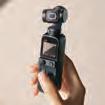
clever little ear buds give you total control over an exceptional sound experience. Normally $299 they are currently available for $149.95 until the end of June or while stocks last.





Speak to the team at Wanderlust or purchase online from www.wanderlustperth.com.au









Power your next adventure


Got Wanderlust? THE ULTIMATE SHOWCASE OF E-FOILS, UNDERWATER DRONES, ROBOTS, CAMERAS, SPEAKERS, E-SKATEBOARDS, HEADPHONES & MORE... 675 HAY ST MALL, NEAR TRINITY ARCADE WANDERLUSTPERTH.COM.AU OR CALL (08) 6245 2302 FLITEBOARD DJI HARMAN
KARDON
SMACIRCLE CHASING MAKEBLOCK ANKER BANG & OLUFSEN SENNHEISER FIIK ANKER NEBULA GOAL ZERO YETI
QUALITY SOUND & COMFORT sennheiser CX 400bt true wireless IN-ear HEADPHONES Western 4W Driver #118 131
LET'S GO GEO-TOURING with SHANE THE SHARKCAVER
IT'S GOT KNOBS ON IT
The tale of one man’s silly quest for a bottle of cognac.
Backaround 2010 when I started getting into this geocache thing, I spied a remote cache that piqued my interest. Lying some 140km north east of Laverton, it is well into spinifex and mulga country of the Great Victoria Desert. The cache had only one visitor since it was placed in 2003, and that task took some six years to occur. A brave Dutchman in a Land Rover Defender drove cross country to be the first to find. In the decade that followed, this cache was always in the back of my mind. Checking in on it occasionally, I found the Dutchman was always the only one to have got there. I held high hopes of being number two. Fast forward to 2018, and by this time I had a lot of solo, remote country miles under my belt. I had also walked a lot of country looking for that elusive piece of 'yella'. I wasn’t anywhere near ready for such a

Turning north at Cosmo to find a base camp.
task back in 2010, but now, I reckoned I could give it a shot, and that opportunity came after a week-long prospecting trip to Leonora. Unfortunately, at the time I left Perth and downloaded the data for the cache, I found a fellow had just ridden a dirt bike out to the cache days earlier. My 10 year goal of second to find had been shattered. Who would have thought, a decade unloved and some guy gets there days before I left to give it a shot. I suppose every cloud has a silver lining and in this case the dirt bike guy left a bottle of cognac for the next finder.
After the prospecting trip concluded, I still had another five days up my sleeve before I needed to return to work. Being in the locale, I had the time to maybe give it a crack. It was now or never. I packed for the 350km drive to find a base camp for an assault on the Knob.

132 Western 4W Driver #118
After checking in and leaving detailed plans with the local constabulary at Laverton, I shot the Great Central Road to then veer north at Cosmo Newbury for another 60km. There I found a beautiful spot to make a base camp, nestled at the foot of some picturesque breakaway country. I planned to walk the 15km as the crow flies, cross country to Nichols Knob. The Knob, so named by Frank Hann on his 1903 expedition into the region, was the place his camel, Nichol, subsequently took ill and died. It would be only fitting to do this journey on foot to experience firsthand a little of what these early explorers had to contend with. With a belly full of tucker, I retired for the evening for an early morning start.
With old mate dingo howling somewhere in the breakaway, I woke pre-dawn to witness a spectacular sunrise. With my day pack all sorted the night before, I headed off to put my plan in place. That plan was to cover a series of waypoints I had selected, 2km apart, using the low resolution that Google Earth offers for the area. I would start off by walking to the half way point, about 8km away. This was to be my decision point, the point of no return (PNR). Should I get here and not feel comfortable, I could bail out for
Base camp at the breakaways.

Here goes nothing!
base camp, a 16km trek for the day. Should I push on from here, I commit myself for the Knob.
The trek to the halfway point was a mix of country which changed every one or two kilometres. You would have some open ground with small granite outcrops, followed by belts of mulga you had to weave your way through to be then followed by spinifex plains. The open country was easy to traverse. The mulga belts were a little challenging to find your way through, but the spinifex plains were the worst. Trudging my way through waist high spinifex, I had to be on the ball. My two biggest fears of being out here solo were snake bite and narky bull camels. Get into trouble out here and all I could do was to wait for a chopper to come save me.
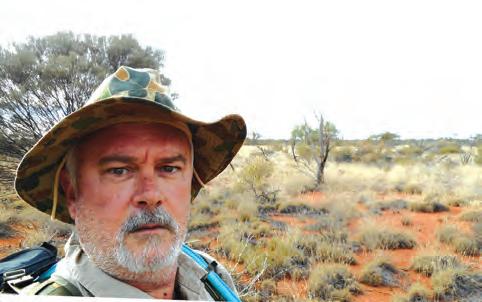
Western 4W Driver #118 133
I’m not walking kilometres through that stuff. Ummm, yes you are.
As it turns out, snake and camel were the least of my worries. In a plain of spinifex, I stumbled across the only animals (apart from a couple of birds and ants) I would see for the whole journey. A couple of roos had spotted me well before I had seen them. As I got too close for their comfort, they bolted, and their presence was made known. One bounded off into the distance, the other stopped about 50m away. We both sat intently observing each other for a minute or two. I looked down to pull my GoPro from my belt, and as I looked back up, old mate roo decided he was going to charge me and was heading in my direction full pelt. This could end very unwell. I made the decision that if I was going to die, I was going to get it on film. I lunged the camera forward towards him as I hit record. The aggressive move towards him, arm outstretched, GoPro in hand, must have frightened him, as he both stopped and did a u-turn on the spot at the same time, to quickly bugger off never to be seen again. I had just had a lucky escape.
Further towards my 'point of no return' I noted that I had veered somewhat off course to the south. The GPS compass was giving me a little grief with the low speed of walking and inducing significant cross track error. I navigated more by the
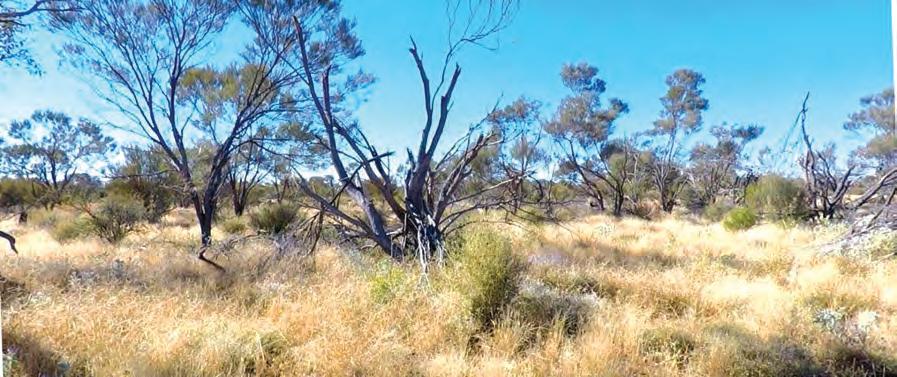
GPS map than the compass to get me back on track. By the end of the third hour, I had made the halfway point, the 'point of no return'. I was in good spirits considering the cranky roo and that damn spinifex. My feet and back a little sore, I felt I had the endurance to continue on. So decision made: I was going for the Knob.
Only a hundred or so meters past this point, I had to cross a large dry creek bed, a rather unusual feature for this area. On the far side of the creek bed I was back into more open, granite country. Markings on the ground showed this area to be a favourite with camels, with evidence of their rutting on the ground ever present. Large outcrops could be seen to the south between vegetation. The forward horizon didn’t look promising though; it appeared the plain in the distance was considerably
The large creek bed.
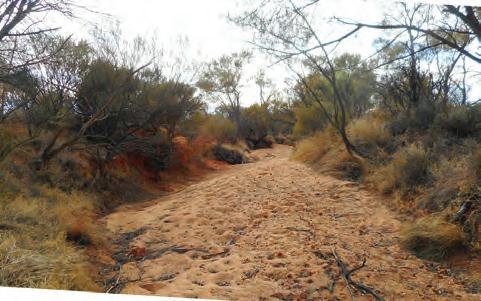
134 Western 4W Driver #118
lower than where I presently stood. As I edged further, I could see I was very high and some climbing down was probably necessary. Fantastic, just what I needed. 11km from the vehicle, in the middle of nowhere on my own, and I am going to have to climb down an escarpment.
The escarpment ended up being some 20-odd metres in height above the plain in front. Here I came across some good fortune. At the edge, I came to a natural staircase to the floor below. If I had missed this point some substantial climbing would have been required. More good country followed below, with small granite outcrops to navigate and generally open country. It was starting to warm up now and I was ever conscious of the small amount of water I had onboard. Some may say that taking 3L of water for this journey is stupidity. They may be right. Some bad luck then struck when I went to take a drink. The mouthpiece of my water bladder broke. Funny thing is I had spares, but I left them in the car as they wouldn’t be needed. To stop the water siphoning from the bladder, I had to conjure up a method to keep the hose elevated to stop the life-giving juices from syphoning away.
A few kilometres on I broke out of the granite/mulga to a long uphill sweeping plain of spinifex. It is a devastating sight.
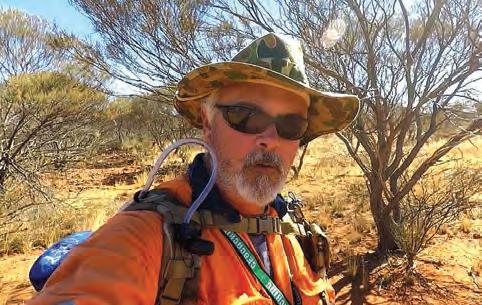

The view from the escarpment.
The jury-rigged mouthpiece.
It is nasty stuff to walk through and there is no protection from the sun, which was now bearing down with all its winter fury. With just 4km to go to the Knob, I pushed on. A kilometre into a plain of spinifex, with nothing but spinifex to be seen in all directions is a demoralising sight to behold. I crested the hill some 2km distant to see more sweeping spinifex plain as far as the eye could see on the downward side. Here I spotted an isolated red bluff and the GPS compass was telling me that the cache was that way too. This bluff was passed by, drawn, and described by Carnegie in his journals from 1896. I felt like I was now in esteemed company. The closer I got to the bluff, the more the GPS was indicating that the Knob was further north. I altered my course for the cache, no doubt adding yet more distance to my walk.
Western 4W Driver #118 135
Soon enough I was 500m from the cache, then 250m then 50m. A small knob of rock presented itself through the mulga. I had made it to Nichols Knob. Seven hours and 19km of inhospitable country and I had arrived. By now, my feet hurt terribly. Every step I took hurt as the pads on my feet were becoming blistered. My legs ached, my back was sore, my mouth dry. The flies didn’t help an ever-diminishing mental attitude either. I had a quick scout around and I could not find the cache. You have got to be kidding me! I was not enduring everything up to this point to log a 'did not find'! Slowly, because everything now hurt, I looked a bit further and voilà! I had the cache in hand! The pain eased somewhat as the elation of finally finding this thing I had held in my heart for a decade became a reality. “You little ripper” does not do this justice. The cache was found in a rocky crevice under a little tree. That tree was pictured back in 2003 when the cache was first placed, and I swear, it hasn’t grown a bit in the 15 years since.
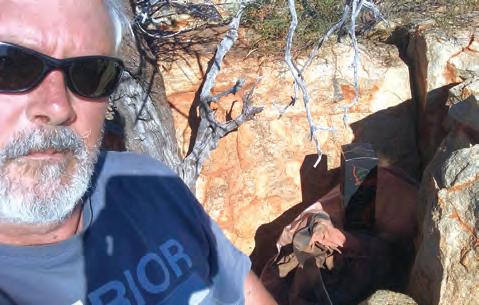


To the victor go the spoils. I exchanged the bottle of cognac with a bottle of liqueur Tokay I brought with me to swap. I signed
Carnegie’s red bluffseen from Nichol’s Knob.
the logbook – well, I left a piece of paper showing I was here as the original logbook had been water damaged. Whilst I rested, I reminisced about both Hann and Carnegie. They did this for months on end. I had only been going seven hours and I was stuffed. I take my hat off to them. My plan was to camp here the night and return in the morning. However, with every piece of real estate covered in spinifex, I had no choice but to turn around and head back for base camp.
That tree.
The Nichols Knob cache.
136 Western 4W Driver #118
A quick water audit was taken and I had used half my supply. With careful management all should be well. On the way to the Knob, I had waypointed some selected pieces of open ground in case I needed to retreat to them overnight. Good thing I did too, as one of them would end up becoming camp for the night.
So with an hour’s rest, tired feet and a feeling of elation, I turned west back for base camp. The sight of that 2km slow uphill sweeping plain of spinifex to start off with was not exactly a joyous thing to behold. By my calculations, I had 4km to get to the first piece of suitable ground. Once again after I crested that hill, I found myself off course, this time to the north. It put me into very crappy country. Lots of thick mulga and spinifex to traverse to get back on track. The afternoon sun was now bearing down on my front, I was feeling hot and I knew my water intake was becoming unsustainable. I had to balance my needs against my dwindling supply. By 4.30pm, some 26km and 10 hours after I had left base camp, I found a suitable clearing for the night.


I had an hour before dark. I had duties to attend to, but I was too exhausted to do them. I rolled out my ½” thick inflatable mat with the blown seam and lay on the ground for half an hour, sapped of all energy and aching like hell. But I needed to get up, it would be cold overnight and I had to get
The cognac.
some timber for a fire. I forced myself to rise to prepare for the night. I had minimal equipment. I had no tent, no sleeping bag, just a thin mat that won’t inflate anymore, a jumper, a beanie and a foil emergency blanket. I would be doing it tough. I didn’t even have a meal.
I had planned it would be a rough night and that it turned out to be. I had made some salami and cheese wraps to eat on the journey out which I never ate. Apart from a few muesli bars, I had not eaten a thing all day. I got a small fire going but try as I might, I just couldn’t get comfortable. It hurt my feet to stand, and it hurt everything else to sit on a log or sit on the ground. I could find no happy medium. I decided to toast my wraps, seeing they were foil wrapped. Scraping some coals away from the fire, wrap nicely toasted, I started to eat dinner. On the first bite, I knew I was in trouble. I was partially dehydrated and eating a wrap just dried me out more. I had to come up with a better idea as my water was low.A sombre view. The view from the knob towards base camp.
Western 4W Driver #118 137
I searched my food bag and discovered I had packed apples. Three of them. One for dinner would do nicely. The first bite of that apple was out of this world. I ate it down to the seeds, leaving nothing to waste. It perked me up immensely and I followed it up with another one. I attempted a celebratory drink of cognac before bed. Another fail. Apart from the fact that my dehydration would be made worse by drinking the stuff, it really is a wicked drink. Think of the most obnoxious chemical solvent you know, times that by a magnitude of 10, then think about drinking it. That is cognac. It is nasty stuff for the fit, let alone the weary.
Seeing as everything hurt, I decided an early night (about 7pm) was called for. I laid out my mat, propped my pack for a pillow, put on the jumper and beanie, and tried to get some sleep. My feet hurt to the point that I could not remove my boots easily. The emergency blanket, which I thought would be a great idea for the five degree overnight temperature was a dismal fail. It was like trying to sleep in a chip packet. If the wind didn’t keep blowing it off, the constant crinkle noise wouldn’t let the dead sleep. Trying to sleep was near impossible. It hurt laying on my sides, my feet ached when on my back. I could find no comfort. Consequently, I got little sleep.
The low overnight temperature did not help things either.
On my feet well before first light, I was cold, packed, and ready to go for the 11km trip back to base camp. The water audit revealed I was down to my last ½ litre. I made my way through the small granite outcrops, up the natural staircase, along the open granite ground on top, crossed the creek bed and arrived at the halfway point by 7.30am. With only 8km to go now, I had my last apple for breakfast and sucked the last drops out of my water bladder.
I had a brain storm whilst here. If I split my waypoints into roughly equal 1km distances, I will reduce my cross-track error, meaning less walking to be done. It is a psychological thing. When you are walking to a waypoint 2000m away, it takes forever for the counter to go down to something that resembles you are near. If you reduce that to 1000m intervals, 500m to go spurs you on, unlike say 1750m, 1500m and so forth. And it worked. I walked straight as a die and the smaller distances to go gave me incentive to keep going. Get to that waypoint and repeat. With 4km to go, the

 My patch of paradise - the overnight camp.
Approaching the natural staircase.
My patch of paradise - the overnight camp.
Approaching the natural staircase.
138 Western 4W Driver #118
selfie I took on the way shows the strain in my face. I was almost spent by now.
One foot after the other the distance to go slowly ticked down. By the time I reached the start of breakaway country, I knew the end was near. The ground was littered with small clumps of quartz and it was less of a chore to kick the buggers out the way rather than lift my foot over it. And then, through the mulga, I spotted the vehicle and base camp. I had arrived back to camp at 10.15am, some 28 hours and 39km after I had left. I had a wellearned drink of water and sat in a chair for a bit whilst I contemplated the enormity of my accomplishment. My boots came off to give my feet some respite whilst I contemplated packing up camp. It took me a couple of hours of rest before breaking camp and heading for Laverton. The two hour drive was a luxury compared to what I had just endured. Upon exiting the vehicle at Laverton Police Station, I found I was locked up like a frail old man. Huddled over, I shuffled my way to the counter and subsequently logged off as safe and well. I then contacted the outside world and let them know of my achievement – only the third person in 15 years to get to Nichol’s Knob. The only one on foot. I received a hero’s welcome from the geocaching community. No one could believe I would have contemplated such a task. Some may call me foolhardy, an idiot or even some other unpublishable term for attempting such a mission. I can accept that. However, I can also say with some authority, that unless one pushes
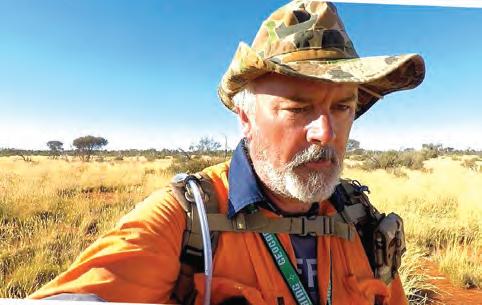
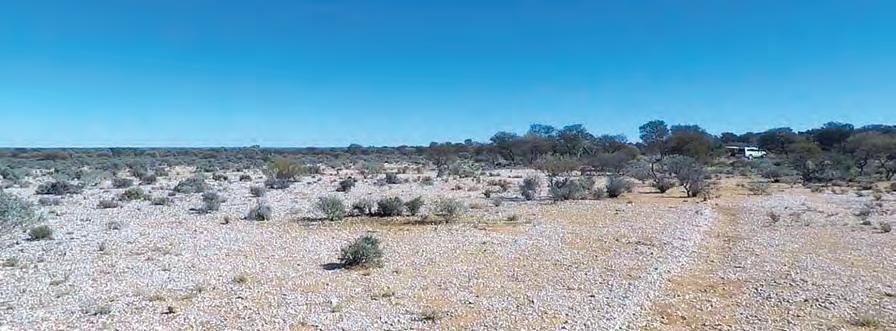
Only 4km to go.
themselves to some boundaries, you will never understand your capabilities or know your limits. I was confident in my abilities to achieve the task safely. This fine continent was discovered by men of courage, pushing into the unknown, and I admire those fellows greatly. To walk near 40km solo through virgin desert sure gives one an appreciation of their amazing feats, which lasted for months, not a day as in my case. I only wished like them, I had a team of camel to carry some supplies with me. From Laverton I made my way to the Kookynie Hotel to have a celebratory beer with Willie, the local wonder horse. I camped up at Niagra Dam for the night and had another attempt at the cognac. It’s still like drinking toluene 10-fold, even when you are hydrated but I earned this drop and I’m not letting it go to waste. The next day I made for home. I was on such a high. As the months passed, the high slowly eased and I searched for some other silly thing to accomplish to regain that feeling again. I had become addicted. What would I do next?
Spotting base camp.
Western 4W Driver #118 139
NUTS AND BOLTS
with BEN BROEDER
CLEARING THE AIR
When you are faced with the bill for a replacement engine, it’s often easy to go searching for blame ...

One of the easiest items to maintain on your 4WD vehicle is also often the least thought about and most neglected. Whilst many rush to fit secondary fuel filters to their all-terrain conquering beasts, many fail to give equal thought to their air cleaner?
All too regularly I see ‘dusted’ engines come through our workshop. ‘Dusting’ is a term used to describe an engine which has had foreign material, namely dust, ingested through its intake system, past the air filter, causing catastrophic damage to the engine.
The dust causes excessive and rapid wear to engine components, most often being displayed as a lack of compression in the engine through this wear, before the operator has even noticed the issue is present.

Clear evidence of ‘dusting’, Note the film of dust on the clean side of the air filter.
More evidence of dusting, Note the dust all through the clean side of the air filter housing.
Mining and other commercial vehicles need much more frequent air filter servicing.
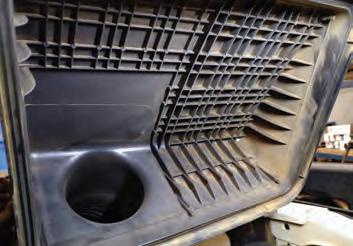

140 Western 4W Driver #118
That sounds expensive. how do I prevent it?
There are products to stop this problem from occurring, predominately after-market air boxes or modifications offered to factory air boxes. These all go along with the popular theme that “Modern 4x4 air boxes are no good and they cause dusting”. Well, this isn’t the entire story. Yes, the air boxes and filters in modern 4WD vehicles generally aren’t as good at dealing with excessive dust ingestion. But the problem is the dust itself.
Modern 4WDs aren’t designed to be bumping around the paddock all day like a 40 Series of an early Land Rover. They are highly-tuned, high-performance vehicles, predominately designed for operation on highways and light off-road use. As such, their air intake systems are designed to maximise air flow to the engine whilst not being intended to deal with thick bulldust and the like regularly.
Modern air filtration systems are predominately built for maximum air flow.
No matter what the air filter make or style, there is a limit to how much dust and debris it can handle before it’s time to be replaced. It’s quite simply a case that air filters are not being replaced when they are due, which is the main cause of the problem. Check and replace your air filter regularly!

Applications for full time dusty environments will virtually never run ‘factory’ style filtration equipment.
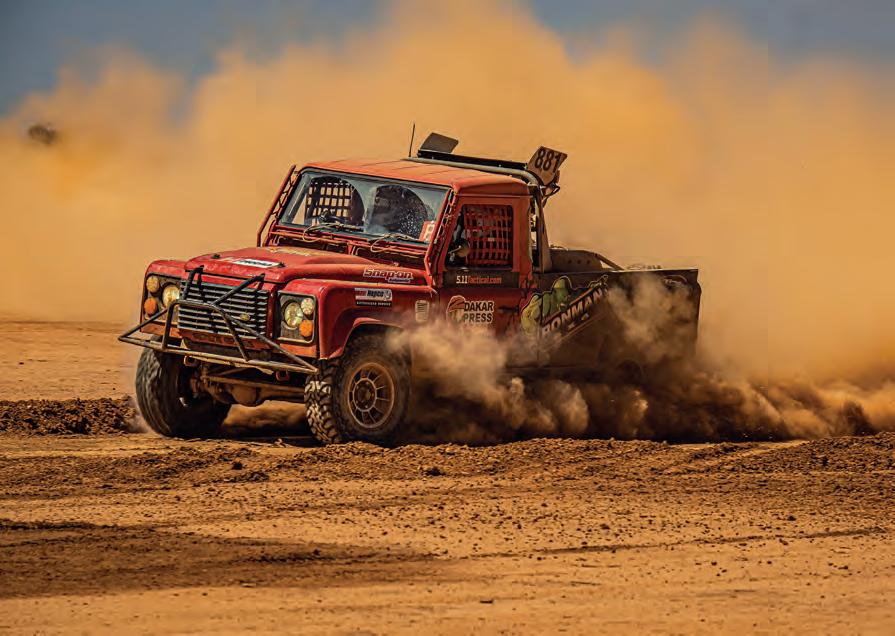
Western 4W Driver #118 141
It can’t be that simple, Can it?
Whilst there are many contributing factors, in my experience, the bulk of engine failures due to dust ingestion are due to air filters not being changed regularly enough.

Take for example the service schedule of many 4WD vehicles, particularly those who utilise capped price servicing from the manufacturer. Many manufacturers will specify an air filter change at anything from 20,000-60,000km intervals. Yes, the service centre should be checking your air filter and advising you that it needs replacement, but on your $120 service, how much time do you think many workshops spend checking vehicles thoroughly?
For many modern air filters, they are designed to cope with high volumes of air flow for our modern high-performance turbo-charged diesel engines. Take for example the flat style air filters found in Toyota 1VD engines. These large, flat filters can filter large volumes of air, which the engine requires. With a clean filter element, air flows through the filter with little restriction.
As the filter becomes more ‘blocked’, there is more and more restriction to this air flow, creating a lower pressure on the clean side of the air filter. This pressure differential starts to deform the air filter, pulling its sealing surfaces away from the air box and allowing unfiltered air to enter the intake from the edges of the filter.

How quickly can this happen?
In extreme operating environments, even with a snorkel, your air filter can become blocked and effectively unserviceable within a few thousand kilometres. If you regularly drive on unsealed roads, not even 4W driving, it’s common for air filters to only last 10,000-20,000km at best. Not the 40,000+km the manufacturers intend with on road use only.
This filter belonged to a Prado which had only done 30,000km when it was bought in to us as it wouldn’t get over 80km/h.
A heavily contaminated filter. This one still had 20,000km of life left, according to the service schedule.
How can a blocked filter cause the issue? It’s the air box!
Yes. Dirty air filters that are too blocked with dust and debris cause this issue very regularly. There have been all manner of accessories and after-market air boxes built which can save you from dusting your engine, but they are merely addressing the symptom of dust bypassing the air fi lter element and not addressing the issue that the air filter is blocked and needs to be replaced.
142 Western 4W Driver #118
How can I prevent this from occurring?
Quite simply, the best advice is to regularly check your air filter. If you remove the air filter from your vehicle, you can check it both visually and by dropping it from a small height, say 100mm, onto a bench or solid surface.
If dust falls away from the air filter, it’s blocked and needs to be replaced.
can ‘blow out’ your filter with

air, however this will not remove the finer debris from the filter.
is generally an ‘on the track’ practice
keep you going for your trip, but you should still replace the air filter as soon as practicable.

If you do remove your air filter to check or clean it, make sure you are familiar with how your air filter should be correctly fitted and how to correctly ensure the air box has been re-sealed or closed correctly. Many times we’ve found improperly fitted air filters and air box covers at fault as well.
Washable filters
Ryco, K&N, Unifilter and others all make washable, reusable air filters. Many of these are far more effective than disposable paper air filter elements, however, take care, these filters can become blocked more quickly. But they of course have the advantage of being able to be cleaned and re-treated ready to be used again at the fraction of the cost of disposable elements.
Hotspot no longer!

INTERNET ON THE MOVE Save 15% using code W4WD at checkout www.performancetune.com.au ☎ 1800 722 324 $349
With options for 3G, 4G and 5G, our wireless router will give you improved mobile signal when touring or parked up at your favourite campsite.
You
compressed
This
to
Western 4W Driver #118 143
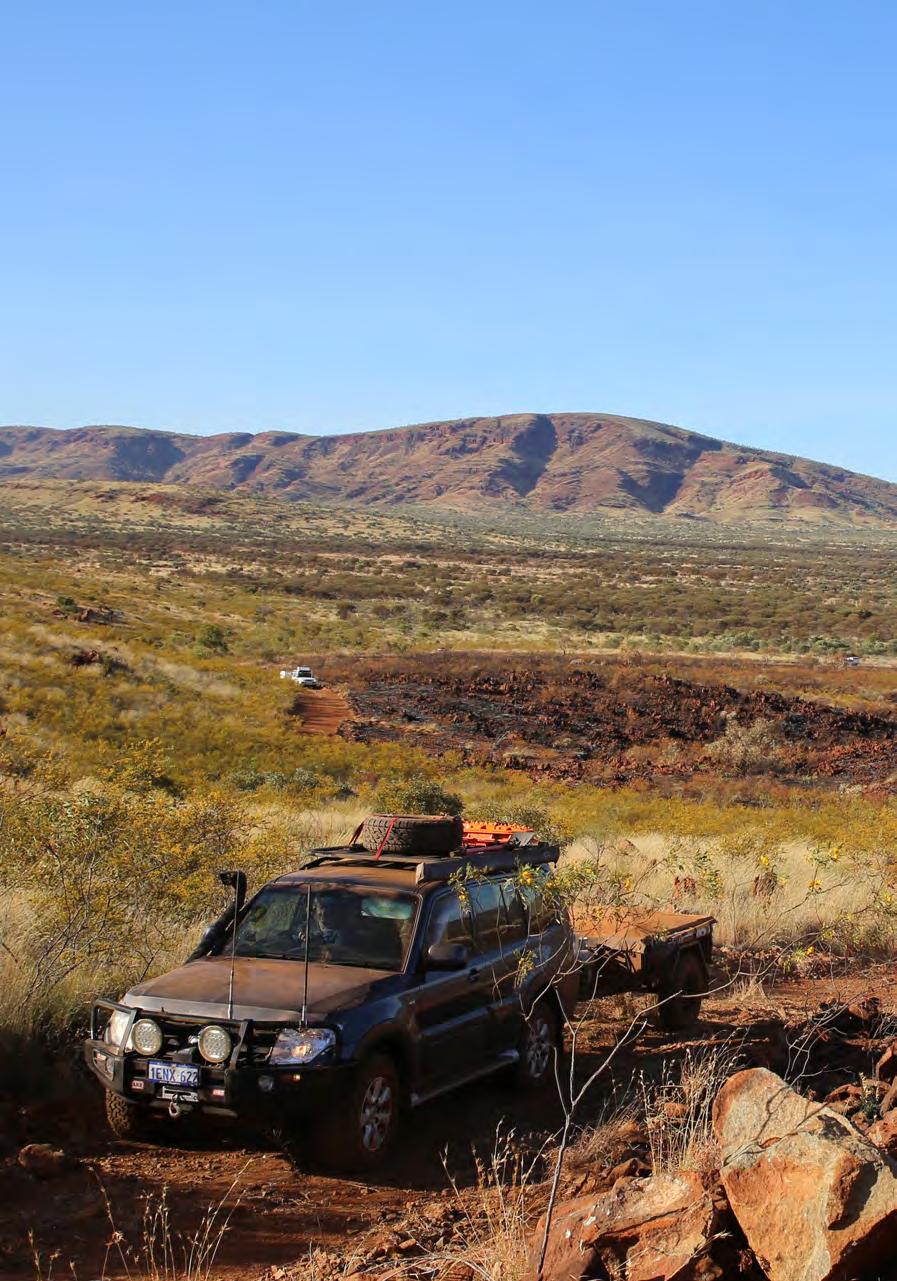




















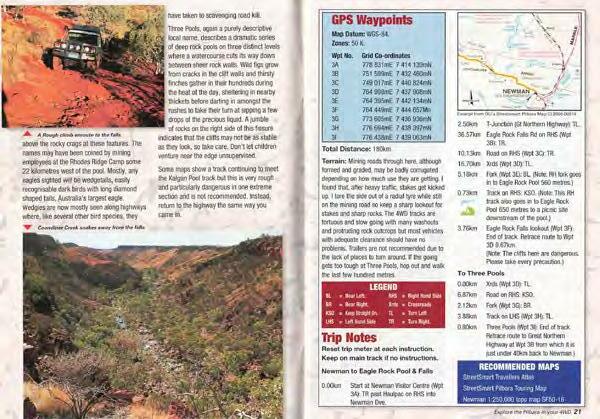
EXPLORER SERIES Western Australia: No 6 PILBARA Explore the in Your 4WD fabulous 4WD adventures in Western Australia’s rugged north-west 20 INCLUDES TRIPS SUITABLE FOR SOFTROADERS The painted, multi-hued Pilbara. Boasting fabulous waterholes and superb gorges, deep slashes in the elevated plateau and narrow gaps in the razorback ridges, these ancient rocks, glowing red at sunrise and sunset, dominate the landscape. Almost all our trips will take you away from caravan parks, campgrounds, shops, crowds, walkways and signs. Most trips require a 4WD or at least greater clearance than conventional highway transport. We’ve deliberately stayed away from well-known tourist attractions accessible to 2WD vehicles. Don’t miss them while your up there, but expect to share them with crowds of other visitors. Product features: • History of the area • Locality maps • Travel advice • Trip notes and GPS waypoints for each trip • Descriptions of features to discover along the way • Flora and fauna DISCOVER AN ANCIENT LANDSCAPE An epic adventure to our earliest beginnings. See landscapes shaped by violent creations and meteor strikes dating back billions of years and over 700 indigenous archaeological sites with rock engraving 30,000 years old. Discover remoteness, bathe in rocky gorges, walk pristine beaches and listen for stories of our ancient past. www.western4wdriver.com.au/shopORDER YOUR COPY NOW! $19.95 Western 4W Driver subscribers SAVE 10% when ordering online!
OUTBACK SURVIVAL
with BOB COOPER
4 tips for COLLECTING WATER
Water. We take it for granted. Turn a tap or grab a bottle out of the fridge and you can easily quench your thirst but what happens if there isn’t a tap or a convenient location to sate that need? If you intend to travel anywhere outside of an urban environment, especially in Australia, you need to have an understanding of how you can procure water to survive. This column from renowned survival expert, Bob Cooper, takes us through four simple methods to secure drinking water that could one day save your life.
Plastic Bag and Transpiration Method
The bag over a tree branch or ‘Transpiration Method’ is both easy and simple to do.
Above the simplicity, is the fact it produces the best results for your effort amongst all of the other techniques using plastics. Another positive factor with this method is that it fits into what I believe is the ‘energy equation’ for survival. That is: one X effort must yield you two X in return.
This method works by placing a plastic bag over a tree branch, leaves and all, and making it airtight by sealing it with string.
Choose a branch that receives as much direct sunlight as possible. This will create excessive heat on the leaves and the tree will attempt to cool that micro-environment down with moisture vapour. This cooling process, akin to our sweating, is called transpiration in plants.

All plants transpire pure water and that’s what we are tapping into. Some transpire more than others, with the largest of our eucalyptus trees giving off as much as 200 litres per day in water vapour.

The plastic covered branch then sends a distress signal down to the lateral water storage roots of the plant to pump up more moisture to cool it down via the branch. The vapour condenses and water is formed. The greatest yield I have witnessed is 900 millilitres from a single bag in one day.
Water from Tree Roots
Trees store their water in the lateral roots growing just below or on the surface. The more reliable trees are large acacias (wattles), eucalyptus (gum trees), kurrajongs, casuarinas (she-oaks) and the boab. An easily obtainable supply of exposed tree roots can be found in most dry creeks or river beds. Bigger trees have a bigger storage supply, so don't waste your energy digging up sapling roots, they produce very little water.
Western 4W Driver #118 145
Start as close to the tree trunk as possible and dig out the roots which are between 50mm to 100mm in diameter.
Cut the root into lengths of 1-2 metres. Scrape off about 20cm of bark from around the thicker end.
Invert these into a plastic bag or any sort of 'bucket', even a clean, deep rock depression, with the shaven, thicker end facing down. Water will seep out.
As much as a cupful has been recorded from a single two metre root.
It is advisable to purify this water. Purifying all water obtained from the bush is something every survivalist should do to reduce the possibility of health issues.
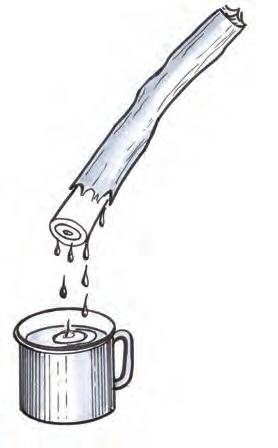
Collecting Dew
At dawn, a life-saving amount of water in the form of dew can be collected from a vehicle body’s surface and also from sheets of plastic laid out overnight.
Your credit card can 'buy' you some water - when used as a scraper. A soft absorbent cloth 'sponge' used to mop up the dew and then wrung out regularly into a container or plastic bag will also help you to survive another day. Dew also forms on some hard, smooth rock surfaces and can form small pools of water.
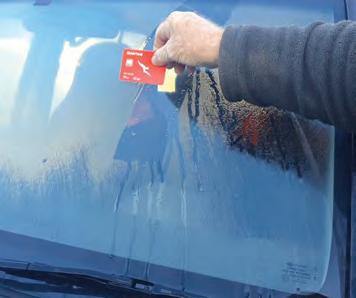
You can also collect dew from low bushes or moist grassed areas in the early morning by tying your shirt around one ankle and your trousers around the other ankle. Walk through bushes and grasses, allowing the cloth to soak up the water, wring your clothing out frequently into your container.
Again just to be safe, purify this water before consumption.
Ground Succulents For Water

We only have one that I am aware of and that is commonly called 'Pig Face' or scientifically Carbobrotus With this plant we can squeeze out lifesaving water by crushing it in your hands and letting it dribble into your mouth, Kalahari Bushman’s style, using your thumb on your upper front teeth as a guide for the water flow.
You can gain more by wrapping loads of ‘Pig Face’ in your shirt, roll it up tight, crush it with your foot/boot and wring it out catching the water on a plastic sheet that has a depression in it. The softer yellow/green leaves seem to offer more water and is less salty to taste. This is what kept me alive for three days on my SAS survival course.
The whole plant is edible and the seed pods (when dark red) have a mild, sweet fig like taste.
146 Western 4W Driver #118
Drones,






hate them
with a









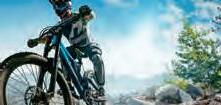












DJI currently hold the market share in the consumer drone market with their extremely easy to operate models that make an expert out of almost anyone. Their latest offering, the DJI Air 2S builds on the already successful Mavic Air with multiple improvements. The Air 2S gets a larger 1” sensor, same as the Mavic Pro 2 model, better obstacle avoidance (because crashing is not cool) as well as a new tool called Master Shots. Master Shots gives beginners an additional mode to fly the
EYE IN THE SKY

DJI Air 2S Drone
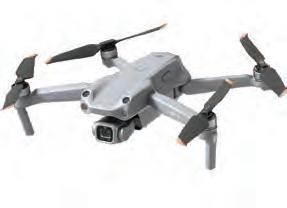






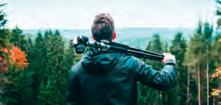
drone in auto, grabbing some pro-looking footage. Air 2S has an extra 2km of flying range (now 8km) however you still need to ensure that you always maintain a visual line of site with your drone. Air 2S also comes with the ability to zoom the camera in. Normally digital zoom should be avoided, however with a resolution of 5.4K there are options to crop your image while still retaining the quality.
Starting at $1699 for the drone or $2099 for the drone with fly-more combo, the Air 2S offers pretty good value for money.
Speak to the team at Camera Electronic or purchase online from www.cameraelectronic.com.au




















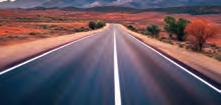




Store Locations 230 Stirling St, Perth. T (08) 9328 4405 324 Murray St, Perth. T (08) 9225 5966 Shop online at www.cameraelectronic.com.au FIND THE BEST IN PHOTOGRAPHY AND IMAGING GEAR DRONES ACTION CAMS UNDERWATER PHONE ACCESSORIES DASHCAMS GENERAL PHOTOGRAPHY NCAMS RWATERACT S RAPHY
love them or
you must admit that they have brought capabilities to the masses that not too long ago were completely out of reach. Where once you needed, at minimum, a helicopter, experienced pilot and someone with a camera, the everyday person can now capture movie quality footage
relatively cheap drone.
Western 4W Driver #118 147



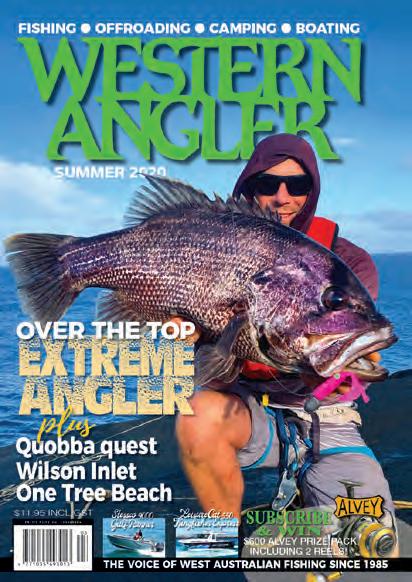
FISHING l BOATING l CAMPING l OFFROADING Bigger and better than ever, and now quarterly! Subscribe to WA’s best fishing magazine for only $45 at www.westernangler.com.au $45 ONLY POSTED TO YOUR DOOR
Keeping things compact and well secured is important for off-road destinations.


Western 4W Driver #118 149
With long hauls however, there is no excuse for the most common breakdown and that is a failed wheel bearing. No big trip with any trailer (particularly boat trailers that are regularly submerged in salt water) should go ahead without a pre check of the wheel bearings.
carrying capacity. When relying on just the single vehicle every part of possible cargo space becomes important. A roof mounted camper setup makes the sleeping side easy and provides more room inside but negates the ability to carry gear on a roof rack. Some make use of split-fold rear seats for more internal cargo room as a simple extra.

Cargo barriers, roller drawers and other effective storage compartments go a long way to making sure things remain in the right place, even more so on rough roads. A part of that is accessibility as things can be more easily located in separate compartments without unloading a pile of gear to get at things that might be needed on the trip.
The length of the trip and the remoteness of location will also have a big impact on the 4W driver’s standard dilemma about what essential spares need to be taken. The more remote and distant, the more thought needs to go into tools and basic spares. If it will involve serious offroad conditions or terrain then the recovery gear can’t be left out. Every 4WD set up is slightly different, particularly when it comes to space and
There’s no doubt that in towing a boat or camper trailer there’s an effective 'dog trailer' behind you to carry a lot more gear, but it will limit your capacity in certain off-road terrain or conditions. It will balance the load and provide more carrying capacity but give a lot of thought to where things will be stowed according to when and how it might be needed. And remember there are strict limitations on tow ball weights and load carrying rules. Keep any spares, tools, jacks and the like in an accessible spot such as the boat. There’s nothing worse than having to unpack a whole cargo bay to get to a tyre lever or jack buried underneath at the lowest level.
Once you know what things you need to take and whether you’ll need any of them along the way it comes down to packing the gear. Weight distribution is vitally
Simple innovative internal storage solutions continue to emerge and make life easier.
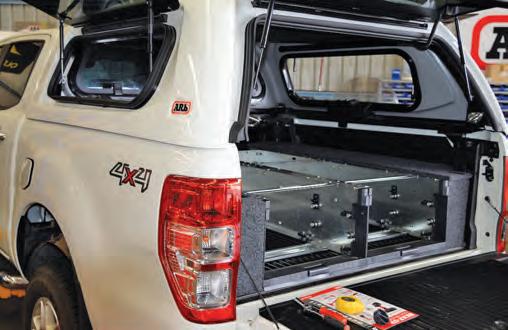 Roller drawers are a great way to maintain accessibility.
Roller drawers are a great way to maintain accessibility.
150 Western 4W Driver #118
important along with making the best use of available space. Putting all of the really heavy items right up the back of the vehicle isn’t a great idea as steering can become compromised. Really heavy gear on a roof rack is not a good idea on very rough tracks either. It’s all about balance and even distribution. Consider that balance and weight distribution carefully if you are towing a decent boat for example. There’s the legality of the load but also what it does in dropping the rear down, especially if the vehicle is running standard factory suspension. Air bag levellers often work well in these situations. Dual axle trailers should have much of the weight sitting over those axles.
Bigger bulky items that take up a lot of space but are actually light are best placed inside on top of other items. They allow the rear section to be used fully and can usually be compressed a bit to fit into the remaining space.
Small softer items are great for filling the gaps and providing some padding or a buffer while at the same time ensuring that there is very little movement as the vehicle bucks and rolls over rough country.
Towing a boat adds carrying ability but brings extra challenges and considerations for legal loads.
On the rack or boat tie things down very securely and pack them in such a way as to stop them from catching the wind or flapping. I had to dodge a loosely packed swag on a recent trip which was much better than the flying aluminium solar panel from a few years back that came off a passing caravan and into my front end. That wreaked more than a little havoc. Make sensible use of the map pockets and door storage areas which are now so common on vehicles and keep the underseat areas for important items such as torches and essential tools (for spotlight adjustment, for example). Fragile things (like fishing rods) require more than an afterthought and tying them on to the roof rack in narrow scrub trail country might see you adding to your 'two-piece' rod collection. Pack them carefully or use a fold out SCUTE transporter to see that they get full protection. How you go about preparing and organising your gear is without doubt largely a personal exercise depending on what kind of trek is involved, your particular 4WD and the amount of storage space. The last thing people want is some mishap due to poor packing upsetting a great trip.

Western 4W Driver #118 151
WOMEN IN 4W DRIVING
BY CHRIS MORTON
Amalia Townley
Go Camping and Overlanding
Bubbly
and vivacious, Amalia Townley is usually the first person you will meet walking into Go Camping and Overlanding in Balcatta. This 30-something pocket rocket loves her job and is passionate about sharing all the hints and tips that she has picked up from her own camping and 4W driving adventures.

It wasn’t always like that, however. Prior to 2015 Amalia wasn’t really sure what a 4WD was and it was only after she and her (now) husband decided that they wanted to venture out by buying a Ford Ranger Wildtrak and a camper trailer that she really discovered her love affair for the great outdoors.
In 2016 she and her husband Aaron met Ronny Dahl after heading out on one of his tag-along tours. Further tours followed as they saw it as a way of learning how to operate their vehicle off-road and at the same time explore some remote places. She was hooked, quickly embracing the adventurous spirit and wanting to get out more. In 2018 she was offered an admin role to assist Ronny with his business which saw her exit the corporate 9-5 world that she felt trapped in.
152 Western 4W Driver #118
For 18 months she worked for Ronny and along with admin tasks, she was quickly exposed to video and photography skills. Her social media experience grew from her updating her own social media profile so that friends and family could keep track of what she was up to.
She met Aaron from Go Camping (it was only Red Roads at that time) at the 2016 Perth 4WD Show where they bought a fire pit. She later helped them out working on their stand at the Caravan and Camping Show before Aaron called her and asked her to come and work for him in his new store he was opening up.
By the time this article goes to print Amalia will have been working at Go Camping for two years.
Her passion is clearly evident every time you enter the store. She loves working for a small business and truly wants to see the business thrive. “There are too many big box stores that churn out mass-produced gear that just doesn’t last the distance,” Amalia says. “It is refreshing to work for someone who is truly passionate about outdoor adventure and making sure you have the right gear that will last the distance.”
Amalia truly practices what she preaches, heading out bush whenever she can and using the gear that she sells.

When I asked her what she loves most about her job
she said that she loves talking to people and ensuring that first-time campers have a positive experience. A less-thanpositive Year 7 camp would have scared most people off camping, however Amalia uses that as her inspiration to ensure that anyone she meet's first time is a success. “COVID has seen a dramatic increase in the number of new campers coming into the store and it's exciting to help them discover the joys of camping.”
When she is not out camping or serving customers at work, she likes to channel her inner creative; drawing, painting, pottery, making her own birthday cards or getting behind the camera to capture some still images. She also revealed an adrenalin junkie side, admitting to loving carving up the slopes on a snow board or sand board or wake jumping on a wake board.
Amalia truly practices what she preaches, heading out bush whenever she can and using the gear that she sells.
Western 4W Driver #118 153
With over 40 years experience teaching Outback Survival,

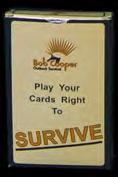

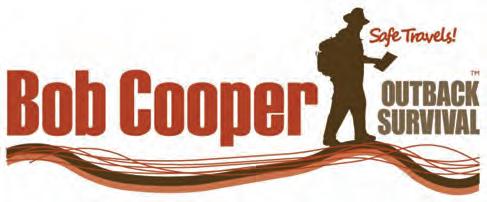

the ‘Trilogy for Survival’.
time
go bush,
should
doesn’t go to plan and
–
Three
Quality survival blanket. This one spells HELP.

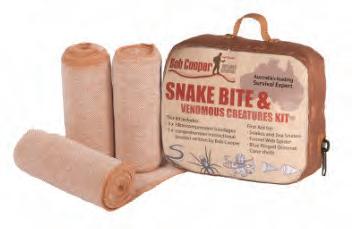
A quality emergency/survival kit. $89.95
stretch elastic bandages. Multiple uses and first aid. $29.95
$19.99
Bob Cooper has produced what he calls
Along with enough water, Bob believes every
you
no matter what form of transport, these three items
accompany you in case something
you’re in an emergency situation
anywhere. Bob’s best selling book $24.95 Playing cards with a survival hint on each card. $10.00 Also available Check out these items and more at www.bobcoopersurvival.com
GEAR TO GO CAMPING
Nomad Chimney Stove

Bushcrafters, outdoorsy people and campers alike, rejoice in the arrival of this portable, high-performance chimney stove. Precision-made 304 Stainless Steel means this chimney stove is strong but remains lightweight, with great engineering and attention to design detail. The 'Nomad View' as it sounds, gives you a lovely little Bush TV and also enables you to keep an eye on what is happening with the fire inside. A range of accessories such as water tanks and pipe ovens add to the versatility for base camping.
Available from: Go Camping and Overlanding in Balcatta www.gocampingoverlanding.com.au
Helinox Seat Warmer
Have you grabbed your Helinox chair from Go Camping & Overlanding in Balcatta yet? Well if so, you can now buy yourself a cushy little seat warmer for it - perfect for the upcoming winter months.
The Seat Warmer slips over your Helinox Chair and provides your backside with a soft and warm cushioning and draft protection for those chilly outback evenings. And if you haven’t got yourself a Helinox, head to the store to check out Australia’s best selection of these innovative chairs and tables.

Available from: Go Camping and Overlanding in Balcatta www.gocampingoverlanding.com.au



Western 4W Driver #118 155
Red Roads Charcoal Starter
Let’s get this party started!! Adding to their already top-selling range of fire pits, is the Red Roads Charcoal Starter.
A folding box design gives stability and maximises airflow to get your charcoal or heat beads started. During our tests, we also used it as a standalone cooker, placing a frypan over the top and whipping up some tasty bacon and eggs.

It’s a lightweight stainless, so we wouldn’t recommend a massive fire inside of it, but to get things started it’s perfect, and the lightweight nature means it’s not weighing down your car or trailer.
Available from:
Go Camping and Overlanding in Balcatta www.gocampingoverlanding.com.au
BAREBONES HATCHET

The Field Hatchet from Barebones is, as they say on their website, “Crafted for precision”, and let’s face it, who doesn’t like a precision cut!!

The blackened steel blade, the hickory handle, the pretty little blade sheath – this thing has it all. It is lightweight and compact which keeps your GVM down. A hatchet is an essential on camping trips, so if you don’t have one or are looking for a nice keepsake, check it out.
Available from: Go Camping and Overlanding in Balcatta www.gocampingoverlanding.com.au
GEAR TO GO CAMPING
156 Western 4W Driver #118
Red Roads Firewood Carrier & Tarp
Another cracker from WA’s own Red Roads, made here in sunny Perth using genuine Aussie Canvas (from Bradmill we are told) and not made from that synthetic stuff which wears out after a couple of years.
This product, as are all of theirs, is finished beautifully with brass and leather detail and goes through an extra process which binds the edges to hide exposed edges which adds to longevity. The Wood Carrier does exactly what it says, carries some sizable bits of timber back to camp for the fire. We loaded it with about 40kg and two of us carried it back to camp. But the fun doesn’t stop there, the size of the product is pretty perfect for laying down while checking or fixing underneath a car or to lay your tools on whilst doing repairs out on the dusty 'red roads' of Australia. We found a heap of much cheaper options online, but none were made of canvas, and certainly none made right here in Perth!!
Available from: Go Camping and Overlanding in Balcatta www.gocampingoverlanding.com.au
rugged xtremes bags


Stowage. The ancient art of cramming gear into your 4WD while still being able to lay your hands on any one item at a moment’s notice. The team at Rugged Xtremes produce a range of bags and storage solutions that are perfect for the weekend warrior looking to keep all of their gear in one place. We got our hands on one of their Fire Stowage bags and found it perfect for carrying the bulk of our camera gear. Used in conjunction with several of their crib bags you end up with a very versatile storage system that easily transitions from the garage shelf to the back of the car. Knowing that everything is packed away and being able to grab exactly what you need when you need it makes these bags a great alternative to plastic crates or for those who do not want to spend money on a dedicated drawer system. At $79.95 for the stowage bag and $29.95 for the small canvas crib bags they are more expensive than a Bunnings crate, however their tough construction ensures that you will get many years of service from them while offering adequate protection for the potentially expensive equipment stowed within it.
Go to www.ruggedxtremes.com to find your nearest stockist.
GEAR TO GO CAMPING
Western 4W Driver #118 157
The Value of Volunteers
away and not just sit around and still need to keep busy.
Every single one of us has at some time been the beneficiary of a volunteer organisation or been a volunteer. I feel that I was born to it as both my mother, father and grandparents always volunteered their time and talents willingly and freely from before I was born.
I have always found that being a volunteer rewards me much more than any money could ever pay. There is a certain joy that one experiences when a job, task or service is done without the expectation of payment and is given with kindness and the only reward is to see something or someone else happy or helped.
Many of our volunteers have reported a significant improvement in their mental health as well as their level of activity and just general health and well-being. This phenomenon is now known as the Melangata Magic and quite often it is so strong that they don’t want to leave.
Over the years that I have been involved with the 4WD fraternity I have experienced many clubs, groups and individuals taking on projects and adopting places to be maintained, repaired, cleaned up and just generally left better than they were.

Melangata, as I have mentioned before, is the recipient of many hours of work from enthusiastic people who want to come

Pulling old star pickets.
This past April, the Friends of Melangata Station busy bee saw an amazing amount of work done and jobs ticked off the 'wish list' although it feels like the Friends of Melangata view my wish list as more of a challenge than wishful thinking.
The gateway into the camp ground has now been moved away from the facilities and a new entry statement has been made. New shelving has been installed in the cook house for the book exchange, toy and game library. There are now new gravel paths at the shearers' quarters and around the homestead and garden furniture has been rejuvenated and positioned in various sheltered locations around the grounds.
The glamp camp has been put back up and the area defined by quartz rocks collected from around the property.
Furniture has been moved around to create different room configurations in the homestead and the shearers' quarters and little jobs I have been wanting to get done that I have not been able to get to have all magically been completed.
All the wire and old posts from a fence that was washed away has been carefully wound up and the fence line cleared and let’s not forget the stunning efforts of my army of wonderful weeding women who made short work of the couch infestation
Closing off the original campsite entrance.
Where would we all be without volunteers?
158 Western 4W Driver #118
in the garden beds so I now have a blank canvas to fill up with flowers for spring (so long as I can keep the Maremmas off it).
Most of April's Friends of Melangata group were repeat offenders and as such know the lay of the land pretty well and it takes no time at all for them to get started on something. Most of them now know how to build a fence, operate the bobcat and the various attachments, drive all the station vehicles (although most are itching to learn how to operate Dorothy the dozer. That will be for next time).
Keen and passionate we are, but swimming in money we are not, so to make things just a bit more challenging most of the materials that are used are recycled from around the property.
Most of the solid, up to 100-years-old, mulga fence posts had been salvaged when we were putting in new fences and have been brought back to the homestead to be repurposed elsewhere around the grounds.



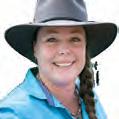
Corrugated iron from various outbuildings
CLEWED
that have been dismantled has been used for windbreaks and repairing other buildings.
Salvaged timbers from a little old shed that was destroyed by a freak summer storm in 2018 have been used throughout the veggie garden to make shade structures for summer. Absolutely nothing is ever just rubbish and most things will have a second or third life as something else if it waits around long enough.
Melangata Homestead is a special building and as such I feel a responsibility and obligation to do my best to preserve it so it is still here in another 100 years. I also don’t have a problem with calling on other people to help me out as in all honesty, even though we pay the mortgage, the building sort of belongs to all of us and the more people that feel a connection with the place, the greater chance there will be that there will always be enough extra passionate people out there that will take up the challenge to make sure that it does indeed survive into the future.
Special thanks go to all our past volunteers and especially our latest group: Barry and Ann, Peter and Joy, Jane and Bruce, Adrian, Pauline and Laurie, Mark, Allan and Janet.
I feel sure we will all meet again.
Benches getting some TLC. Our hard-working volunteers.
UP
with JO CLEWS
The newly defined glamp camp.
Western 4W Driver #118 159
Nachos
If you know me (heck even if you don’t know me) then you will know that I will encourage anyone to have a go at cooking just about anything they can think of in their camp oven.
The general rule is 'if it can be cooked in your oven at home then it can be cooked in your camp oven'. This means all those tried and true family favourites you create at home can be recreated whilst you are out camping.
Sometimes a full blown meal is not always required but a tasty morsel is appreciated and nachos fit the bill perfectly. They are quick, easy, everyone loves them and will be quite a surprise to your mates when they are removed all golden, hot and dripping with melted cheese from your camp oven.

This recipe will make two 22cm plates of nachos.
You will need:
1 bag of corn chips, your favourite flavour
1 400g can of kidney beans drained and lightly mashed
1 jar of salsa, your choice of heat
1 onion, finely chopped
½ red capsicum, finely chopped
1 cup of grated cheese
6 spring onions, finely sliced
2 tomatoes, finely diced
200g tub of sour cream
2 tablespoons oil
In a pan on the stove top heat oil and lightly fry ¾ of the diced onion and ¾ of the diced capsicum until onion is just slightly browned. Add the salsa and beans and cook for a further five minutes.
Evenly divide the bag of corn chips between the two plates leaving a hole in the middle for the bean mix.
Spoon bean mix in the centre and sprinkle the corn chips with cheese, place in a moderate oven for five to ten minutes. Take care to check as the corn chips burn easily if the oven is too hot.
While cooking the nacho mix combine the rest of the onion, capsicum and tomato together in a bowl and mix together. Remove nacho plate from oven and spoon some of the tomato mix over the corn chips. Apply a generous helping of sour cream and finally garnish with spring onion.
I can guarantee that these will not last long so make sure you have plenty of extra ingredients on hand to whip up another batch. Enjoy.
160 Western 4W Driver #118
GOINGS ON
Plenty has been happening within the WA 4WD scene over the last three months with record sales, extremely high demand for product and more people than ever exploring their own home states. As the pandemic stumbles along slower than a mob of ravenous zombies chasing toilet paper hoarding shoppers, we catch up on the latest gossip and events from within the industry.
Action 4WD Kelmscott
After 22 years Action 4WD closed their doors at the end of April. The business re-opened on 3rd May in their brand new ARB flagship store located at 3 Argong Chase, Cockburn Central. The new store has been purpose-built and is only the third
privately owned flagship store concept built in Western Australia.

The new store boasts a team of 4WD enthusiasts who are ready to assist you with kitting out your pride and joy with the very best accessories to ensure that your next off-road adventure is a memorable one.
ARB Wangara
For anyone travelling along Buckingham Drive in Wangara recently you will most likely have noticed the installation of a brand new ARB sign alongside a brand new black and red building. The new site is the latest edition to ARB’s flagship concept store fleet and is expected to open by the end of June. The new store will bring a 'next level' experience to customers with a welldesigned showroom designed to highlight the range of products and accessories to 'get you out there'. The original ARB Wangara store is still open for business.
 ARB's new store at Cockburn Central.
ARB's new store at Cockburn Central.
Western 4W Driver #118 161
ARB Karratha
For anyone keeping count, ARB Karratha will be the fourth privately owned flagship store to open in WA. Expected to be ready for business sometime soon after this edition goes on sale, the new Karratha store will provide locals access to the same retail experience enjoyed by us city-slickers, with just a little red dirt thrown in for good measure.
Vanguard Media Group acquires Western
4W Driver Magazine
In case you missed it, Vanguard Media Group, who have been printing both the magazine and guidebooks since 2015 have merged Western 4W Driver into their Premium Publishers division. The acquisition provides Vanguard Media Group with a substantial increase in content creation and expands their already extensive tourism portfolio.
Chad van Heemst, Managing Director of Vanguard Media Group, said, “The acquisition represents our first foray into retail print media and will allow us to further develop the already existing product range with an expanded range of new titles and content aimed at the 4W driver and touring market. Our tourism experience will further allow us to provide a greater range of content for Western Australian destinations.”
Chris and Karen Morton remain as editors of Western 4W Driver and will continue to develop new content and titles in the 4WD and touring space.
TJM O’Connor
With the closure of TJM O’Connor not too long ago, TJM have opened a brand new corporate store just a stone’s throw up the road. Located at 380 South Street, O’Connor, the new store also boasts an adjoining Aeroklas Fitment Centre which shares the 400m2 showroom, as well as a spacious 1100m2 workshop. The new store provides the complete range of 4WD accessories, vehicle protection, communication, electrical and a range of camping and touring related products.

Nullagine Caravan Park
A rain event back in December resulted in the Nullagine River getting a little overexcited. The biblical downpour resulted in the Nullagine Caravan Park submerged by 1.8m and caused significant damage to the park’s infrastructure. Repairs are underway and the East Pilbara Shire are hopeful to see the park re-opened by the end of June. Visitors heading to the area are encouraged to call ahead.
GOINGS ON
The new TJM O'Connor store showroom.
162 Western 4W Driver #118
TRACK CARE WA NEWS
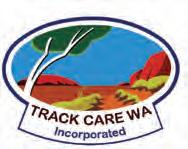
NARLOO, NOT GNARLOO
Easter 2021 trip with multiple 4WD groups
TCWAand the 4WD Club of WA coordinated a combined trip to Narloo Station where TCWA had previously done restoration work on the homestead and installed a water pump. The original TCWA aim of the trip was to perform maintenance on the homestead over the Easter break, but with the original recci cancelled due to a wayward trailer the Easter trip became the recci with a small clean-up project to be decided while on site. The second part of the trip was to perform another recci to Woolgorong and Woolgorong Outcamp while we were in the region.
The 4WD Club of WA aimed for a social trip to allow the two groups to mix and meet while enjoying and learning new things. The plan was to have sessions where people could listen and question various topics that relate to 4W driving, camping and enjoying the great outdoors. To this end, there were sessions on Body Awareness, Using Drones, Camp Oven Cooking, All things Electrical, Photography and Fault Finding (using Karl F’s vehicle as the source of faults).
By Graham Weber
The President of the 4WD Club of WA (Karl F) and the Chair of TCWA (John C) had also arranged with Geoff Lewis (Seriously Series) to have an outdoor screening of his movie Road to Ruin which was hilarious because we came in to Narloo on the 'Road from Yuin' ... to Narloo!

What a great movie! If you ever get the opportunity, go and see it!
Some TCWA members wanted to perform maintenance on the water pump due to some reports coming in that described the water coming from the well as something very unlike water. More like a black/brown sludge really. With an early start, the team had pulled the piping out, cleaned the filter mesh at the bottom and repaired/rebuilt the pump. By 9.00am the pump was back in place and producing lighter brown sludge. Several pumps during the day got the output of the pump looking more like water but still brown. The lesson here is that when a site has non-potable water take note! It may not be drinkable in any form. Even when allowed to settle this was not what the average Joe would consider drinking.
Sunset at Narloo.
Western 4W Driver #118 163
By the end of the day we decided to follow an old tradition of the site and attempt to fill an inflatable paddling pool to allow us to cool off (with maximums from 38-43 degrees this seemed worthwhile). The water was still brown and dirty but definitely closer to water now. After about 20 minutes of pumping and several spilled buckets we got enough ‘water’ to half fill the pool. The water was cool enough for the ‘Beach Babes of Narloo not Gnarloo!’ to get in and wet. There were many events that happened over the Easter weekend. This was a good example of why being a member of a 4WD club or a focussed association like TCWA is worthwhile. If you want to find out more, check out their web sites: 4wdclubwa.com trackcare.com.au



TRACK CARE WA NEWS
An 'over the top' paddling pool.
Brave 'Beach Babe'
The old homestead.
164 Western 4W Driver #118
CAN I TAKE MY DOG?
A pastoralist's point of view
One of the most frequently asked questions posed on social media by travellers intending to explore the wonderous Great Outback is … "Can I take my dog?"

The Australian Rangelands, also known as ‘The Great Outback’ as depicted in the accompanying context map, covers 80% of our nation with the geographically largest industry being pastoral station leases. More than one third of Western Australia’s area of 2,532,974 km2 is subject to pastoral leasing. As of 1st July 2015, 435 pastoral stations had their leases renewed on the same conditions and for the same terms as previously existed.

Given the geographic size and ongoing economic importance of pastoral station businesses to Western Australia, Track Care WA believes it is appropriate to seek comments from engaged pastoralists about travelling with your 'best friend' when visiting our rangelands. To this end, the comments below have been generously contributed by Emma and Rossco Foulkes-Taylor who own Yuin Station, a pastoral lease in the Murchison Shire of Western Australia.
By John Collins, with Emma and Rossco Foulkes-Taylor
According to Emma and Rossco, no phone signal, vast and clear skies, brilliant stars, campfires, fascinating country ... why wouldn’t you want to explore Australia’s vast outback? It’s a pretty amazing place!
"We think it’s wonderful that people are wanting, and able, to get out of the rat race and appreciate the more remote areas of Australia, BUT it is important to remember that much of the outback is occupied by pastoral properties running livestock businesses. As pastoralists ourselves, we’ve rarely denied permission to anyone wanting to camp on our property but, of course, permission can only be given when
TRACK CARE WA NEWS
Western 4W Driver #118 165
Photo by Henry Foulkes-Taylor

TRACK CARE WA NEWS
166 Western 4W Driver #118
people have actually asked for it. One could be forgiven for thinking that, ‘they’ll never know we are here’ but, we promise you, we are keen observers of what’s happening on our patch and we nearly always notice strange tracks and gate's chains secured ‘differently’ - or worse, damaged tracks from vehicles driving on them wet and gates left open.
People often ask us about bringing their pet dogs with them. We love our dogs as much as the next person but we strongly discourage people bringing them on to the property - unless they are prepared to have them tied up at all times.
If you do take your dogs camping on pastoral properties be aware that there are a number of risks in doing so as some of them are fatal:


Nearly all stations bait for wild dogs and there is no antidote if a bait is inadvertently eaten by a pet.
Wild dog traps are strategically dotted across properties.
Some dogs like chasing livestock and wildlife and, apart from potential injury or death to the stock, there is a high risk of your ‘best friend’ getting lost in the excitement of the chase. Is it really worth the risk?
So, if you are planning to ‘Wander Out Yonder’ in your 4WD please take the time to educate yourself about which pastoral properties you might be wanting to camp on and seek permission from the owner/ manager. We can’t promise you will be welcome but at least you’ll know before you get there and can make alternative plans. Or, better still, support the properties that are running tourism enterprises alongside their livestock businesses and use their facilities - they would love to see you!
While you need to decide how best to protect your companion animal from rangeland hazards it is nevertheless useful to reflect on the advice shared above by Emma and Rossco. As station people, they live with the almost daily challenge of
keeping their working dogs and family pets safe from the dangers associated with wild dog control programs and/or simply living in an unforgiving environment. As dog lovers themselves, they are also acutely aware of the distress that would predictably follow a pet being unintentionally injured by a wild dog trap or a death caused by poisoning. Interestingly, Emma and Rossco have also raised the station access and camping issue that is clearly vexatious for both pastoralists and rangeland recreationalists.
TRACK CARE WA NEWS
Keep your dogs on leash at all times, even in bed, as demonstrated by Isabelle.
Photos by Karen Morton
Western 4W Driver #118 167
Regular readers of Western 4W Driver may recall that this issue was also raised and discussed by Jo Clews in her interesting Station Etiquette story published in the 117th edition. One of the concerns is that rangeland recreationalists can have difficulty accurately determining who is the actual land custodian while travelling. We have all become increasingly reliant on electronic mapping devices driven by some form or combination of global satellite systems. Unfortunately, off-theshelf navigation systems commonly used by rangeland recreationalists do not provide the level of detail needed to show station boundaries and other information relating to land custodianship. This level of detail appears limited to commercial systems used by miners, prospectors, and other special needs people such as emergency services personnel. While the necessary information is readily available, the data rarely appears on a single map

sheet. Differences in projection and map scale can make it difficult to use multiple maps to accurately determine your location in relation to your chosen point of interest.

To help resolve some of the concerns raised relating to appropriate rangeland access, Track Care WA has agreed to work with the Foulkes-Taylor family and the Parks and Wildlife Service who manage the neighbouring former pastoral leases of Narloo and Woolgorong to identify practical and affordable solutions. We anticipate that these solutions may be used more widely to ensure future ongoing recreational access to other stations and other rangeland destinations. Should you have comments or are inclined to assist this project initiative, please contact Track Care WA via www.trackcare.com.au
In the meantime, this map will help you work out which station property is where on your travels: https://researchlibrary. agric.wa.gov.au/gis_maps/3/
TRACK CARE WA NEWS
168 Western 4W Driver #118
Welcome to Well 33, Kunawarritji
Halfway
across the longest stock route in the world, where the Canning meets the Gary Junction Road, is a special little campground. Well 33 used to be a popular oasis on the famous Canning Stock Route until two years ago, when the windmill stopped pumping water.

Now, thanks to John Collins of Track Care who put us on to the talented team of Chris and Shawn Graham, the windmill at Well 33 is once again pumping, gradually refilling this historic waterhole. Plans are being made to increase the size of the waterhole and turn our little campground into something special. It is arguably the most remote community in the country, and our water tank is about to become a member of the Australian Silo Art Trail Group as local artists and school kids decorate it with a mural.
At the halfway point on the gruelling Canning Stock Route, Kunawarritji Community offers a 16-room accommodation complex for those wanting to wash off the red dust.
 By Scott Burridge Community Services Coordinator, Kunawarritji Community W.A.
By Scott Burridge Community Services Coordinator, Kunawarritji Community W.A.
TRACK CARE WA NEWS
After the rain (1 March 2021).
Shawn servicing the windmill head.
Western 4W Driver #118 169
School kids and the well starting to pump water.

The air-conditioned rooms provide access to television, kitchen facilities, hot showers and clean toilets.
Or for those committed to the outdoor life, the campground offers some respite after a long day battling the sand and dust. Set up your camp around a fire, or even enjoy a beer or glass of wine if they have survived the trip. The community also offers a quality store to re-stock your supplies, as well as fuel for your thirsty vehicles. Relax by your campfire underneath the Southern Cross, watching for satellites
End of the first day - tyre gone, rods pulled, ready for stage two.
passing overhead or shooting stars as they blaze across the clear night sky. Well 33, Kunawarritji welcomes those brave souls tackling the longest stock route in the world, travelling east or west across the Gary Junction Road to Port Hedland on the coast, or inland to Kiwirrkurra and on to Alice Springs. The community welcomes you to the land of the Martu people and wishes you a safe onward journey. Come and say “palya”!
The Canning Stock Route is currently affected by COVID-19 restrictions. For access updates, bookings and entry permits contact Kunawarritji Aboriginal Corporation on kunawarritji@bigpond.com or phone (08) 9176 9040.

TRACK CARE WA NEWS
170 Western 4W Driver #118
If you would like your club featured in our 4WD Club Focus, please email: admin@western4wdriver.com.au
The Out and About 4X4 Club celebrated its 15th anniversary in July 2020. It was founded as The Holden 4X4 Club of Western Australia in 2005 when a Holden Jackeroo, Frontera or Rodeo was a member’s vehicle of choice.
Fast forward to 2012 and the Out and About 4X4 Club was born when the members decided to open up the club to owners of other brands of 4WD vehicles. Our club’s mantra is to foster a steady growth in membership and to maintain its friendly social culture in a safe and responsible 4W driving environment.

We welcome all new members whether they be experienced 4W drivers or inexperienced and new to the joys of camping and off-roading. Our experienced members are always willing to help with advice and training.
WHAT DO WE DO?
Although many of our members’ vehicles have had improvements made to them to make them more capable we are not a hard core 4WD club that seeks out the most difficult tracks to conquer. We are about enjoying our 4W driving in a safe, fun and responsible manner. Day trips can vary from coastal and dune driving to challenging gravel tracks in the hills. Somewhere in between are the meandering minor roads and tracks taking in the scenery and wildflowers when in season.
Weekend trips are a regular feature on our calendar. Some involve touring and camping only, while others include some 4W driving. Many of our trips away are off road caravan and trailer friendly for those who have them as well as tent and swag. We may stay at a caravan park, a country station, the beach or an off-grid bush camp.
Past extended trips have included the Kimberley, Canning Stock Route, Connie Sue Highway, Holland Track, Goldfields, Gascoyne region, Karijini, Birdsville and the Simpson Desert. Future planning will include revisiting some of these areas as well as discovering new destinations to explore.
CLUB MEETINGS
We meet monthly on every 3rd Tuesday at 7.30pm at the Beechboro Scouts Hall, Lot 17 Lord Street, Caversham WA. Visitors are always welcome. If you would like to join us on a trip or attend a club meeting, please contact our Trips Coordinator for further information: trips@outandabout4x4club.org.au
Visit our website at www.outandabout4x4club.org.au or check out our Facebook page Out And About 4X4 Club Inc. for more information.
4WD CLUB FOCUS
Western 4W Driver #118 171
Julimar Journey
When: March 2021
Destination: Julimar State Forest

Departure Time: 9.40am
Thetrip began with the usual social gathering opposite the Checkers Hotel in Bullsbrook and an impressive array of 4WD vehicles gathered for the pending adventure.
It was great to see several visitors joining us for the day, who were warmly welcomed and introduced to club members.

With the pleasantries dispensed with, there was movement at the station as eleven assorted 4WDs headed off. The usual parochial vehicle owners’ banter soon followed with the two Y62 Nissan owners generously offering to console and support the owners of other vehicles when they needed their assistance on the tracks.
With that competitive zeal set in motion, our convoy of vehicles set off up Great Northern Highway for what was to be a great day in the hills. Present were the usual LandCruisers, Prados, a Troopie, a Hilux, a Triton, a Pajero, a Jeep (yep! he bought a Jeep) and a couple of allegedly superior Nissan Y62s.
A long trip proceeded through the forest to the eastern side of Julimar and one obstinate emu that nonchalantly raised its head to scoff at us for daring to disturb his tranquillity. There were numerous trail bikers weaving their way through the seductive curves and we eventually pulled off the road to air down for the mainly hard gravel based tracks ahead.
We headed off the main track into the picturesque forest along lesser tracks. With our visitors in mind, the club’s usual track etiquette was explained and we soon embarked in convoy mode with our headlights blazing. At this point a LandCruiser driver could contain himself no longer and took the opportunity to fuel the Toyota/Nissan debate with a few jokes
4WD CLUB FOCUS OUT AND ABOUT 4X4 CLUB
172 Western 4W Driver #118
aimed at the Y62 drivers who treated them with absolute disdain.
Some tracks were easy, some not so. Some in the convoy drove the harder sections and others chose not to. There was one treacherous hill that most avoided. It was steep with deep ruts that managed to swallow one of the Nissans when it bottomed out. Low range and dual lockers proved their worth in tackling this engaging slope which once conquered in one direction had to be driven in the opposite direction (once or twice more). One cheeky Pajero managed the climb by straddling the ruts and easily driving up the slope proving that where there's a will, there's a way.
As we continued on, the tracks seemed to become narrower and narrower with ominous pin striping threatening the wider vehicles. We came upon some more heavily rutted tracks which the Y62 drivers relished driving whilst others drove the side tracks.


The day was heating up around lunchtime so we all gathered under shared awnings for a delightful lunch in the beautiful Julimar Forest. Rigorous conversations ensued about vehicle dynamics, brand superiority, health issues (personal, not 4WD) and of course, life and the universe in general. Soon it was time to move on so we enthusiastically piled back into our vehicles, reformed our convoy and headed back into the dense bush.
Another steep rutted climb soon followed. With expert spotting by our trip leaders and careful wheel placement, we were all able to negotiate this challenge without vehicle damage. The tracks continued on in much the same manner with a variety of challenges, but none insurmountable, presenting themselves to us.
The trip finished around 4.00pm and we were able to drive home listening to the Eagles win their first game for the year against Gold Coast. A fabulous day was experienced by everyone; great company, great 4W driving and a great Eagles win to top it off!
OUT AND ABOUT 4X4 CLUB 4WD CLUB FOCUS
Western 4W Driver #118 173
THE PEOPLE WE MEET
Aaron Newman
Thisis an article I have wanted to write for some time. I first met Aaron Newman two years ago after walking into his camping store in Balcatta just after taking over the reins of Western 4W Driver. Aaron was welcoming and supportive and I knew straight away that we would get on like a house on fire.
Aaron wasn’t always into the outdoor life. He started his career as a bank johnny, working for the R&I and not really loving it. A chance to transfer to the south west changed all that with stints in Albany, Bridgetown and Pemberton giving him ample, easy opportunities to go mountain bike riding, rock climbing and camping. He was hooked.
After nine years working for the bank, he was offered a job with Main Peak in Cottesloe which saw him go further down the rabbit hole of adventure sports. It was
 BY CHRIS MORTON
BY CHRIS MORTON
here that he really learnt the trade of outdoor sport and recreation. His perseverance and dedication to the lifestyle was rewarded nine years later when he was offered the newly-created role of Global Sales Manager with local power brand Sea to Summit.
If Main Peak was high school, then working at Sea to Summit was a university master class. As the Global Sales Manager, Aaron spent considerable time venturing around the world, gaining an education on the process of concept, design, manufacture, and marketing of product. It was during this time that he rightly claims he became a 'gear expert'.
Wife Curl, whom he met in 2000 and then married in 2002 also had the outdoor adventure bug prior to meeting Aaron. A match made in heaven. Curl’s roles in marketing and operations gave her considerable flexibility to join Aaron on many of his overseas trips, allowing the couple to venture far and wide across the globe. From yurts in the Rockies, the highest walking point in Europe, to the most remote parts of Australia the couple’s exploits are enviable and make for great conversation around a campfire.
“When you boil it down, hiking and overlanding is our passion,” Aaron confesses, “Travelling light, regardless of whether we are hiking or driving is important. Taking the emphasis off all the stuff that people insist on carrying and focussing on the journey and the experience is, for us, the most important aspect.”
174 Western 4W Driver #118
“Despite our global travels and experiences, we are happiest here at home,” Curl confesses, “There is nothing like sleeping out under the stars under canvas.”
After leaving Sea to Summit, Aaron identified a gap in the market and went about establishing Red Roads, the couple’s own brand of camping gear. They are especially proud of their canvas products which are all made here in Perth.
“Starting out, we represented Red Roads at various 4WD and camping shows but as we got busier, we realised that we would need to make the leap to a retail outlet. Just over two years ago an opportunity came up for us to lease a commercial premises where the previous business had closed. Another camping store, Go Camping, we decided to keep the name and add Overlanding to the title. The rest is history.”
Since opening, the store has gone from strength to strength, establishing a reputation for good quality products backed up by oldfashioned customer service and real-world knowledge. Wherever possible, Aaron and Curl try to source Australian-made products and opt to not follow the big box camping store cycle of cheap products constantly on sale.
A result of their success has led to Curl leaving her long-term corporate gig and focussing on the business full-time with plans afoot to further leverage their industry knowledge and equipment expertise with a greater social media presence.
“It is still difficult to establish a link between light-weight gear and the 4WD community,” Aaron points out. “Considering the greater focus on vehicle weights and many people exceeding their gross vehicle mass, many are still not making that connection between getting good quality light-weight camping
gear.” It is a challenge Aaron and Curl are more than ready to undertake.
A recent FJ40 purchase sees them heading out onto the tracks whenever the opportunity presents.
“We are keeping the FJ in as original condition as possible to show people that you don’t need every accessory under the sun, as these vehicles are more than capable as they are. We practice what we preach.”
Aaron and Curl are a lovely couple and their store, Go Camping and Overlanding, is a delightful experience of rediscovery.
Pop in, say hello and check out the store at 9/58 Erindale Road, Balcatta.

Western 4W Driver #118 175
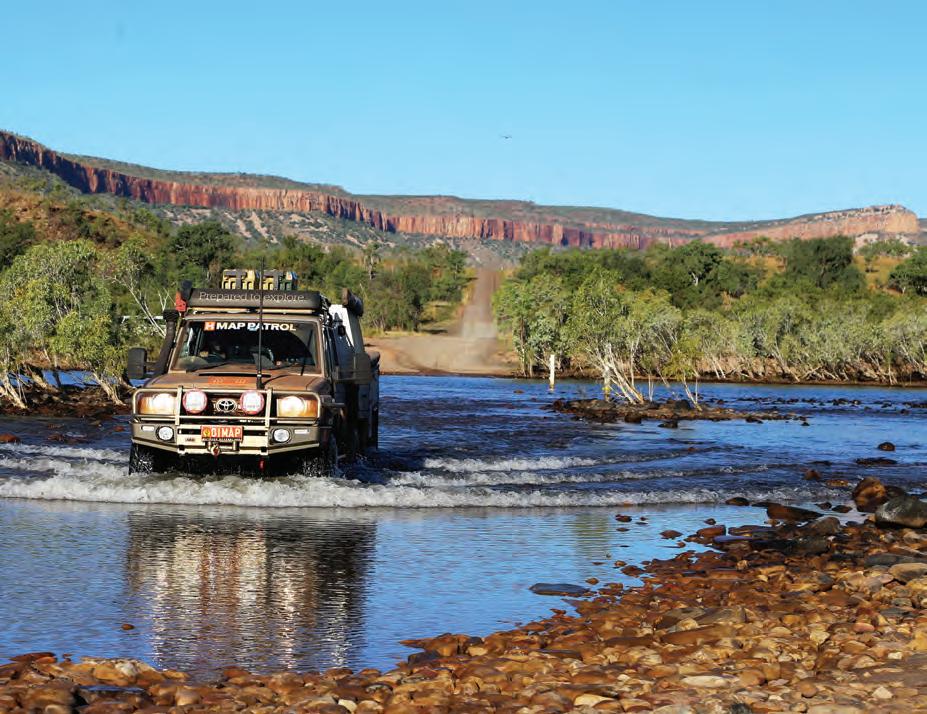





h h H h H h H h H h H h H h H H h H p p p p p p p p p p K K K K K K K K K K K K K K K K K K K ! ! ! ! ! ! ! ! ! ! ! ! ! ! ! ! ! ! ! ! ! ! ! ! ! ! ! ! ! ! ! ! ! ! ! ! ! ! ! ! ! ! ! ! ! ! ! ! ! ! ! ! ! " " " " " " " " e For more detail see Hema's The Kimberley map L L L L L L L L L L L L L L L L Old H a ls C k T k L L L L L 7 8 9 10 10 11 13 16 16 16 17 18 8 18 21 24 24 34 40 42 45 58 60 61 74 105 Oombulgurri ALT Doon Doon ALT Tableland Pvt. NR Ngamoowalem Conser Parry Lagoon Nat. Res. Dunham Pilot Dam Ellenbra e Creek k Grimwood Cr e ek Ca b b a g e T ree kC B r i ll C r eek Nugget Ck Horse Ck Cockburn Ck Blackfe l low C r eek hap man R i ver Macphee Ck West Arm Ord R . D u r a c k Riv e r .R Bindoola Creek D a m p e r C r e e k E ll e nbrae Creek Roysto n Ck River P e ntec o s t King R Ullinger Sa l m o n d River Durack R Dillon Spring Alligator Hole Palm Spring t t t ford ford ford ford ford Cam p b ellCk ford ford ford ford ford ford ford ford Mantinea Scotty-Salmond Gorge The Gut Moonshine Gorge Salmond Gorge Bick Pocket Grimwood Gap Palmer Pass Carl Neal Knob 425m Mount Harrison 341m Pivot Hill 40m New York Jump Ups 364m Leake Hills 70m Gemini Hills 490m Mount Beatrice 400m Pompeys False Mt Cockburn 450m Dunham Hill 346m Gap Point 170m Mount Throssell 450m Mt Edith 280m Steere Hills 250m Mount Todd 440m Bald Hill 390m PentecostRange Tie r Range Cockburn Ranges O'DonnellRange R a g g e d R a n g e C Saw Ranges B l u f f F a c e R a n g e D u r a c k R a n g e Balanggarra Wilinggin IPA Miriuwung-Gajer (Western Austra W a n ji n a W u n g g u r r W i l i n g g i n N a t i v e T i t l e D e t e r m i n a t i o n N o 1 B alan ggarra Mi riuwun Balanggarra IPA W ilin gg in IPA A A 1 A A 1 Permit qeR u r e d Private No Pub lic Ac c ess dlO Kurunjie Road C a r nos River Track El Q u e s t r o R d Parry Mccard e Road Gibb Road Gibb River Wyndham Road River MVO G r eat Northern Highway Great Northern Highway 'Home Valley' Home Valley Station: 08 9161 4322 GaC~ p xZEOT B 'The Diggers Rest' Ph: 08 9161 1029 ac ~ pE T 'Ellenbrae' Ph: 08 9161 4325 ac p ZE T 'El Questro' Fuel Ph: 08 9161 4318 8ac E JO T 'Goose Hill' 'Karunjie' 'Durack River' (abandoned) Wyndham Fuel Ph: 08 9161 1281 IM8G2 a C0ZEO T dner Plat ea u Kimbe rl ey Woolah Wuggubun Guda Guda/Nine Mile 'Doon Doon Roadhouse' Doon Doon Roadhouse: 08 9167 8004 :GCEO T Mandang , 3B Maggie Creek 0 Emma Gorge Resort Ph: 08 9161 or 1800 837 168 GaEO T Cockburn R Cockburn Range ] ] ] R Bindoola Falls Aboriginal Rock Art Site Tier Gorge Chamberlain Gorge El Questro Gorge Amalia Gorge Marlgu Billabong Prison Boab Tree Pioneer Cemetery Telegraph Hill The Grotto Durack Tree Zebedee Springs Emma Gorge Bradley's Billabong Galjiba The Big Crocodile Explosion Gorge Take to see the It's a popular is a beautiful in the r The camping y Kununurra Home to an abundance of birds and other wildlife. Go to Kelly's Knob Lookout for panoramic views of the Ord River irrigation area. A number of outlets display diamonds from the Argyle Diamond Mine. Kununurra Visitor Information Centre, ph (08) 9168 1177, www.visitkununurra.com y Wyndham See the big crocodile sculpture. Wyndham Port's main street has many original buildings, and there is interesting history in the wharf area. Go to Five Rivers Lookout for views over Cambridge Gulf. Wyndham Visitor Information Centre, ph (08) 9161 1281 y Home Valley Contact Home Valley for permission to visit Bradley's Billabong, Bindoola Falls, Gemma's Waterhole or Pope's Pool. y Durack River Homestead Durack River Homestead was destroyed by floods in February 2002, and Jacks Waterhole is no longer accessible to the public. To Warmun/Turkey Creek V 0510 km © Hema Maps 2018 For over 30 years, the Hema Map Patrol has traversed Australia to capture the most accurate cartographic information for outdoor explorers. Hema's master map-makers then produce industry-leading maps, atlases, guidebooks and digital navigation products. Hema products are available at leading outdoor retailers or www.hemamaps.com.au Prepared to explore. Detailed 4WD tracks National parks Camping areas GPS surveyed roads and tracks Tourist info 15th Edition Featuring the Gibb River Road The Kimberley Iconic Map Waterproof Paper By explorers, for explorers
We Love Photography

Thereal estate salespeople are always telling us that we should look for, "Location, Location, Location". Dedicated 4W drivers change that a littlelooking for "Vacation, Vacation, Vacation". Guess which group are happier … Well, you can share in the happiness by just looking at this magnificent shot made by Bede Anderson at the Pinnacles here in Western Australia. It has all the ingredients that a landscape photographer - particularly a dedicated 4W driving onecould hope for:

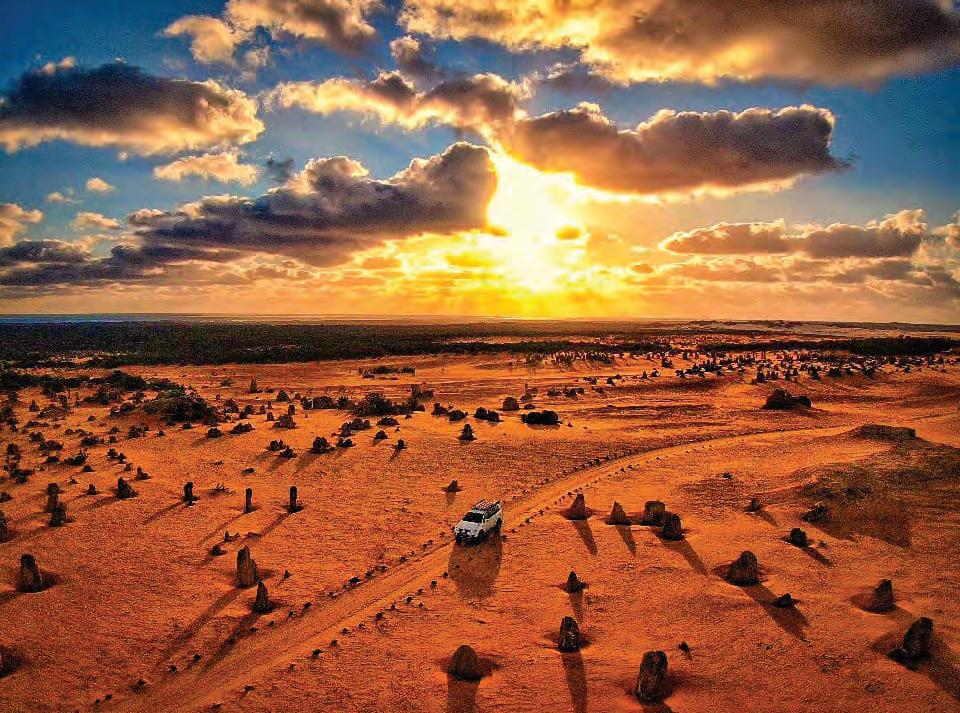
a. Location. How lucky we are to have a great tourist spot so close to our metro area - at a distance that we can drive in 2-3 hours - but far enough away that it is not swamped by other visitors. Oh, there’ll be
other sightseeing parties as this is a plies for coaches, but if you’re clever like Bede, you’ll either get there before they do or stay there after they leave.

b. Timing. Whether it’s to be sun-up or sundown, you’ll get more spectacle (from a pinnacle…) when the light is closer to the horizon. Mid-day is broad, flat lighting.

c. Lighting. The extremes of the day can bathe you in yellow or orange light. Some people used to compensate for this in the film era with graded filters - blue and

Well done Bede,
you’ve
won A $200 GIFT VOUCHER from
CAPTURE THE MOMENT with UNCLE DICK STEIN BEDE ANDERSON - THE PINNACLES, W.A. !! ! ! ! ! ! ! ! ! ! ! ! ! ! ! ! ! ! ! ! h H h H h H h h H h H p p p M K K K K K K K K ! ! ! ! ! ! ! ! ! ! ! ! ! " " " L L L L L 7 16 20 31 39 75 46 Ngamoowalem Conservation Park OrdR. La ke Ar gy le D unham R. Lily Vale Bore t t t t ford ford ford Mantinea Flat Carlton Gorge Buttons Gap Carlton Plain EvelynRange Optic Hill 170m Grits Peak 120m House Roof Hill 330m Mount Chambers 340m Mount Evelyn 411m Sugarloaf Hill 130m Carr Boyd Ranges Deception Range Carr Boy d Rang e s Balanggarra uwung-Gajerrong ralia) M i r i u w u n g G a j e r r o n g ( W e s t e r n A u s t r a l i a ) riuwun g Ga jer r on g A A Pr ivate Creek Road Carlton Hill Road Victoria Highway 'Durack Family Homestead' 'Carlton Hill' 'Ivanhoe' Mandangala Kununurra Visitor Centre: 08 9168 1177 i,M3 : LG2a C q pxZ ] EJ OT B Zebra Rock Gallery Black Rock Falls Valentine Springs Rockhole Middle Springs Molly Spring Galjiba Waringarri Aboriginal Arts y Lake Argyle e a boat cruise or scenic flight the immense, man-made Lake Argyle. popular spot for water activities and there beautiful wetlands area. See the museum eplica Durack family homestead. The Lake Argyle Resort offers camping and accommodation options. Ph (08) 9168 7777 www.lakeargyle.com To Timber Creek Western 4W Driver #118 177
grey were the favoured colours. But here Bede has realised that the warm tone is so evocative that no fiddling should be done.
d. Framing. This picture looks down on the Pinnacles - in an area that doesn’t have tall structures. So I’m calling either a drone shot, a long ladder, or Bede is taller than most of us. Massive respect for this decision to use the drone - it is the ideal decision for the shot and a safe place to fly it.
e. Position. Shooting into the sun behind cloud with both the vehicle and the sun at the optimum 1/3 position has worked perfectly. If this image can be cropped
to a portrait mode, it would make a great magazine cover.
Too many times we’ve seen the Pinnacles shots taken to make them look massive - enormous structures looming up like a Mad Max movie set. That’s artistic, but not accurate. Also clichéd.
I think Bede has done a far better job of accurate representation, and the thoughtful photography is still spectacular. Great Western Australian scenery just needs to be seen for itself - so get out there and look.
Send us a photo for some tips and you could win a $200 Voucher! from

Email photos to: admin@western4wdriver.com.au or submit via our Facebook page
PHOTOGRAPHY Tips & Tricks
Tripods Are Old School

So are 4WD vehicles, friend, and old schools of thought and action sometimes produce the best results.
If you are travelling thousands of kilometres to take spectacular pictures, wouldn’t it be great if you could ensure that the results were sharp? Not just sortof in focus, but tack-sharp? Think old, three-legged school.
Optical studies have been done by pros shooting their best cameras and lenses at their best hand-held speeds and even if they are helped by modern circuitry and shooter’s hands, they still never equal the results achieved on a tripod.
Of course the tripod itself has to be set firmly on a steady surface, so no good trying on the deck of a ship or soft sands. You are trying to connect to bedrock
somehow with a small platform that doesn’t move.

Pick a metal tripodas large as you can conveniently carry. Remember that you may have to hike with it - not just transport it in your vehicle. Pick one with a good locking head. Keep it free of sand and corrosion. WD40 is a good tip, done in moderation.
If you are forced to use beach space for your setup throw down three pieces of cardboard or a carpet square as a landing field for the tripod legs. If you have the luxury of turf and steel spikes, use them. Lock that baby down.
Finally - shield the tripod setup from strong winds - they can erase the sharpness advantage if the exposure is long.
178 Western 4W Driver #118
THE TRAVELLING PHOTOGRAPHER
with UNCLE DICK STEIN

Lemme Show You
There is a basic human need in all of us - the need to show someone something. Even if it is just the basic business of pointing at someone on the bus, we’ve all done it. Of course there is a difference between a child shouting, “Look, look!“ and a curated photographic exhibition in a major gallery, but that difference generally boils down to the child being told that pointing is rude and the international superstar photographer being given a glass of champagne and a fat cheque. It all depends on who you point at. This aside, the topic of illustration is what we want to show you. We’ll illuminate it. That, folks, is the crux of the thing. Illumination. You have to have enough light on a subject for people to see it. No good retreating into dim swirls and artistic shadows. People can get those in the garden shed and they generally spray Mortein before them as they go. If you are going to show pictures, you have to have pictures that are bright enough to be seen. This was not always the case. In the dear old 1970s there was a photographic genre of grunge. No end of horrid monographs were turned out of North America and Europe showing the dim degradation of life and banal pictures of garbage. You can pick these up cheaply at secondhand bookstores but if you do, use tongs. The pictures were muddier than the subjects and the lighting muddiest of all.
Not you. Not now. Not here. You’re a Western 4W Driver and you go amongst some of the brightest and most spectacular scenery in the world. Don’t make it dim if it started out bright.
Set your camera properly - and accept that it will probably set itself if you do not interfere. If you are looking into a coalhole of a cave, set the compensation to lighten the thing - if you are looking into a Kosciuszko blizzard, set it to show the brightness. But however you set it, get light onto the subject.

Sometimes the natural light is strong enough to do all you need. We remember the backyard photo of the family under the Hills Hoist with the sun at the photographer’s back. The people might be squinting, but you can see them. You can do better, but you still have to let the sun and the natural sky light fall on the subjects.
If there is no sun, or little light, consider a flash. It’ll look artificial in some circumstances and natural in others. There is a whole science and art that transitions from one to the other. But a fake-looking photo of something you can see is altogether better than a natural picture of something you cannot.
Reflectors are also a good thing to use. They need no battery, consume no power, and synch with any standard shutter. You need someone to hold one or some way to position it yourself, but it is the natural alternative to an electronic flash.
Western 4W Driver #118 179






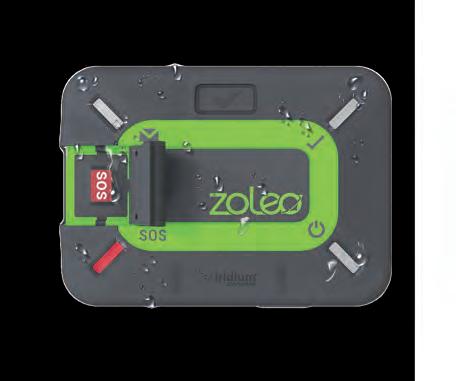
“Help! I’m stuck in the middle Messaging App-to-app, SMS or email family & friends via the ZOLEO App SOS 24/7 SOS monitoring services, with GPS location and 2-way response Check-in Quick and easy press, to let others know where you are and you’re OK Weather Get up to date 5-day forecast for your location Broken down? No mobile coverage? No worries! Meet ZOLEO* * Active subscription plan required to transmit messages over the Iridium satellite network. COMPATIBLE WITH ANDROIDzoleo.com.au



Western 4W Driver #118 181
CAN YOU AFFORD TO TRAVEL AUSTRALIA WITH YOUR KIDS?

If you have kids and love camping, travelling Australia with them must have crossed your mind. Along with that thought was probably that you could not afford it. Well, read on and I might just persuade you otherwise.

IamMandy Farabegoli and I run the website www.travellingaustraliawithkids.com encouraging families to take a few weeks, months or years and travel our amazing country.
I'm often asked how people can afford to travel Australia with their kids, and I always reply with, "Can you afford to have children?" I mean, frankly, if you totalled up all the costs over the years, you’d think you couldn’t afford them either BUT you do have them, so bear with me!
“Do not wait, the time will never be ‘just right’. Start where you stand and work with whatever tools you have at your command.”
George Herbert
Options
You can make it work and here are some thoughts on how. Of course, it all depends on how long you intend to be away.
Let’s assume for this article that you will take a year to do a lap of the country. Remember some of the expenses will be similar to those that you spend at home, i.e. you still buy food whether you're at
182 Western 4W Driver #118
now we're tawking!
home or away and you still may pay for accommodation costs at camp sites which is like paying for rent or a mortgage.
Some families are choosing to sell their homes to help finance their lap, see where this journey will take them and possibly change their life and location when they settle again. Others rent out their homes for the year and the rent can help to cover cost. Many save like crazy for a year or two and others choose to leave with little in their bank account and work their way around or when needed. They are however ALL making it work, so you can too.
Budget Variables
It also depends on your family and variables:
• How fast you travel – obviously, fuel is a big factor.
• Where you stay on your trip – caravan parks vs free camping.
• The excursions you choose - flying over the Bungle Bungles rather than driving and walking through them, swimming with the whale sharks rather than just snorkelling from the shore on the Ningaloo Reef etc. etc. You can make it work, you just need to work out how

Most of our TAWK families' budgets are ranging anywhere from $500 to $1500 per week. We were around the $1000 mark and we did fly over Kakadu, but we also worked along the way.

We do have a Finance Tracker on our website that you can put in some figures and see how much you might need for your trip and it could help you plan too. There are also some real life budgets from other families that we have documented to give you an idea of how much other families spend and they detail where their money goes, so I encourage you to have a look at those too.

Work on the way
There is a lot of work out there, especially in remote areas, and because many people are travelling our great land instead of going overseas. You will have lots of opportunities to be able to top up your funds and stay a while.
We stopped and worked in Coral Bay for five months on our two year trip. In fact it was hard to leave! But working along the way can really help turn your dream of travelling Australia into a plan. So, get planning!
I will go into this more in the TAWK article in the next edition of the magazine, together with some budget tips from our travelling families.
Until then if you have any questions please feel free to email me at: admin@travellingaustraliawithkids.com
travelling australia with kids - with mandy farabegoli
Western 4W Driver #118 183

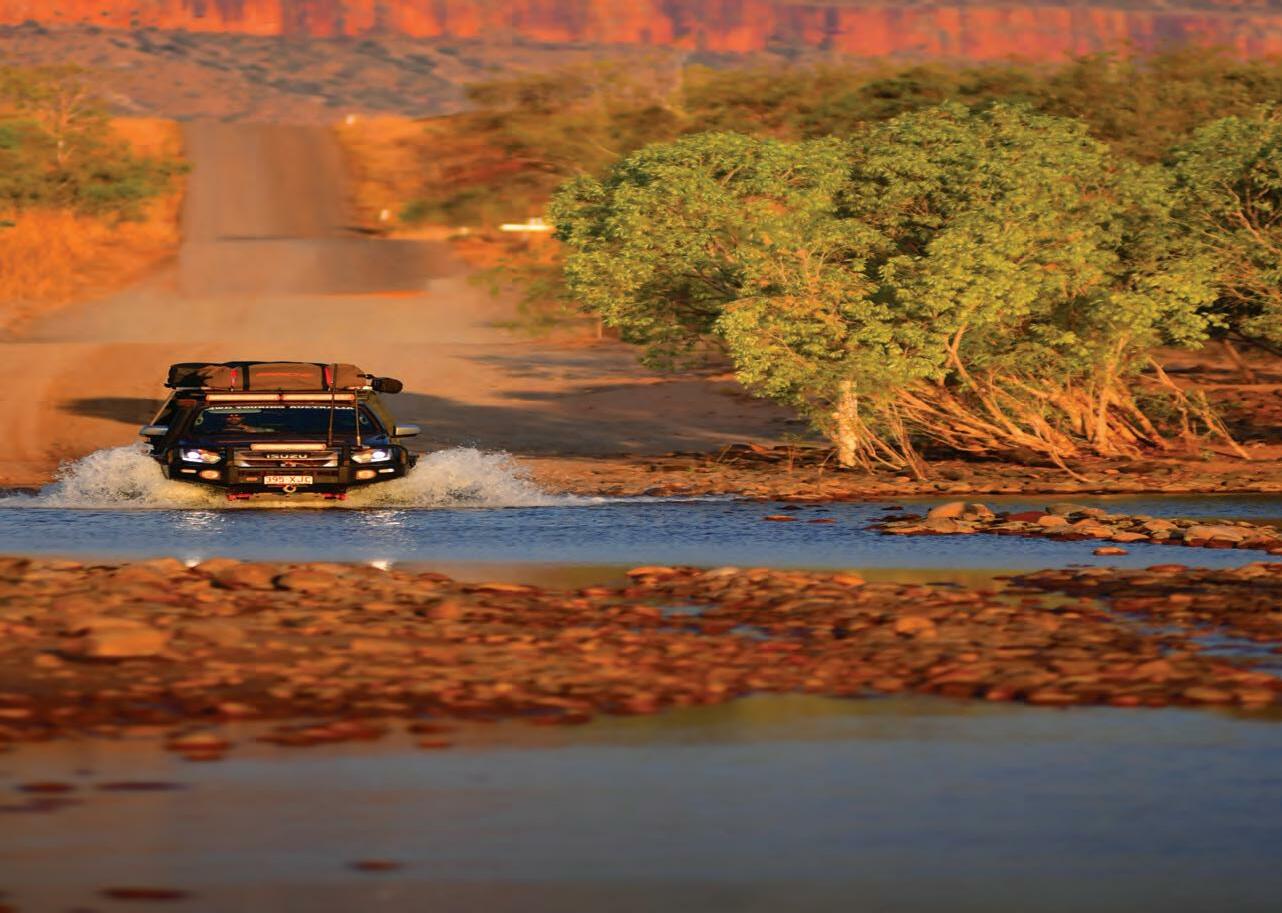


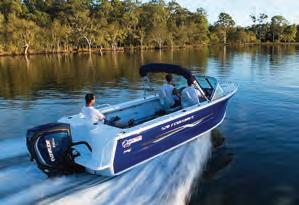
5th - 7th November 2021 McCallum Park, Victoria Park @4wdadventureshows @4wdadventure /Perth4wdAdventureShow GET YOUR TICKETS ONLINE AT WWW.4WDSHOW.COM.AU The Perth 4WD and Adventure Show is operating within government guidelines for a Covid-Safe event
Are we there y et?

Written by kids ... for kids
SOUVENIRS
2. STICKERS


Travelling

and souvenirs kind of go hand-in-hand. But if you travel often and to lots of different places, then your souvenirs can start taking up a lot of room.
Souvenirs are always fun to collect, so here are some ideas that are small and lightweight and will be a great reminder of where you've been.
1. HAT PINS
You can wear them on a hat, jacket or add them to your bag. You can even make a frame for them and hang them as wall art in your home. Or pin them to a map to show where you've been.
Hat pins on a map is a great way to show where you've travelled.
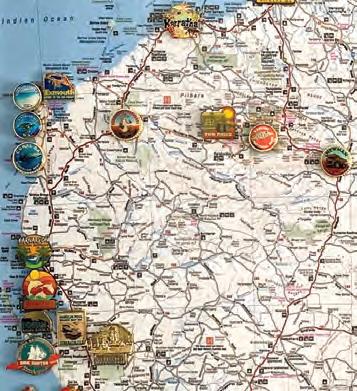
Another great affordable option is stickers. There are so many things you can do with stickers - stick them in a journal or put bumper stickers on your car or camper (with permission of course!)
3. JOURNAL


Keeping a journal of your trips and experiences is a really great way to save all your memories. Try writing what you did each day in a travel journal, or create a scrapbook journal of your trips filled with photos, tickets, writing and more.
4. MAGNETS
Magnets are easy to pack, usually pretty inexpensive, and can be found almost anywhere.

Collect magnets that have the name of the place you are visiting, magnets that have artwork on them, flat magnets or 3D magnets. You don’t have to put them on your fridge either. Find a metal board that you can frame and add your magnets to and turn it into your own work of wall art.
5. POSTCARDS

Postcards are one of the cheapest products being sold in stores and you can buy them almost everywhere.
Collect a postcard from each place you visit and turn it into a postcard journal, book, or use in a scrapbook.
A fun idea is to write something on the back about your travels and mail it home to yourself.
Western 4W Driver #118 185
E M T B H F I C F D N G O S J R H V M A P E A U S T I C K E R M A V K J W D A R T S N L E U P R N X T Q E A S F I K P T A X B C T H A H I O Y I T S G C I E Z M O D G O M F C L R X M N H M N E T J O H I R E L K N I K R O E K W S B Q K V N B N J E C N Y S W V T N H E C Z B A H T G T J G Q X G C E D I P O U N P L K I S S T Z N L Y A O R M A G N E T W D L T D A F O F S G T D S Z M N H A J O A R Q M B W P S C Y T I Y Z R S O I M K S P E J O N J B E P E V B Q U F P B O Y B O O K M A R K V G I K R G U R Z K Z W N G F O C U H L D E N P A B U C Q P Y U A F Q P O S T C A R D W X A R O C K L T E A T O W E L O C P J E X M E T L V Y O X T B R D W P Q K
SOUVENIR word search PUZZLES FOR KIDS Brain teasers 1. Mum and Dad have four daughters and each daughter has one brother. How many people are in the family? 2. What invention lets you look right through a wall? 3. I go in dry and come out wet, the longer I’m in, the stronger I get. What am I? Answers on page 191. ART BOOK BOOKMARK COASTER HATPIN JOURNAL KEYRING MAGNET MAP ORNAMENT PEN POSTCARD ROCK SNOWGLOBE STAMP STICKER TEASPOON TEATOWEL TEESHIRT TICKETS Send us an email or a photo for a chance to win a prize. Email: awty@western4wdriver.com.au Hey kids! Which road leads back to camp? 186 Western 4W Driver #118


















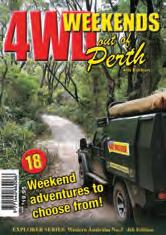




$24.95 Get into remote desert country! $19.95 Discover an ancient landscape! EXPLORER SERIES Western Australia: N 6 PILBARA Explore the in Your 4WD fabulous 4WD adventures in Western Australia’s rugged north-west 20 INCLUDES TRIPSSUITABLE FOR SOFTROADERS $17.95 Go for gold! in the Goldfields of WA 16 amazing Day Trips out of Southern Cross, Coolgardie, Norseman, Kalgoorlie and Menzies EXPLORER SERIES Western Australia No. 4 Second Edition 2nd EDITION RRP RR $ 7 195 795 $19.95 Take the weekend off! $19.95 Have a great day out! $19.95 Explore a wild coast! Take off with our top trip books GREAT GIFT IDEAS! $17.95 Head for the goldfields! MAGAZINE SUBSCRIPTIONS EASY WAYS TO SUBSCRIBE AND SAVE Subscribe online at: www.western4wdriver.com.au or fill in the form over the page and post it to: Western 4W Driver C/- Premium Publishers 26 John Street, NORTHBRIDGE WA 6003 To order back issues go to www.western4wdriver.com.au $39.95 An iconic adventure! Western 4W Driver #118 187
PRINT SUBSCRIPTIONS & ORDERS To subscribe or order online go to www.western4wdriver.com.au NEW SUBSCRIPTION - Starting from: Current edition Next edition RENEWAL I am paying by: CHEQUE CREDIT CARD Magazine Subscriptions Postage included within Australia Total $ Western 4W Driver 4 issues (1 year) $34.00 Western 4W Driver 8 issues (2 years) $59.50 Trip Books *Plus postage See postage costs below Qty Total $ Holland Track & Cave Hill Woodlines $17.95* 4WD Days out of Perth $19.95* 4WD Weekends out of Perth $19.95* 4WD Days in the Goldfields of WA $17.95* 4WD Days on the South Coast of WA $19.95* Explore the Pilbara in your 4WD $19.95* Hanns Track $24.95* Canning Stock Route $39.95* Postage costs for trip books: 1 book - $3.00 2 books - $6.00 3-8 books - $10.00 Postage $ Total $ Name Address Suburb State Postcode Email Phone DELIVER TO: Name on card Credit card Expiry / CVC Contact phone no. VISA or MCard only CREDIT CARD DETAILS: To order and pay online via credit card or PayPal, go to www.western4wdriver.com.au Make cheques payable to Premium Publishers Post to: PO Box 50, Northbridge WA 6865 Phone: (08) 9291 8303 188 Western 4W Driver #118
NAME
Police, Fire, Ambulance
Police WA
Fire WA
Ambulance WA
Royal Flying Doctor Service WA
Royal Flying Doctor Service QLD
Royal Flying Doctor Service NSW/ACT
Royal Flying Doctor Service SA
Royal Flying Doctor Service NT
Main Roads WA
State Emergency Services (SES)
Helpline
of Meteorology
hour
hour
ONLY 000
assistance 131 444
133 337
NUMBER
assistance (08) 9334 1222
emergency 1800 625 800 Sat phone: 0011 61 8 9417 6389
emergency 1300 69 7337
hour medical & emergency (08) 8088 1188
hour
hour
emergency 1800 733 772
& emergency
Central Australia: 1800 167 222 Top End/Darwin: 000
conditions 138 138
132 500
(08) 9474 9055 office hours only
1300 659 210
13 11 14
13 11
INFORMATION PHONE
EMERGENCY
Non-urgent
Non-urgent assistance
Non-urgent
24
medical &
24
medical &
24
24
medical &
24
medical
Road
Natural disasters & emergencies
Wildcare
For injured wildlife
Bureau
(BoM) National weather warnings
Lifeline Crisis support & suicide prevention
RAC Roadside assistance
11 Emergency Contact PHONE NUMBERS KEEP ME HANDY! Below are the main UHF channels being used in Australia detailing each channel’s main use. To download the full list, register for the Members Only section at: www.western4wdriver.com.au 80 CHANNEL UHF INFORMATION Channel: Frequency: Use: Channel Spacing: CH 10 476.6500 Simplex - 4WD Drivers - Convoy, Clubs & National Parks 12.5 KHz CH 11 476.6750 Simplex - Call Channel only 12.5 KHz CH 18 476.8500 Simplex - Caravan & Campers Convoy Channel 12.5 KHz CH 29 477.1250 Simplex - Pacific Hwy (NSW) & Bruce Hwy (Qld) Road Channel 12.5 KHz CH 30 477.1500 Simplex - UHF CB Broadcasts 12.5 KHz CH 40 477.4000 Simplex - Highway, Truckies & Roadworks Channel 12.5 KHz To download a printable copy of this information, register for the Members Only section at: www.western4wdriver.com.au Western 4W Driver #118 189
Proudly sponsored by

It's good for the
We are not really sure if Patrick James was attempting to give his Paj a mud treatment or had believed the sales hype that these short wheel base models will float over anything, but the proof is in the (mud) pudding. For his efforts in 'parking' his Mitsi in the mud, Patrick has scored himself a set of the original and best Maxtrax from our mates at Maxtrax.
How you get stuck is your business. How you get out is ours. Now you can take the easy way out with Maxtrax. Get your pic in to win this great prize or, if you can’t wait, go to www.maxtrax.com.au to learn more.


KEEP ‘EM COMING FOLKS. All you need is a potentially funny situation,
good sense
humour and of course,
camera. Email your silly snap to:
complexion
a
of
your
admin@western4wdriver.com.au or Facebook: www.facebook.com/western4wdriver
Silly NAPS 190 Western 4W Driver #118
ACCOMMODATION Queen of the Murchison 100 BATTERIES/BATTERY SYSTEMS C-Tek.......................................................................... 52 iTechworld ....................................................... 192-IBC BRAKES Bendix Brakes 43 BOLLARDS Ramguard Bollards 92 CAMPERS/CARAVANS & TRAILERS Explorex Caravans ................................................. 92 Off Road Equipment .............................................. 118 CAMPING SUPPLIES A247 8-9 ARB IFC-1 Travel Buddy Ovens 125 COMMUNICATION Goldfields Off Road................................................ 58 Performance Tuning ............................................. 143 Zoleo.........................................................................180 ELECTRONICS Camera Electronic 147 Performance Tuning 143 Wanderlust 131 4WD PARTS & ACCESSORIES A247 8-9 ARB ........................................................................ IFC-1 Fourby Fitouts ........................................................ 123 Goldfields Off Road................................................ 58 Ironman 4x4 ............................................................ 2-3 Maxtrax 93 Medicar Automotive Solutions 29 Midland 4WD Centre 101 Milford 124 Narva 61 Off Road Equipment 118 Opposite Lock ......................................................... 115 Supafit Seat Covers ................................................ 31 TJM ............................................................................. 85 Tyrepliers ................................................................. 168 MAGAZINES Western Angler 148 MAPS & NAVIGATION Hema ........................................................................ 176 MECHANICAL SERVICE, REPAIRS & REPLACEMENT Goldfields Off Road 58 Medicar Automotive Solutions 29 Turbo Tech 83 United Fuel Injection 69 MOTOR VEHICLES Nuford Wangara ..................................................... 53 Toyota .................................................................... OBC PERFORMANCE PRODUCTS Performance Tuning 113 Responsive Engineering 19 Turbo Tech 83 United Fuel Injection 69 PHOTOGRAPHY Camera Electronic ................................................. 147 Wanderlust ............................................................... 131 POWDERCOATING Metal Works Perth 92 TRAINING & TOURS Bob Cooper Outback Survival 154 Kimberley 4x4 Tours 57 SUPPLIER DIRECTORY BRAIN TEASERS ANSWERS 1. Seven (each daughter has one brother, that means there’s only one brother + 4 daughters = 5 + Mum and Dad = 7.) 2. A window. 3. A teabag. Your quick-find reference to products and services in Western 4W Driver Western 4W Driver #118 191
NO MORE JUMPER LEADS
West Australian, family-owned and operated company iTechworld, has been at the forefront of lithium storage batteries and lithium jumpstarters for the last 14 years.

The JS80 is iTechworld's new flagship lithium powered jumpstarter. The JS80 has been designed and developed in Perth and it utilises an ultra-safe design that prevents user error. With no less than seven safety features, including spark-proof technology and reverse polarity protection, the JS80 is the intelligent, secure, and straightforward way to start any car or 4wd on the market.
The primary function of the JS80 is to jump-start a vehicle with a flat battery with minimum fuss and without relying on a second vehicle. The JS80 will hold its charge for six months and sit happily in a glove box awaiting use. Using the JS80 to start a car is as simple as one two three. One, connect the HD clamps to the JS80. Two, connect the clamps to the battery and press the jump-start button. Three, start the vehicle. The JS80 is so powerful it can jump-start any car or 4wd you can find, utilising its immense 3,000 amp output.
The secondary function of the JS80 is to provide a portable power supply. The JS80 has two quick-charge USB ports and one USBC port that charge mobile devices like smartphones, tablets, laptops, and more. The JS80 has a 12v output, allowing 12v appliances to run directly from the jump starter, such as tyre compressor pumps, 12v fridges, 12v lights, and much more. The JS80 has pass-through charging, which allows the JS80 to charge and discharge at the same time.
Everyone should have a JS80 in their glove box. Whether you are using it to supplement your power needs on a camping trip or if you are using it as an emergency device for when you have a flat battery, the iTechworld JS80 is the one-stop device for you.
Now $359
JS80 3000Amp Jump Starter Offer valid until the 18th of July
Normally $449 Use discount code: 4WD20








































































 Our skipper, Cal at the wheel.
Our skipper, Cal at the wheel.



 Not bad for a first-time barra catch.
Not bad for a first-time barra catch.




 Ready to take a dip in another secluded pool.
We found waterfalls everywhere we went.
Ready to take a dip in another secluded pool.
We found waterfalls everywhere we went.











 Kununurra's birdman extraordinaire, Greg Postle creating birdlife so real it could fly off the canvas.
A gap in the stratified Mirima National Park frames Kununurra townsite.
Kununurra's birdman extraordinaire, Greg Postle creating birdlife so real it could fly off the canvas.
A gap in the stratified Mirima National Park frames Kununurra townsite.





 Argyle sunset reflected in the cruise boat windscreen.
A Kimberley bush camp to die for.
Cobbler from the Ord and well up thebank to avoid the snapping handbags.
Argyle sunset reflected in the cruise boat windscreen.
A Kimberley bush camp to die for.
Cobbler from the Ord and well up thebank to avoid the snapping handbags.








 My intrepid guide encourages me across croc-filled murky depths in Tunnel Creek.
Gratefully out the other end where Jandamarra (Pigeon) met his.
Devonian reef erosion forms some wonderfully weathered remnants.
My intrepid guide encourages me across croc-filled murky depths in Tunnel Creek.
Gratefully out the other end where Jandamarra (Pigeon) met his.
Devonian reef erosion forms some wonderfully weathered remnants.




 Never take your eyes off a crocodile.
A boab in sunset silhouette.
Never take your eyes off a crocodile.
A boab in sunset silhouette.




















 By Jon Love
By Jon Love





 Peaking the hill overlooking Reef Beach and getting a glimpse of things to come.
Peaking the hill overlooking Reef Beach and getting a glimpse of things to come.














 Photo: Marc Rowley
Photo: Marc Rowley
 By Benedict Smith
By Benedict Smith











 Arkana Troopy.
Photo: Josh Melville
Arkana Troopy.
Photo: Josh Melville










 Prado tippy-toe at Yakka Ridge.
Prado tippy-toe at Yakka Ridge.














 Forrest's fort at Well 9 on the CSR.
Photo: G and D Sweetman
Forrest's F50 blazed tree at Mt Moore.
Forrest's fort at Well 9 on the CSR.
Photo: G and D Sweetman
Forrest's F50 blazed tree at Mt Moore.

 Forrest's F51 blazed tree.
Forrest and Well's F52 blazed tree.
Forrest's F51 blazed tree.
Forrest and Well's F52 blazed tree.

 Forrest's F59 blazed tree.
Windich Rockhole.
Forrest's F59 blazed tree.
Windich Rockhole.

 Mt Allott plaque.
Photo: Alan McCall
Mt Allott plaque.
Photo: Alan McCall


 Alexander Spring.
Local resident.
Alexander Spring.
Local resident.



 Travelling solo means no noisy neighbours to contend with.
Travelling solo means no noisy neighbours to contend with.


 Something we came across during one of our trips.
Something we came across during one of our trips.




 You might only use it once on a trip, but you’ll be glad you’ve got it if you need it.
You might only use it once on a trip, but you’ll be glad you’ve got it if you need it.









 Image 1 - Narloo Homestead.
Image 2 - Narloo Homestead (light painted).
Image 1 - Narloo Homestead.
Image 2 - Narloo Homestead (light painted).

 Lake Norring.
Lake Norring.



















 Wet entry to 14 Mile Warroora Station.
Camping like sardines at Warroora Station.
Wet entry to 14 Mile Warroora Station.
Camping like sardines at Warroora Station.


 Towing onto Lefroy Bay, Ningaloo Beach.
Magic campsite at Ningaloo Station.
Towing onto Lefroy Bay, Ningaloo Beach.
Magic campsite at Ningaloo Station.


 Marble-like rock walk near Chearie Pool.
Marble-like rock walk near Chearie Pool.


























 Moir Homestead ruins.
Western
Moir Homestead ruins.
Western










 Andrew Fardon.
Andrew Fardon.
















 Stone arrangements and dancing path at Calcalli.
Photos: Paul Kennedy
Stone arrangements and dancing path at Calcalli.
Photos: Paul Kennedy

 Calcalli caves.
Calcalli caves.


 Reflections at Pinpi Rockhole.
The Ives brothers' plaque at Pinpi Rockhole.
Reflections at Pinpi Rockhole.
The Ives brothers' plaque at Pinpi Rockhole.










 Charles Stansmore. Photo courtesy David Carnegie
Charles Stansmore. Photo courtesy David Carnegie

































 My patch of paradise - the overnight camp.
Approaching the natural staircase.
My patch of paradise - the overnight camp.
Approaching the natural staircase.





































































 Roller drawers are a great way to maintain accessibility.
Roller drawers are a great way to maintain accessibility.



























 ARB's new store at Cockburn Central.
ARB's new store at Cockburn Central.













 By Scott Burridge Community Services Coordinator, Kunawarritji Community W.A.
By Scott Burridge Community Services Coordinator, Kunawarritji Community W.A.






 BY CHRIS MORTON
BY CHRIS MORTON
















































